General Dynamics Itronix IX-WT11 IX-WT11 User Manual Users Guide
General Dynamics Itronix Corporation IX-WT11 Users Guide
Contents
- 1. User Manual
- 2. Users Guide
Users Guide

General Dynamics Itronix | 72-0138-001
GD3080 User Guide

General Dynamics Itronix | 72-0145-001
GD3080 User Guide
Table of Contents
Notices and Safety .................................................5
Copyright Notice .................................................. 5
Disclaimer ............................................................. 5
Trademark and Patent Notice ............................ 5
Compliance Statements ..................................... 5
Compliance Statement for Canada ................... 6
Safety Information .............................................. 7
Service and Upgrade Safety and Precautions .................... 7
Battery Pack Safety and Precautions ................................. 8
Getting Started..........................................................9
Unpacking Your System ..................................... 9
Standard Parts ..................................................................... 9
Standard Features ............................................................... 9
Optional Accessories .......................................................... 9
Where to Look For Information .......................................... 9
Precautions ......................................................... 10
Startup Problems .............................................. 10
Best Practices for the GD3080 ......................... 10
General Daily Operations .................................................. 10
Tips for New Owners .........................................................11
Power Management ......................................................... 12
File Management .............................................................. 12
Battery Charging ............................................................... 12
Storage .............................................................................. 12
Troubleshooting ................................................................. 13
Front View .......................................................... 14
Getting Familiar ...................................................... 14
Left Side View .................................................... 15
Right Side View .................................................. 15
Top Edge View ................................................... 16
Bottom Edge View ............................................. 16
Back View ........................................................... 17
Buttons and Hot Keys ....................................... 18
FN and Hot Key Combinations ......................................... 19
Programming Hot Keys ..................................................... 19
Power Button .................................................................... 20
RF ON/OFF Button ........................................................... 20
Master Reset Key ............................................................. 20
LED Status Indicators ........................................ 20
Display and Pen Basics ..................................... 21
Using the Pen / Stylus ....................................................... 21
Changing the Display Orientation ..................................... 21
Calibrating the Display ...................................................... 21
Ambient Light Sensor ....................................................... 21
Adjusting Screen Brightness ............................................ 22
Ports and Connectors .......................................22
Disk Drives .......................................................... 23
The Hard Disk Drive (HDD) ............................................... 23
Card Slots .......................................................................... 23
Optional External Drives ................................................... 23
Precautions for Handling DVDs and CDs ......................... 23
Computer Security ............................................ 23
Security Slot ...................................................................... 23
Passwords ......................................................................... 24
Fingerprint Scanner (Optional) .......................................... 24
Stealth Mode ..................................................................... 24
Trusted Platform Module (TPM) ....................................... 24
Making Connections .............................................25
Attaching Power ................................................ 25
Attaching the AC Adapter ................................................. 25
Turning the GD3080 On and Off ...................................... 25
Ethernet ............................................................... 25
Internet and Fax ................................................. 25
Attaching USB Devices ..................................... 25
Using PC Cards .................................................. 25
Installing a PC Card ........................................................... 26
Ejecting a PC Card ............................................................. 26
Using Compact Flash Cards ............................. 26
Installing a Compact Flash Card ....................................... 26
Ejecting a Compact Flash Card ......................................... 26
Audio ................................................................... 26
Changing the Volume ....................................................... 26
Attaching to the Desk Mount ........................... 26
Wireless Communication ....................................27
Turning Off Radios with the Radio On/Off Button ........... 27
Bluetooth Radio (optional)................................ 27
Read About Bluetooth ...................................................... 27
Electromagnetic Interference (EMI) ................................. 27
When to Use Landline Communication ........................... 27
WLAN Radio (optional) ..................................... 27
Read About WLAN ........................................................... 27
GPS (optional) .................................................... 27
Battery Power .........................................................28
Battery Installation and Replacement ............ 28

General Dynamics Itronix | 72-0145-001
GD3080 User Guide
Table of Contents
Installing the Battery ......................................................... 28
Replacing the Real Time Clock Battery ............................ 29
Battery Calibration ............................................29
Windows® Level Battery Calibration ............................... 29
BIOS Level Battery Calibration ......................................... 29
Battery Charging ...............................................30
Using the Battery ...............................................30
About the Battery .............................................................. 30
Monitoring Battery Power ................................................ 30
Low Battery Alarms .......................................................... 30
Managing Power................................................ 31
Low-Power States ............................................................ 31
Entering Low-Power States .............................................. 31
Battery Tips ........................................................ 31
Tip 1. Avoid Excessive Heat and Cold .............................. 31
Tip 2. Prevent Wasted Power ........................................... 31
Tip 3. Calibrate Your Battery ............................................. 32
Tip 4. Get a Good Charge ................................................. 32
Tip 5. Prevent Data Loss ................................................... 32
Tip 6. Clean Terminals ....................................................... 32
Tip 7. Storing Batteries ...................................................... 32
BIOS Setup Utility ..................................................33
Starting the BIOS Setup Utility ........................33
Navigation and Help..........................................33
The Menu Bar ................................................................... 33
The Field and General Help Windows .............................. 33
Tablet PC Input Pad ........................................................... 34
The Main Menu .................................................. 35
The Advanced Menu ........................................ 35
Trusted Computing ........................................................... 36
SuperIO Configuration ...................................................... 36
Fan Learning Function ....................................................... 37
Stealth Mode Setup ......................................................... 37
Extended Configuration .................................................... 38
Radio Configuration .......................................................... 39
The Boot Menu ..................................................39
The Security Menu ............................................40
The Exit Menu ................................................... 41
Maintenance and Storage ..................................42
Battery Maintenance and Storage .................. 42
Maintaining Batteries ........................................................ 42
Storing Batteries ................................................................ 42
Tablet PC Maintenance and Storage............... 42
Maintaining Your Tablet PC ............................................... 42
Care and Cleaning ............................................................. 42
Storing Your Computer ..................................................... 42
Data Backup .......................................................43
Optional Equipment ............................................... 44
Second Battery ..................................................44
Attaching a Second Battery .............................................. 44
Desk Mount ........................................................44
To use the desk mount: .................................................... 45
To detach the desk mount: ............................................... 45
Memory Upgrade ..............................................45
Inserting a Memory Card .................................................. 45
Surge Protection ................................................45
Selecting the Right Surge Protection ............................... 45
Surge Environment ........................................................... 45
Type of Equipment to be Protected.................................. 46
Quality of Electrical Wiring and Service ........................... 46
Equipment Selection ......................................................... 46
Service and Support ..............................................47
Client Care Center (CCC) ................................... 47
Product Support - Downloads ......................... 47
Troubleshooting .....................................................48
For More Help ................................................................... 48
Applications ......................................................48
My application locks up, acts strangely, or produces a Gen-
eral Protection Fault (GPF) error ........................................ 48
To restart your computer: ................................................. 48
Communications programs don’t seem to work or they lock
Windows® ........................................................................ 48
When I rotate the display to portrait orientation my application
does not work or does not display correctly .................... 48
Batteries ..............................................................48
The battery does not charge ............................................. 48
The batteries take much longer than seven hours to charge
48
The batteries don’t last very long ..................................... 48
The gas gauge isn’t full after charging the battery ........... 49
The gas gauge reads “full,” but the charging indicator light is
still lit .................................................................................. 49
My battery seems to have less and less capacity ........... 49
Hard Disk ..........................................................49
The hard disk will not spin up so the computer can’t boot up
49

General Dynamics Itronix | 72-0145-001
GD3080 User Guide
Table of Contents
I can’t save files because the disk is full .......................... 49
Disk Read Error ................................................................. 49
Hard disk recovery ............................................................ 49
Landline Modems ............................................49
The modem doesn’t work ................................................ 49
The modem doesn’t dial a number .................................. 49
The modem dials and receives an answer but does not
establish a connection ...................................................... 49
Communications programs such as HyperTerminal don’t
seem to work or they lock Windows® ............................ 49
The modem dials and the answering modem generates
tone, but our modem does not begin the training sequence
to establish a connection .................................................. 49
Miscellaneous ................................................... 50
The computer shuts off unexpectedly ............................. 50
The speaker volume is too high or too low ...................... 50
The computer won’t turn on ............................................. 50
The computer won’t turn off............................................. 50
The computer enters suspend mode too quickly ............ 50
The computer doesn’t automatically suspend ................. 50
The system date and time are incorrect ........................... 50
I receive an “out of memory” error message .................. 50
Holding down the Power button to reset the computer
doesn’t always work ......................................................... 50
PC Cards ...........................................................50
I can’t remove the PC card ............................................... 50
Disk Read Error ................................................................. 50
The system does not recognize the PC Card CD-ROM when
it is inserted into the PC Card socket ............................... 50
The computer locks up when I remove the PC card ....... 50
Pen / Display ....................................................... 51
When I try to use the pen on my display, nothing happens 51
The display warps or pillows in high humidity ................. 51
The touch screen doesn’t respond after a suspend ........ 51
I cannot change the orientation ........................................ 51
The display performance is slow ...................................... 51
I can’t read the display ...................................................... 51
The underlined, inverse, and hypertext characters are difficult
to read on the screen ........................................................ 51
I can’t see the cursor while using the DOS editor ........... 51
The display appears to have random pixels darkened after
scrolling.............................................................................. 51
I changed my display resolution, but I see no difference on
the screen .......................................................................... 51
The display cuts off the right side of the application or page in
portrait mode ..................................................................... 51
FAQs .................................................................... 51
How do I calibrate the pen/display?.................................. 51
How do I change the main battery? ................................. 51
How do I adjust the speaker volume? .............................. 52
How do I clean the display screen? .................................. 52
How do I change the display screen’s brightness? ......... 52
How do I change the display orientation? ........................ 52
How do I switch between Digitizer and Touch Screen
modes? .............................................................................. 52
How long will the battery last? ......................................... 52
How do I optimize the GD3080 for left handed use?...... 52
Where can I find the user manual? .................................. 52

General Dynamics Itronix | 72-0145-001
GD3080 User Guide
Identification: GD3080
Copyright Notice
© Copyright 2012 General Dynamics Itronix. All rights reserved.
No part of this document may be reproduced, transmitted,
transcribed, stored in a retrieval system, or translated into any
other language or computer language in whole or in part, in
any form or by any means, whether it be electronic, mechani-
cal, magnetic, optical, manual, or otherwise, without the prior
written consent of General Dynamics Itronix.
Disclaimer
General Dynamics Itronix reserves the right to revise the man-
ual and make periodic changes to the content without a direct
or inferred obligation to General Dynamics Itronix to notify any
person of such revision or changes. General Dynamics Itronix
does not assume responsibility for the use of this manual, nor
for any patent infringements or other rights or third parties
who may use the manual.
This product is available for purchase under General
Dynamics Itronix’s standard terms and conditions of sale.
General Dynamics Itronix hardware products may be recondi-
tioned, or be manufactured from parts and components that
may be new, used, rebuilt, or recycled and in some cases, the
hardware product may not be new and may have been previ-
ously installed. In any event, General Dynamics Itronix war-
ranty terms apply.
Trademark and Patent Notice
Itronix is a registered trademark of General Dynamics Itronix.
Microsoft® is registered trademarks of Microsoft Corporation.
ENERGY STAR® is a registered trademark of the U.S. Envi-
ronmental Protection Agency. As an ENERGY STAR® partner,
General Dynamics Itronix has determined this computer meets
ENERGY STAR® program requirements for computers.
Compliance Statements
Federal CommuniCation Commission interFerenCe state-
ment
This equipment has been tested and found to comply with the
limits for a Class B digital device, pursuant to Part 15 of the
FCC Rules. These limits are designed to provide reasonable
protection against harmful interference in a residential instal-
lation. This equipment generates, uses and can radiate radio
frequency energy and, if not installed and used in accordance
with the instructions, may cause harmful interference to radio
communications. However, there is no guarantee that interfer-
ence will not occur in a particular installation. If this equipment
does cause harmful interference to radio or television recep-
tion, which can be determined by turning the equipment off
and on, the user is encouraged to try to correct the interference
by one of the following measures:
Reorient or relocate the receiving antenna.
Increase the separation between the equipment and receiver.
Connect the equipment into an outlet on a circuit different from
that to which the receiver is connected.
Consult the de aler or an experienced radio/TV technician for
help.
FCC Caution
To assure continued compliance, (example - use only shielded
interface cables when connecting to computer or peripheral
devices) any changes or modifications not expressly approved
by the party responsible for compliance could void the user’s
authority to operate this equipment.
This device complies with Part 15 of the FCC Rules. Operation
is subject to the following two conditions:
(1) This device may not cause harmful interference, and
(2) This device must accept any interference received, includ-
ing interference that may cause undesired operation.
imPortant note
FCC radiation exPosure statement
This equipment has been tested and complies with FCC RF
exposure limits set forth for the General Population/Uncon-
trolled exposure environment.
loCal restriCtion oF 802.11a/b/g/n radio usage
Caution Due to the fact that the frequencies used by
802.11a/b/g/n wireless LAN devices may not yet be harmonized
in all countries, 802.11a/b/g/n products are designed for use
only in specific countries, and are not allowed to be operated
in countries other than those of designated use. As a user
of these products, you are responsible for ensuring that the
products are used only in the countries for which they were
intended and for verifying that they are configured with the
correct selection of frequency and channel for the country of
use. Any deviation from permissible settings and restrictions in
the country of use could be an infringement of national law and
may be punished as such.
FCC radio FrequenCy interFerenCe requirements
This device is restricted to indoor use due to its operation in
the 5.15 to 5.25 GHz frequency range. FCC requires this product
to be used indoors for the frequency range 5.15 to 5.25 GHz
to reduce the potential for harmful interference to co-channel
Mobile Satellite systems. High power radars are allocated as
primary users of the 5.25 to 5.35 GHz and 5.65 to 5.85 GHz
bands. These radar stations can cause interference with and /or
damage this device.
Warnings and Cautions
Warning It is important that only authorized General
Dynamics Itronix personnel attempt repairs on General
Notices and Safety

General Dynamics Itronix | 72-0145-001
GD3080 User Guide
Notices and Safety
Dynamics Itronix equipment as this might void any main-
tenance contract with your company. Unauthorized service
personnel might be subject to shock hazard on some General
Dynamics Itronix equipment if removal of protective covers is
attempted.
The product you have purchased is powered by a rechargeable
battery. The battery is recyclable and, under various state and
local laws, it may be illegal to dispose of this battery into the
municipal waste stream. Do not crush the battery or place it in
a fire. Check with your local solid-waste officials for details on
recycling options or proper disposal.
Caution I
nternal components of the GD3080 computer will
be damaged if exposed to contaminants. When dust covers, or
the bottom access panel are open on the computer, shield the
unit from all contaminants such as liquids, rain, snow, and dust.
Internal radio(s) may have an individual FCC Identifier which
are not applicable to this configuration. Only the FCC ID shown
on the label located on the bottom of the computer is appli-
cable. The computer must not be co-located or operating in
conjunction with any other antenna or transmitter than speci-
fied in the filing.
This device may contain a WLAN radio transmitter, and a PAN
radio transmitter. When using the WLAN transmitter, a mini-
mum separation distance must be maintained between the
upper right and left edges of the display screen and all users/
bystanders. The WLAN/PAN transmitter should be turned off
before carrying the computer to comply with FCC RF exposure
requirements.
In the event of problems, you should contact your equipment
supplier in the first instance.
This product is intended to be supplied by a Listed Power Unit
and output rated 12V DC input voltage, 4.16A .
Caution Under Industry Canada regulations, this radio
transmitter may only operate using an antenna of a type
andmaximum (or lesser) gain approved for the transmitter
by Industry Canada. To reduce potential radio interference to
other users, the antenna type and its gain should be so chosen
that the equivalent isotropically radiated power (e.i.r.p.) is not
more than that necessary for successful communication.
Sous la réglementation d’Industrie Canada, ce transmetteur radio ne
peut fonctionner en utilisant une antenne d’un type et un maximum
(ou moins) gain approuvées pour l’émetteur par Industrie Canada.
Pour réduire le risque d’interférence aux autres utilisateurs, le type
’antenne et son gain doivent être choisis de manière que la puis-
sance isotrope rayonnée équivalente (PIRE) ne dépasse pas ce qui
est nécessaire pour une communication réussie.
This device complies with Industry Canada license-exempt
RSS standard(s). Operation is subject to the following two con-
ditions: (1) this device may not cause interference, and (2) this
device must accept any interference, including interference
that may cause undesired operation of the device.
Cet appareil est conforme avec Industrie Canada exempts de
licence standard RSS (s). Le fonctionnement est soumis aux
deux conditions suivantes: (1) cet appareil ne peut pas provoquer
d’interférences et (2) cet appareil doit accepter toute interférence, y
compris les interférences qui peuvent causer un mauvais fonc-
tionnement de l’appareil.
Compliance Statement for Canada
CAUTION: Industry Canada - Class B
This digital apparatus does not exceed the Class B limits for
radio noise emissions from digital apparatus as set out in the
interference-causing equipment standard entitled “Digital
Apparatus,” ICES-003 of Industry Canada.
Cet appareil numérique respecte les limites de bruits radioélec-
triques applicables aux appareils numériques de Classe B prescrites
dans la norme sur le matérial brouilleur: “Appareils Numériques,”
NMB-003 édictée par l’Industrie. (1) this device may not cause
interference,and (2) this device must accept any interference,
including interference that may cause undesired operation of the
d e v i c e .”
Under Industry Canada regulations, this radio transmitter may
only operate using an antenna of a type and maximum (or
lesser) gain approved for the transmitter by Industry Canada.
To reduce potential radio interference to other users, the
antenna type and its gain should be so chosen that the equiva-
lent isotropically radiated power (e.i.r.p.) is not more than that
necessary for successful communication.
Sous la réglementation d’Industrie Canada, ce transmetteur radio ne
peut fonctionner en utilisant une antenne d’un type et un maximum
(ou moins) gain approuvées pour l’émetteur par Industrie Canada.
Pour réduire le risque d’interférence aux autres utilisateurs, le type
d’antenne et son gain doivent être choisis de manière que la puis-
sance isotrope rayonnée équivalente (PIRE) ne dépasse pas ce qui
est nécessaire pour une communication réussie.
This device complies with Industry Canada license-exempt
RSS standard(s). This device complies with Industry Canada
license-exempt RSS standard(s). Operation is subject to
the following two conditions: (1) this device may not cause
interference, and (2) this device must accept any interference,
including interfer-ence that may cause undesired operation of
the device.
Cet appareil est conforme avec Industrie Canada exempts de
licence standard RSS (s). Le fonctionnement est soumis aux
deux conditions suivantes: (1) cet appareil ne peut pas pro-voquer
d’interférences et (2) cet appareil doit accepter toute interférence,
y compris les interférences qui peuvent causer un mauvais
fonctionnement de l’appareil.
RF exposure warning: The equipment complies with RF
exposure limits set forth for an uncontrolled environment. The
antenna(s) used for this transmitter must not be co-located
or operating in conjunction with any other antenna or
transmitter.

General Dynamics Itronix | 72-0145-001
GD3080 User Guide
Notices and Safety
L’equipement est conforme aux limites d’exposition aux RF etablies
pour un environnement non controle. L’antenne (s) utilisee pour
ce transmetteur ne doit pas etre co-localises ou fonctionnant en
conjonction avec une autre antenne ou transmetteur.
This device is restricted to indoor use due to its operation in
the 5.15 to 5.25 GHz frequency range. IC requires this product
to be used indoors for the frequency range 5.15 to 5.25 GHz
to reduce the potential for harmful interference to co-channel
Mobile Satellite systems. High power radars are allocated as
primary users of the 5.25 to 5.35 GHz and 5.65 to 5.85 GHz
bands. These radar stations can cause interference with and /or
damage this device.
Ce dispositif est limite a une utilisation en interieur a cause de son
fonctionnement dans la gamme 5.15 a 5.25 GHz. IC exige que ce
produit soit utilise a l’interieur de la gamme de frequence 5,15
a 5,25 GHz pour reduire les risques d’interference nuisible a la
co-canal systemes mobiles par satellite. Radars a haute puissance
sont designes comme utilisateurs principaux de l’5,25 a 5,35
GHz et 5,65 a 5,85 GHz. Ces stations radar peut provoquer des
interferences avec et / ou endommager l’appare
Safety Information
Enclosed with each GD3080 notebook computer is the radio spe-
cific safety information. Do not proceed without reviewing the
information provided in that document.
Do not proceed beyond a WARNING or CAUTION until the indi-
cated conditions are fully understood and met.
Read these instructions carefully. Following these guidelines will
help prevent damage to your computer and help protect your
personal safety.
Read and follow all warnings and instructions marked on the
product and noted in this documentation.
The first time you use your computer, we recommend that you
carefully read the section on Power Management to familiar-
ize yourself with basic battery information and ensure optimum
performance
Caution This notebook computer is designed (only) to be
used with the Manufacturer provided dedicated AC Adapter or
Vehicle Adapter.
Unplug the computer from the power outlet before cleaning. Use
a damp cloth for cleaning. Aerosols, solvents, or strong deter-
gents are not recommended cleaning solutions and may void
your warranty. For system decontamination recommendations
please contact your service technician.
Slots and openings in the computer case are for ventilation pur-
poses. Do not block or cover these openings or the system could
overheat.
Do not place the product on a soft surface such as a bed, sofa, or
rug where the ventilation slots and openings may be blocked.
Do not place this product near or over a radiator or heat register.
Do not place this product in a built-in installation unless proper
ventilation is provided.
Do not store the computer at temperatures above 167°F (75°C) or
below -67°F (-55°C).
Do not step on or place anything on the power cord.
Do not slam the display lid when you close it.
Do not place any object on top of the computer when the display
is closed.
If you use the computer with an extension cord, ensure that the
total ampere ratings of all the devices sharing the extension do
not exceed the rating of the extension cord or the rating of the
wall outlet.
Do not push foreign objects into the computer through any of the
slots or openings. Dangerous voltages are present, which could
cause electric shock, fire, or damage sensitive components.
The computer is designed to withstand spills. If a spill occurs,
power off the computer and wipe it down before continuing to
use the computer.
For best results, use a power strip with a built-in surge protector.
Do not use inferior extension cords as this may result in damage
to your computer.
FAA regulations require that all transmit/receive devices be
turned off during flight. If you have radios in your computer
(including GPS) and your computer is equipped with a radio on/
off switch, please use it to turn your radios off during flight. If
you have radios and you do not have a switch to turn the radios
off, either leave your computer off during flight or contact your
help desk for assistance.
Service and Upgrade Safety and Precautions
Do not attempt to service this product yourself, as opening or
removing covers may expose you to dangerous voltage points
or other risks and may void your warranty. Refer all servicing to
qualified service personnel.
Unplug this product from the wall outlet and refer servicing to
authorized service personnel under the following conditions:
When the power cord or plug is damaged or frayed .
If the product does not operate normally when the operating in-
structions are followed. Adjust only those controls that are covered
by the operating instructions since improper adjustment of other
controls may result in damage and will often require extensive
work by a qualified technician to restore the product to normal
condition.
If the product exhibits a distinct change in performance, indicating
a need for service.
Do not upgrade or service this computer without prior authoriza-
tion from the manufacturer. Damage caused by servicing that is
not authorized may void your warranty.
Before performing any manufacturer authorized service or up-
grade, first follow these instructions:
Prevent damage from static electricity by following ESD precau-
tions.
Place the computer on a clean, flat surface.
Turn off the computer and disconnect the power supply.
Undock the computer if it is in a docking device (such as an office
dock or vehicle dock).

General Dynamics Itronix | 72-0145-001
GD3080 User Guide
Notices and Safety
Disconnect any attached peripherals.
Disconnect any attached network, telephone or telecommunication
line.
Remove any media in your computer’s slots or bays.
Remove the battery (See Battery Removal).
Remove the SSD (See SSD Removal).
Battery Pack Safety and Precautions
Warning! There is danger of explosion if the battery is
incorrectly replaced. Replace only with the same or equivalent
type recommended by the manufacturer. Dispose of used batter-
ies promptly and according to the manufacturer’s instructions.
Warning! Batteries may explode if not handled properly.
Do not disassemble, open, puncture or dispose of battery packs
in a fire. The battery pack could burst or explode releasing haz-
ardous chemicals.
Warning! Keep battery packs away from children.
Observe the safety instructions printed on the battery.
Only use approved Lithium-Ion (extended -- 56.24WHr) battery
packs with your computer and replace the battery pack only with
the approved part.
Do not abuse, deliberately pierce, or subject the battery pack to
excessive impact.
Immediately discontinue use of the battery if it appears damaged
or abnormal in any way, consult your local provider for advice.
Do not immerse the battery pack in liquid.
Do not short together the battery connections. Do not store the
battery pack with metallic objects due to the risk of short circuit.
Battery chemical leakage is harmful. In the unlikely event of bat-
tery leakage; DO NOT TOUCH. In case of accidental contact with
the eyes or skin, immediately wash with running water and seek
medical advice. In the case of accidental ingestion, seek immedi-
ate medical attention.
Dispose of used batteries according to local regulations. Recycle
if at all possible.
Avoid exposing batteries to extremely hot or cold temperatures
for long periods. To prevent possible damage to the battery, the
GD3080 does not allow the battery to charge if the internal tem-
perature of the battery gets too low (< 5°C or < 41°F) or too high
(> 50°C or > 122°F).
Follow Battery Tips for use and storage.

General Dynamics Itronix | 72-0145-001
GD3080 User Guide
Your new GD3080 features the most innovative advances in portable
computing technology. It combines state-of-the-art ergonomics and
a rugged, durable architecture to provide you with a Tablet PC that is
compact, powerful, and easy to use virtually anywhere.
Designed for a wide range of business productivity applica-
tions, the GD3080 is an ideal choice for mobile workers who
are on the go throughout the day. It offers flexibility, durabil-
ity and dependability along with ruggedness and portability
to make it quick and easy to transport to any work location,
indoors, outdoors, or in your vehicle.
This document contains all the information you need to set up
and use your new Tablet PC.
Unpacking Your System
After opening the package, carefully inspect the contents. Con-
tact your dealer if any items are missing or appear damaged.
The shipping carton should contain a GD3080 Tablet PC with
the following features and parts:
Standard Parts
GD3080 Tablet PC
AC Adapter and Power Cord
(1) Digitizer Pen with Tether
(5) Pen Replacement Tips and (1) Removal Tool
Cleaning Cloth
GD3080 Quick Start Guide
Standard Features
8.4” XGA (1024X768) TFT LCD sunlight-viewable DynaVue™
Active Matrix Color Display
Display with two touch functions, an active digitizer touch panel
and a passive touchscreen
Seven (7) Hot keys
Internal 56K V.92 V.92/K56 flex Fax/Modem
RF ON/OFF button
Internal Gigabyte Ethernet LAN
Lithium-Ion Battery
Two (2) USB 2.0 Ports
One Type II PC Card Slot
One Type II Compact Flash Slot
Audio Jacks for external speakers and microphone
Internal Speaker and Microphone
Multi-I/O Expansion Connector
Second Battery Connector (to attach the optional second battery)
Microsoft® Windows® XP Tablet PC Edition 2005
3-year limited warranty
DDR Memory
Hard Driver Heater
Solid State Drive
Optional Accessories
The following items are normally optional, but some vendors
may include them in the standard package. Some items may
not be available in some countries, or some vendors may
choose not to carry all the items. A complete list of optional
peripherals and accessories is listed on the General Dynamics
Itronix website.
Carry Case
POGO Desk Mount
Second Battery
External USB Floppy Disk Drive
External USB DVD/CD-RW Drive
RJ-11 Cable
Shoulder Strap
Tip and Ring Cable
USB 2.0 Port Replicator
USB to Serial Cable
Caution When purchasing any of the accessories listed
above, purchase only those accessories that are approved for
use with your computer. The above accessories are proprietary
items. Your system vendor can obtain these approved acces-
sories. If you use items that are not approved for use with this
computer, you may cause your computer to malfunction, or
to emit or receive electromagnetic radiation in excess of local
regulations. For non-proprietary accessories such as PC Cards
or printers, ensure that the accessory functions properly in
your computer before making the purchase. Your system ven-
dor may be able to recommend reliable brands and models.
Where to Look For Information
About Your GD3080 Tablet PC
This User Guide describes the key elements and functions of
your computer. Read it thoroughly before you begin using your
GD3080 and refer to it when needed.
Please refer to the Service and Support section if you have
more questions or need more help.
About Windows® XP
For extensive information and help about Windows®, from the
Start Menu, click on either of the following:
Help and Support. View extensive Tablet PC Help. From here
you can also view several Tablet PC Tutorials.
Get Going with Tablet PC. Learn the basic information about
using your Tablet PC.
Getting Started

General Dynamics Itronix | 72-0145-001
GD3080 User Guide
Getting Started
About Windows® 7
For information and help with Windows® 7, select Start, Help
and Support, How to get started with your computer. You can
also browse or search help topics to learn more about using
the Windows® 7 Operating System.
Precautions
You can use your computer under a wide range of environmen-
tal conditions. However, to ensure long use and continued high
performance, consider the following factors when setting up
your computer:
Follow all warnings and instructions noted in this documenta-
tion, including the notification section.
Follow all warnings and instructions noted in Windows® Help
and Support, found on the Start Menu.
The first time you use your computer, we recommend that you
carefully read the section on Power Management to familiar-
ize yourself with basic battery information and ensure optimum
performance.
Warning! There is danger of explosion if the battery is
incorrectly replaced. Replace only with the same or equivalent
type recommended by the manufacturer. Dispose of used batter-
ies according to the manufacturer’s instructions.
Caution Internal components of the GD3080 will be dam-
aged if exposed to contaminants when doors are open on the
computer. Shield the unit from all contaminants such as liquids,
rain, snow, and dust.
Unplug the computer from the power outlet before cleaning.
Use a damp cloth for cleaning. Do not use aerosols, solvents, or
strong detergents.
Some vents and openings in the computer case are for venti-
lation purposes. Do not block or cover these openings or the
system could overheat.
There is a label on the bottom of the GD3080 containing informa-
tion on the power requirements of this system. These require-
ments must be followed. If you are unsure of your local power
supply, consult your dealer or local power company.
Do not step on or place anything on the power cord.
If you use the computer with an extension cord, ensure that the
total ampere ratings of all the devices sharing the extension do
not exceed the rating of the extension cord or the rating of the
wall outlet.
Unless instructed, never push foreign objects into the computer
through any of the slots or openings. Dangerous voltages are
present, which could cause electric shock, fire, or damage sensi-
tive components.
For best results, use a power strip with a built-in surge protec-
tor. Do not use inferior extension cords as this may result in
damage to your computer.
Do not operate the GD3080 at temperatures above 140°F (60°C)
or below -4°F (-20C).
Do not store the GD3080 at temperatures above 167°F (75°C) or
below -67°F (-55°C).
Startup Problems
If your computer does not start properly, try these solutions:
Connect the AC adapter to charge the battery if it is not charged.
note The Power Status LED should be solid blue and the
Power LED on the AC adapter should be lit if the AC adapter is
connected and functioning properly. Additionally, one of the
power icons should appear in the task tray.
If the AC adapter is connected, make sure the electrical outlet
you are using works.
Check to make sure the battery is installed and charging prop-
erly.
If the battery does not begin charging, remove the battery, con-
nect the AC adapter, and turn on the computer by pressing the
power button; then reinstall the battery. The Battery Status LED
is orange while the battery is charging.
The Troubleshooting section lists additional solutions you can
try.
Best Practices for the GD3080
Follow these recommended practices to maximize the service
life of the equipment and provide resolution to common issues.
General Daily Operations
Missing Case Feet, Port Covers and Doors
Inspect for broken, loose or missing parts and fasteners.
Missing port covers or doors create contaminant entry points
which may lead to system failure.
Replacement port covers, doors, and case feet are available as
field kits. Contact your support representative for order requests.
Screen Cleaning:
The GD3080 display, with proper usage and cleaning, will last
for the anticipated field life of the product (3 to 5 years) without
significant degradation in view ability or function.
For mild cleaning tasks use the micro-fiber cleaning cloth pro-
vided with your unit. Tougher contaminates such as oily finger-
prints may require light dampening with clean water, and will be
effective for most contaminants without damaging the screen
surface. This method should always be tried before stronger
solutions are considered.
For tougher cleaning tasks, a mixture of isopropyl alcohol and
Water (50/50) used with the cleaning cloth is effective and will
not damage the touchscreen surface.
Never use paper products such as paper towels or wipes to clean
the display surface. Paper products are abrasive and act much
like fine sandpaper causing irreversible damage to the screen
surface and anti-glare hard coat.

General Dynamics Itronix | 72-0145-001
GD3080 User Guide
Getting Started
Both replacement Display Cleaning Cloths and approved Display
Cleaning solution are available as Field Kits. Contact your sup-
port representative for order requests.
Screen Overlay Use:
A screen overlay is recommended for environments with high
contaminant potential.
A screen overlay provides protection from damage caused by
use of foreign objects or surface contaminants, and maximizes
the useful life of the screen surface.
Worn, scratched, or otherwise damaged screen overlays can be
replaced.
Contaminants on the screen overlay surface should be removed
by following the same cleaning methods noted above.
The screen overlay has a negligible impact on overall display
brightness/viewability and provides enhanced screen clarity
while maximizing the screen surface useful life.
Screen overlays are available as field kits. Contact your support
representative for order requests.
Use of the Touchscreen Stylus:
If your GD3080 has the optional integrated touchscreen use
the included stylus. Foreign objects such as ball point pens or
hand tools should never be used for touchscreen input; they
will cause damage to the screen surface.
A clean finger tip can be used for touchscreen input without
damaging the screen surface. Fingertip use may introduce
contaminants to the touchscreen surface and increase periodic
screen cleaning requirements.
Replacement styluses are available as field kits. Contact your
Support Representative for order requests.
note Available field kits can be ordered through the iCare
Servenet Portal, or by contacting the Client Care Center (CCC)
at 800-638-9270, option 2. Access to the iCare Servenet Portal
requires a User Name and Password. Portal access will be
setup upon request.
Ensure that the computer is operated and stored within its specified
temperature range.
Operating Temperature -4° F to 140° F (-20° C to 60° C)
Storage Temperature -67° F to 167° F (-55° C to 75° C)
Conserve battery charge when possible to maximize battery life
during daily use.
Partial discharge/charge cycles are preferred compared to
draining the battery completely and recharging.
Avoid prolonged exposure to temperature extremes.
Cold temperature extremes may result in reduced available
energy from the battery. This energy is recoverable as the battery
warms to a nominal temperature of 68° F (20°C).
Prolonged exposure to high temperatures can result in a perma-
nent reduction in available energy from the battery.
Battery charging is disabled below 32° F (0°C) and above 113° F
(45°C) to protect the lithium-Ion cells in the battery.
Power Down
Exit all applications, and shutdown or reboot at the end of each
work day. If the computer is left powered overnight, ensure
that all applications are closed and perform a restart prior to
beginning daily operations.
This practice ensures that all applications (and system resources
used by those applications) are reinitialized each work day.
Unless an application is specifically designed for 24/7 operation,
a daily practice of restarting (resetting) an application can mini-
mize the potential for a wide variety of operational anomalies
often perceived as a hardware failure.
Tips for New Owners
Read the Troubleshooting section for common questions and
answers about the GD3080
Take the Windows® tutorials
For WindoWs® xP: select Get Going with Tablet PC from the
Start Menu.
For WindoWs® 7: select Tablet PC Tutorials.
Take responsibility for backup. Back up files often. Users who
need to manage large amounts of data may wish to use backup
devices such as a ZIP drive.
Don’t leave passwords anywhere on your Tablet PC or carrying
case
Be careful when placing your Tablet PC on an airport security
conveyor belt. In most airports, security conveyor belts are safe
for computers. If you are not sure, ask the security staff. You
should keep a close eye on your computer.
Tape your business card to the Tablet PC and accessories. In the
workplace, Tablet PCs and accessories may often look exactly
alike, leading to equipment mix ups. Prevent such mix ups by
placing your name on your equipment.
Use a lock. For added security, consider purchasing a Kensing-
ton lock to secure the Tablet PC to a desk or table.
Develop ergonomic work habits. The science of ergonomics
studies the relationship between health and a suitable work
environment. For more information on ergonomics, contact your
nearest computer bookstore, or local library. The Internet also
has information on this and other related subjects.
note Using a computer for extended periods of time with
a poor workstation setup or incorrect work habits can cause
health problems.

General Dynamics Itronix | 72-0145-001
GD3080 User Guide
Getting Started
Power Management
Power Management Applications:
The use of Windows® Power Management or GD3080 Power
Saver (if equipped) applications is recommended to provide
maximum battery run time and prolong battery service life.
Default settings allow the GD3080 to enter a Standby/Suspend
state after a set period of inactivity. Extending or disabling the
Standby/Suspend time-out period will increase power con-
sumption and reduce operational time on battery power.
The GD3080 will resume/wake from standby state by pressing
the Power Button.
Display backlight power settings:
Extending or disabling the display backlight time-out period
increases power consumption and reduces operational time on
battery power. The display backlight will resume power with
keyboard or cursor activity.
Shutdown:
Shutdown the GD3080 when it will not be used for extended
periods to conserve battery power. Depending on the configu-
ration of the GD3080 there are specific considerations:
Basic Configuration – No PC Card devices, RF Modems or exter-
nal device connections. When using a basic configuration unit,
there are no special considerations for power management.
Integrated RF Devices – Disable integrated or user installed RF
devices when not in use as they can consume battery power un-
necessarily
Externally connected devices – Some externally connected de-
vices may be powered by the GD3080. It is best to exit any appli-
cation utilizing these devices prior to powering off. Restarting the
application should reinitialize the device. Externally connected
devices or peripherals using GD3080 battery power may result in
reduced battery run times.
File Management
baCkuPs: It is good practice to backup essential data and files
periodically. Any data or files stored in volatile memory (RAM)
can be lost in the event of a hard reset or unexpected shut-
down. Contacts, tasks, calendar, email, and documents should
be safeguarded against loss.
Battery Charging
Charge the battery at room temperature (approximately 68°
F [20° C]) for best results. Charge acceptance is optimum at
this temperature and requires the least amount of time to fully
recharge. At room temperature the GD3080 battery requires
approximately 3 - 3.5 hours to recharge from a fully discharged
state.
Charge the GD3080 Battery at the end of each work day:
1. Exit all applications and power off.
2. Connect to external power; verify external power LED.
3. Verify charge indicator LED.
At the beginning of each work day, check for battery charge
status (recommend fully charged)
During each work day:
1. Connect AC charger or vehicle power adapter whenever
possible.
2. Verify charging indicator LED.
Storage
Storing the GD3080 for five (5) days or less
Install the battery pack and connect the GD3080 to external
power and allow the battery pack to fully charge. The charging
LED will be solid orange while charging and green when battery
charging is complete.
Shut down the GD3080 and store in a cool, dry location.
Storing the GD3080 for longer than five (5) days.
Lithium-Ion batteries can be permanently damaged if the
GD3080 is stored for extended periods requiring battery replace-
ment.
If the computer will be stored for more than 5 days, backup files
and data, fully charge the battery, and then discharge it to 40%
and remove the battery.
The GD3080 and battery should be stored in a cool, dry location.
When storing Lithium-Ion battery packs for extended periods, con-
sider these factors
Fully charged Lithium-Ion battery packs deteriorate faster than
partly discharged ones. For ideal storage, charge the packs to
100% and then discharge them to a 40% charge before storage.
Do not allow stored Lithium-Ion packs to discharge completely,
as this may permanently damage them. Stored packs should be
recharged to 40% capacity every six (6) months.
Storing packs at temperatures near 0°C (45°F) slows down self-
discharge and battery aging; packs that are stored for a long
period should be kept at low temperatures where practical.
note Store batteries as close as practical to 0°C (45°F) with-
out allowing the batteries to freeze or reach 0°C (32°F).
If you store battery packs at normal ambient temperatures, use
the following charge policy to maintain battery pack condition:
Store batteries within the temperature range of 15°C to 30°C (59°F
to 86°F).
Charge installed packs every 5 days to maintain their charge capac-
ity.
Charge uninstalled packs every six (6) months to 100%, then dis-
charge to 40% and return to storage.

General Dynamics Itronix | 72-0145-001
GD3080 User Guide
Getting Started
Troubleshooting
These are basic troubleshooting tips. For more complete help
with troubleshooting, see the Troubleshooting section.
Battery Power – Battery does not charge
Battery Power – Short run time
Lock-ups
Determine if the digitizer, touchscreen, or keypad inputs are
recognized.
Attempt to close any programs that are not responding (press
the SECURITY key, Task Manager).
If Task Manager does not list any suspect programs/applica-
tions, perform a reboot.
Restart applications and try the specific operation again.
If the Shut down Menu does not respond, press and hold the
power button for approximately 10 seconds to perform a forced
shutdown. note Any unsaved data will be lost when using
this shutdown method.
RF Communications
If coverage is historically good at a location, check the signal
strength. Reposition the computer slightly to increase signal
strength. Wait approximately five (5) minutes. Determine if
there is RF activity. Applications provided with RF devices
generally provide diagnostic capability.
If not resolved, exit all applications, restart the applications, and
try RF communications again.
If not resolved, connect external power and perform a restart.
Restart applications and try RF communications again.
Additional Information is Available
The GD3080 Getting Started Guide included with the original
shipment packaging.
The GD3080 factory installed Windows® image includes a
resident help file with a link on the desktop; alternately Help
can be accessed via the following path: Start -> All Programs
-> Mobile Computer Tools.
Please contact your support representative for any additional
questions.
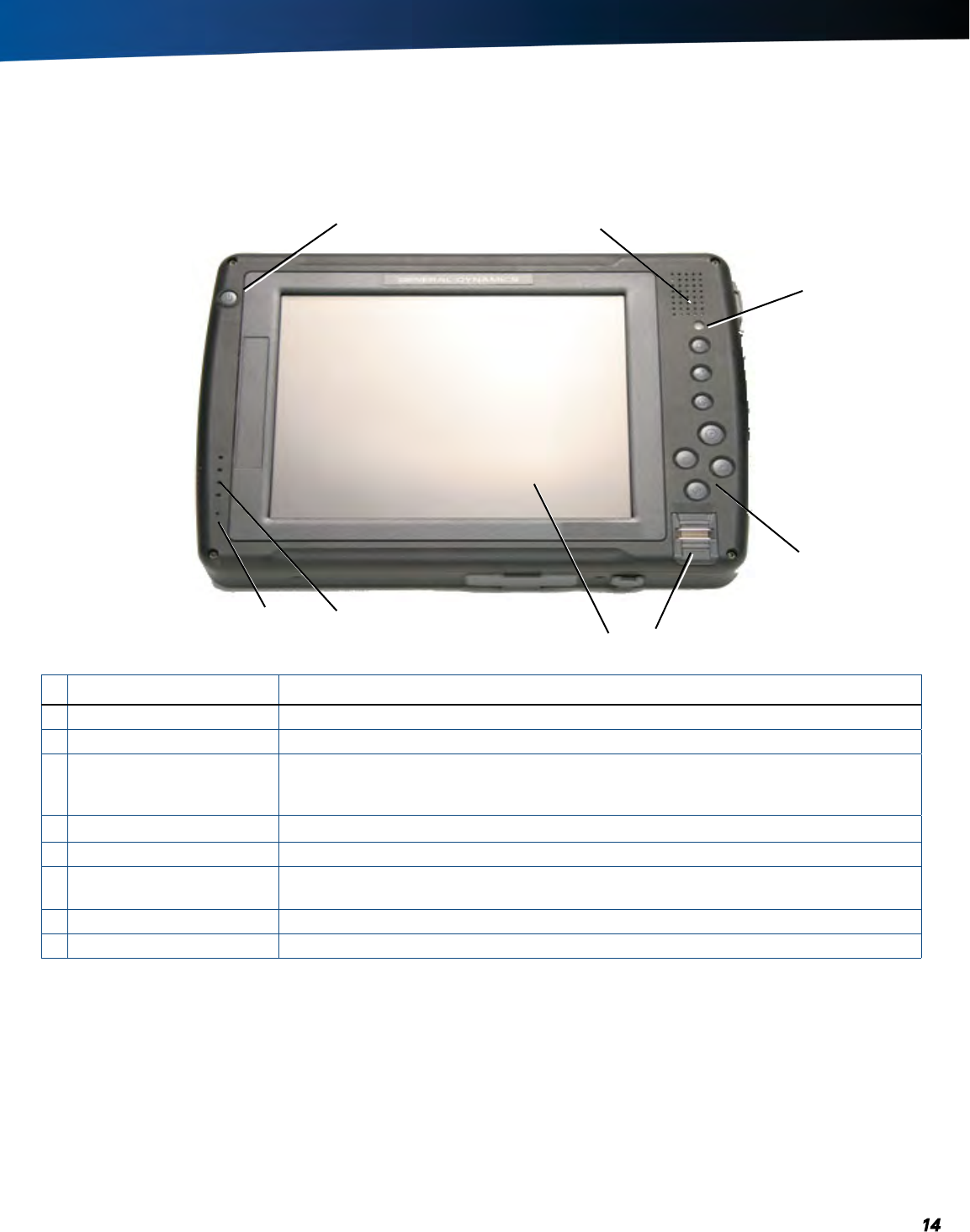
General Dynamics Itronix | 72-0145-001
GD3080 User Guide
Front View 12
3
4
5
7
6
8
#Feature Description
1Power Button Press this button to turn the unit on or off or to hibernate.
2Speaker Use the integrated speaker for audio output
3Ambient Light Sensor When enabled, the Ambient light sensor adjusts the display backlight in response to
ambient light conditions. It is disabled by default. See Display and Pen Basics for more
information.
4Hot Keys Speeds common functions such as changing the display orientation
5Fingerprint Scanner Optional fingerprint scanner for additional security.
6Display 8.4” XGA (1024X768) outdoor transmissive display with digitizer control panel and
optional touch screen
7LED Status Indicators The LEDs light up when a particular function of the computer is active
8Microphone Use the sealed, integrated microphone for audio input
Getting Familiar
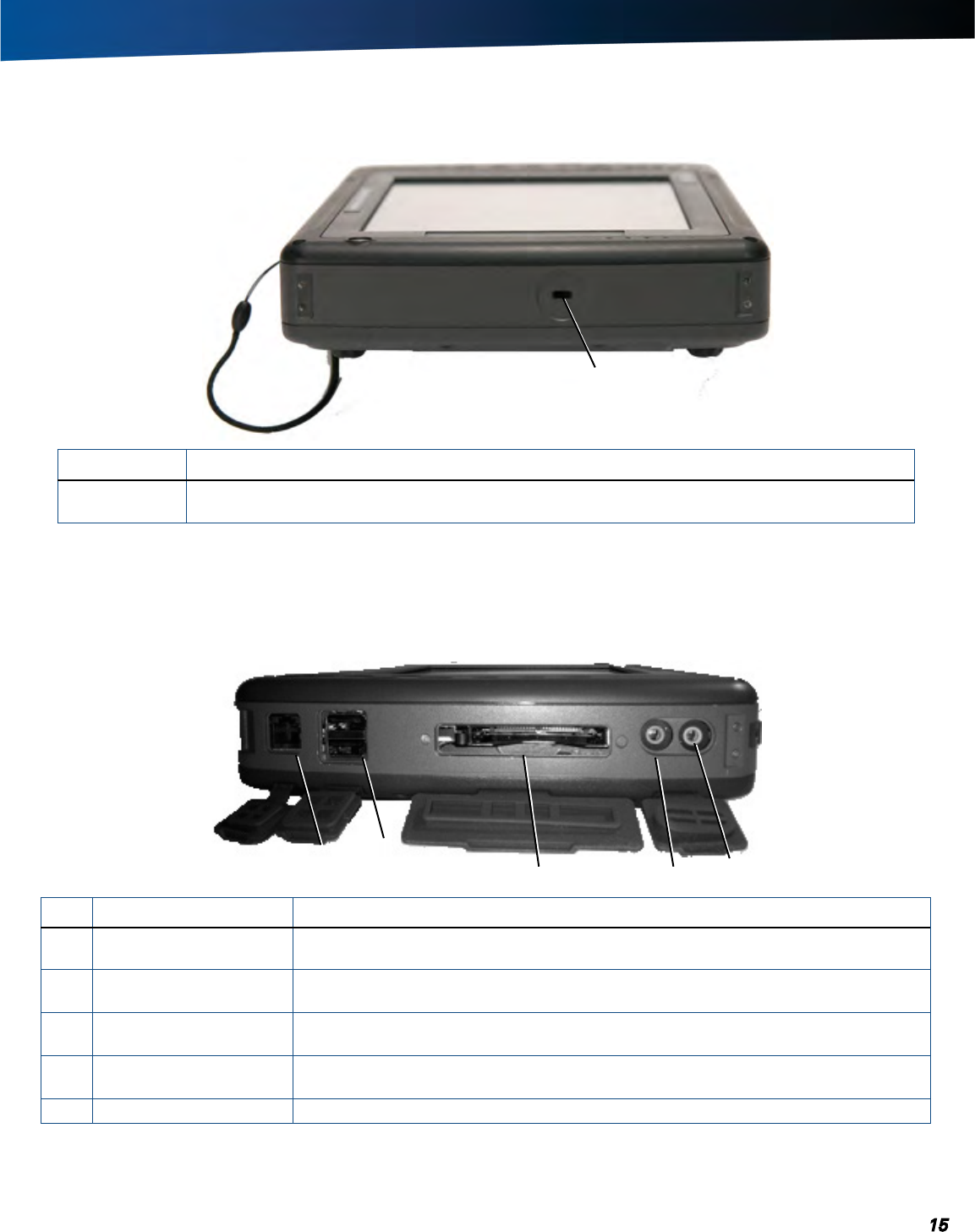
General Dynamics Itronix | 72-0145-001
GD3080 User Guide
Getting Familiar
Feature Description
Security Slot Your computer has a security slot that can be used with a standard laptop locking device, such as a
Kensington Lock.
#Feature Description
1Fax/modem RJ-11 Jack The fax/modem can transmit data using the 56 Kbps V.90 or V.92 protocol, and send and
receive faxes at 14.4 Kbps.
22 USB 2.0 ports The universal serial bus (USB) enables you to attach keyboards, a mouse, scanners,
printers and other USB devices. USB devices can be chained together on a single cable.
3CF Slot Housing for (optional) GPS electronics and antenna or CF slot for compact flash cards
and devices.
4Audio-Out Jack Connect external speakers or a stereo headset to this jack to listen to multimedia (mono
only).
5Audio-In Jack Connect a microphone to this jack to record audio.
Left Side View
Security Slot
12
345
Right Side View
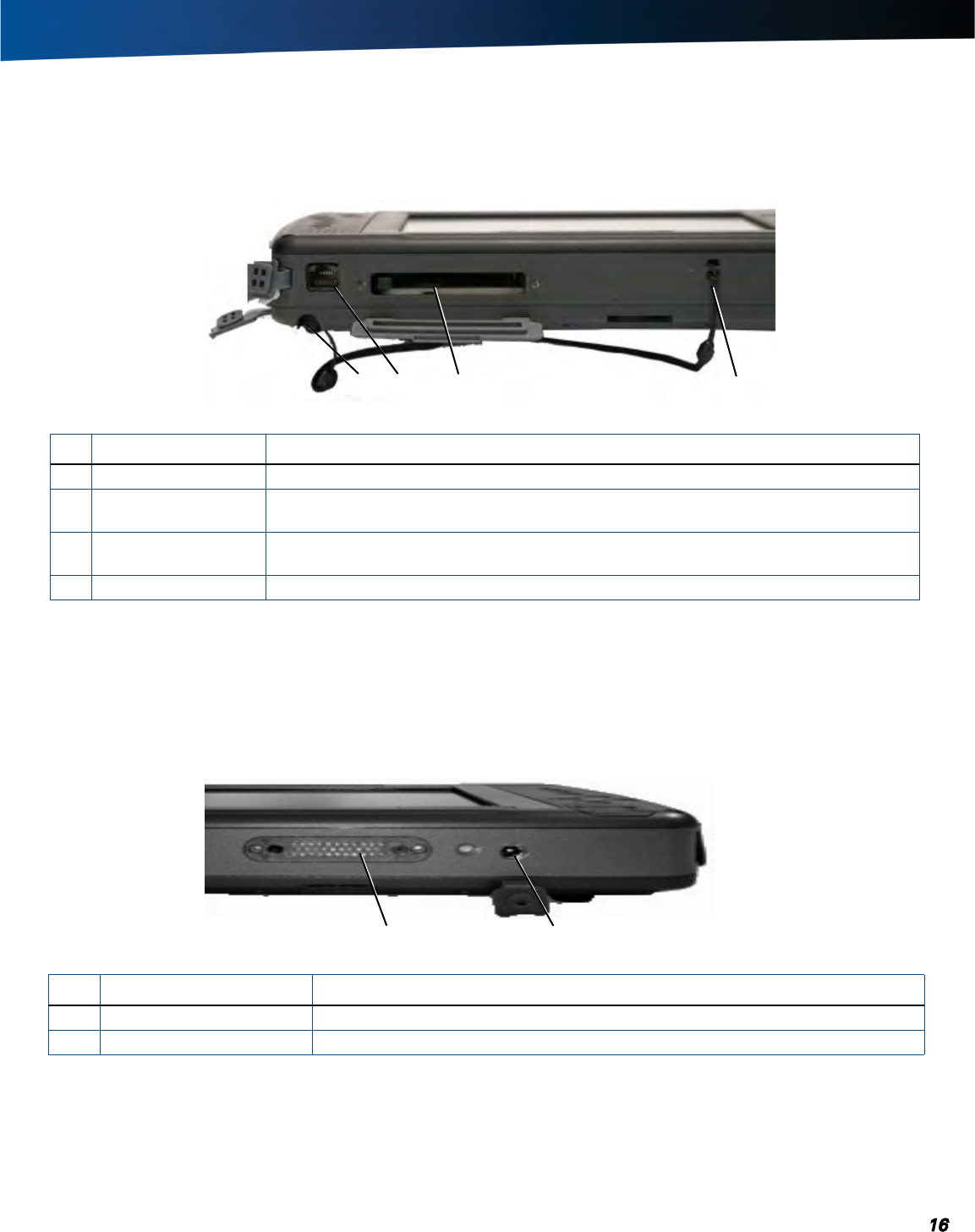
General Dynamics Itronix | 72-0145-001
GD3080 User Guide
Getting Familiar
#Feature Description
1POGO 32 Pins Connector Use this POGO connector with the desk mount.
2DC-in Jack Power the Tablet PC by connecting the AC adapter or vehicle adapter.
#Feature Description
1Pen Storage Slot Store the pen / stylus here when not using it.
2LAN RJ-45 Jack With an Ethernet LAN (Local Area Network) you can make LAN connections without
installing PC cards. Connection speed is 10/100/1000 Mbps.
3Type II PC Card Slot The PC card slot supports 32 bit CardBus 2.1 interface as well as Zoom Video when in land-
scape orientation. You can use this slot with PC card radios.
4Pen Tether Slot Thread your pen tether through this slot.
2 3 41
Top Edge View
21
Bottom Edge View
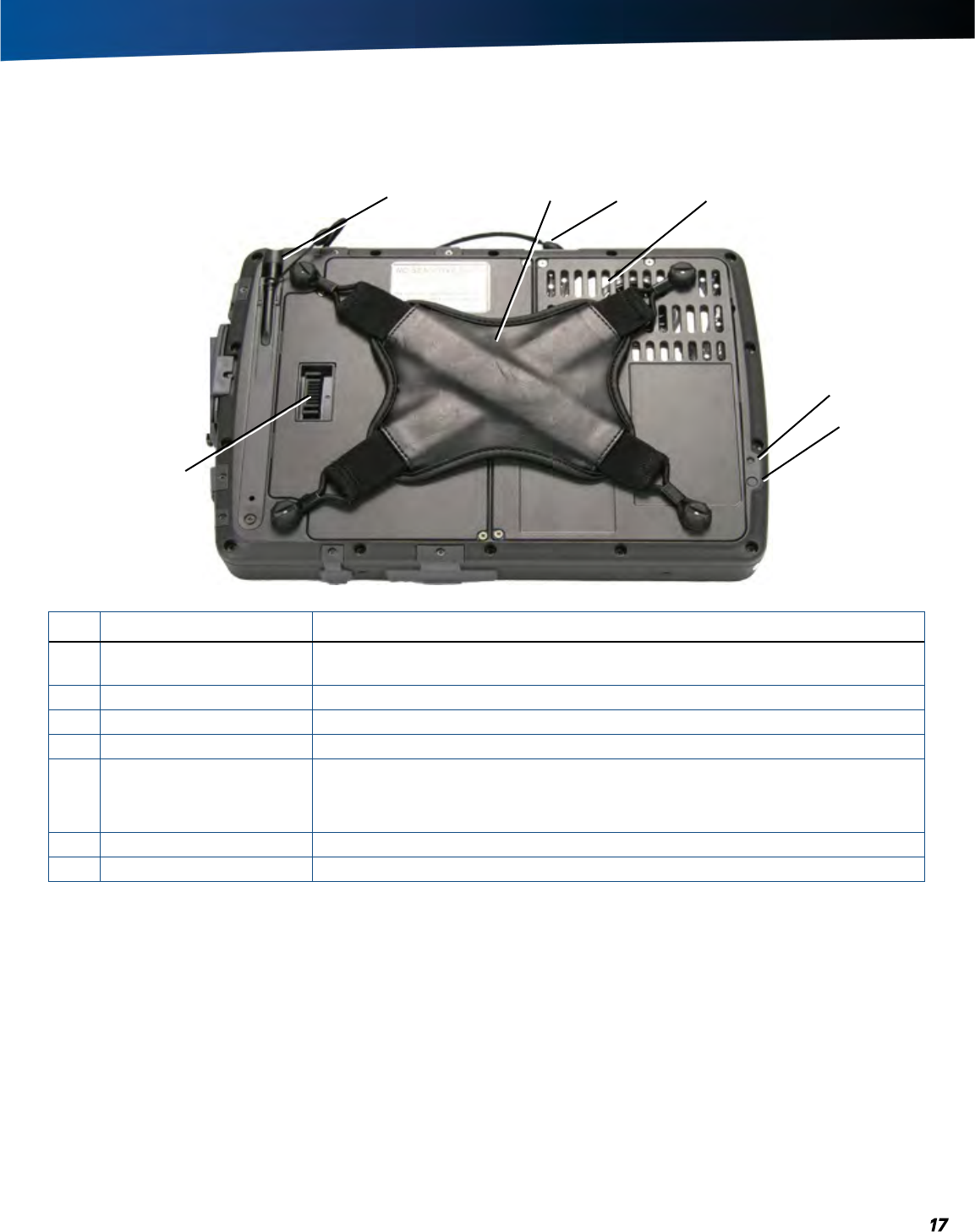
General Dynamics Itronix | 72-0145-001
GD3080 User Guide
Getting Familiar
#Feature Description
1Pen / Stylus Slot Use the pen provided with your Tablet PC to navigate and input on the touch panel
display. Store it in the slot when not using it.
2Hand Strap Allows GD3080 to be held with one hand (optional device).
3Pen Tether Attach a pen tether to the tether slot to keep the pen with the Tablet PC.
4Thermal Grate Covers the fan. Do not cover this grate while using the GD3080.
5Master Reset Key Use the stylus tip in this hole to perform a hard reset of your GD3080. You will then
need to press the power button to restart the computer.
Caution Any unsaved files or data will be lost during a hard reset.
6RF ON/OFF Button This button enables/disables WLAN, Bluetooth, and GPS radios.
7Second Battery Connector Attach a second, external battery to this connector to extend battery life.
2 3 41
Back View
5
6
7
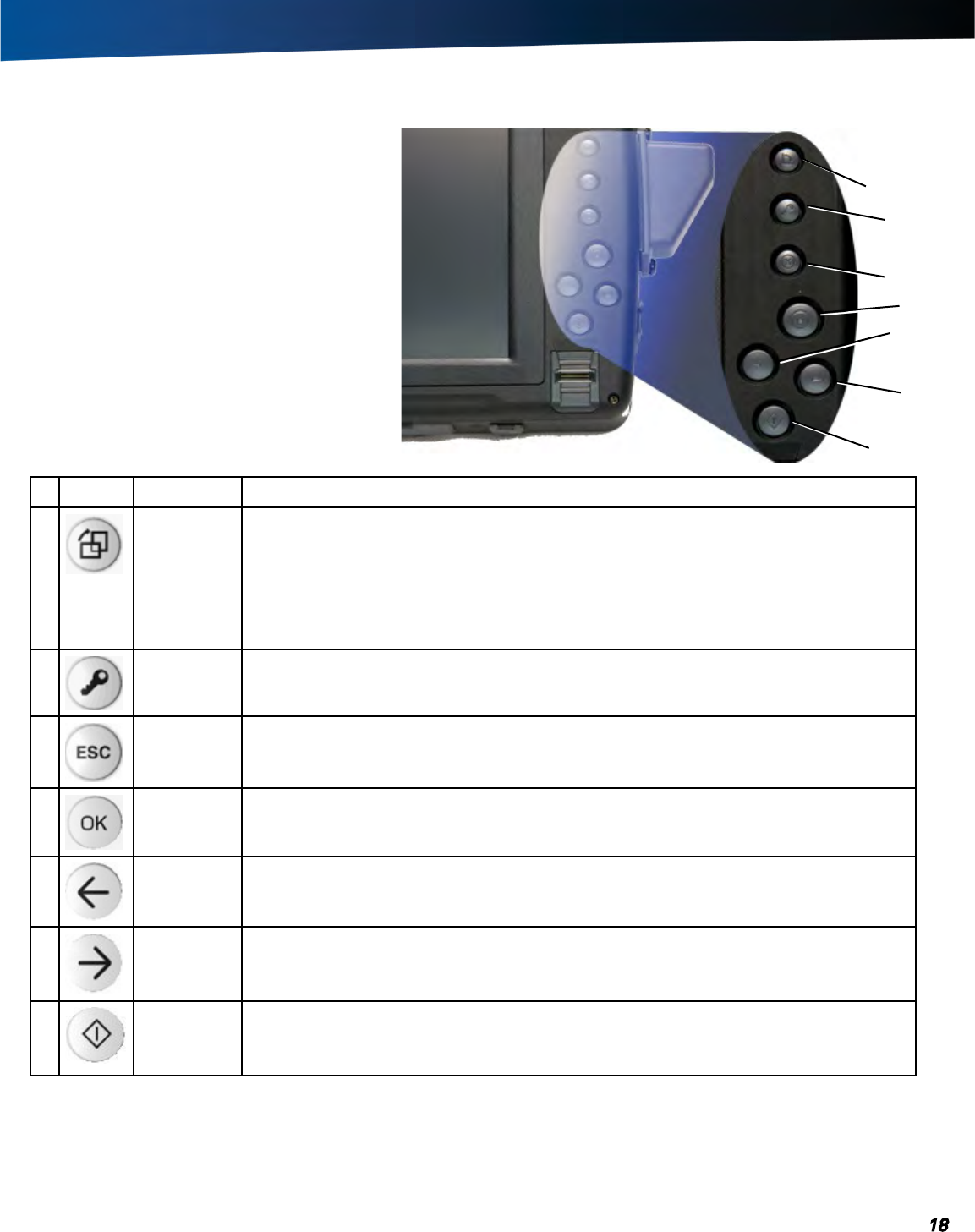
General Dynamics Itronix | 72-0145-001
GD3080 User Guide
Getting Familiar
Buttons and Hot Keys
The GD3080 has seven Hot Keys to speed com-
mon functions. Additionally, it has a Power
Button, an RF On/Off Button, and a Master Reset
Key.
#Icon Hot Key Description
1Rotate Key Use this key to switch between portrait and landscape orientation on the display. It rotates the
screen in 90° increments. You can also program it to execute a specific function.
note You will need to calibrate the display for each orientation and choose a primary
orientation.
Some applications may not display as well in portrait orientation. For example, you may need
to scroll right to view all the contents on the page.
2Security Key Press this key like you would press CTRL+ALT+DEL on a desktop computer.
3Escape Key Press this key to go back or escape to the previous context or window. You can also program
it to execute a specific function.
4OK/Enter Key Press this key just like you would press the ENTER key on a desktop computer. For example,
use this key to execute a command, implement an action, navigate deeper or move forward
through content.
5Line Up Key Press this key to move the cursor up one line. You can also program it to execute a specific
function.
6Line Down
Key
Press this key to move the cursor down one line. You can also program it to execute a specific
function.
7Function Key
(Fn)
Press this key in combination with another key to perform more functions. See the standard
key combinations listed below.
7
6
5
4
3
2
1
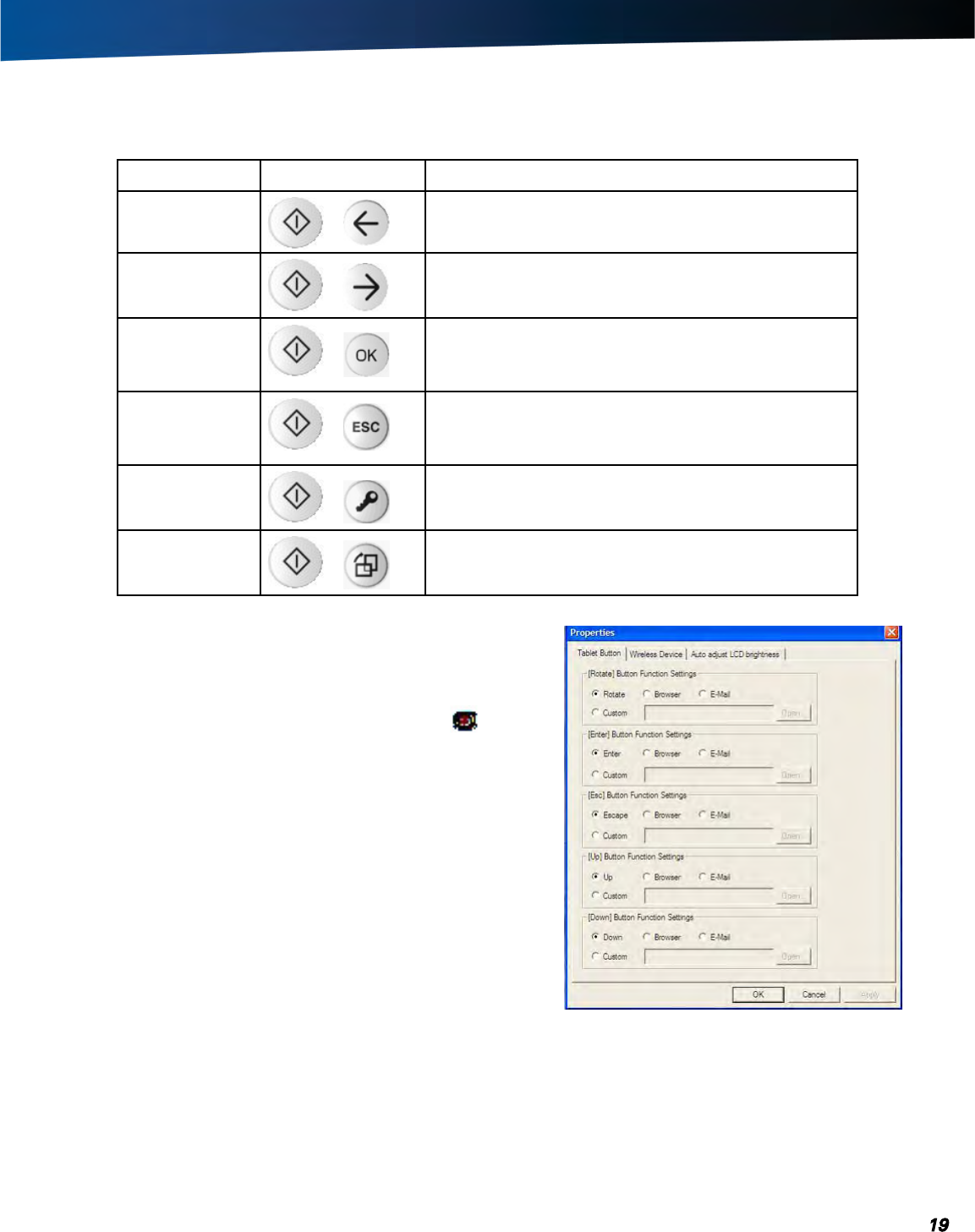
General Dynamics Itronix | 72-0145-001
GD3080 User Guide
Getting Familiar
FN and Hot Key Combinations
Function Key Icons Description
FN + LINE UP
Page up
FN + LINE DOWN
Page down
FN + OK/ENTER
KEY
Speaker volume down
FN + ESCAPE
Speaker volume up
FN + SECURITY
Display brightness down
FN + ROTATE
Display brightness up
Programming Hot Keys
You can program the ESCAPE, ROTATE, LINE UP and LINE DOWN hot
keys to perform specific functions. To program one of these hot keys,
do the following:
1. Select the Buttons / Device / Brightness Properties icon in the
taskbar.
2. Then, select the Tablet Button tab. This allows you to associate any of
the above listed buttons with any .exe or .com in the system.
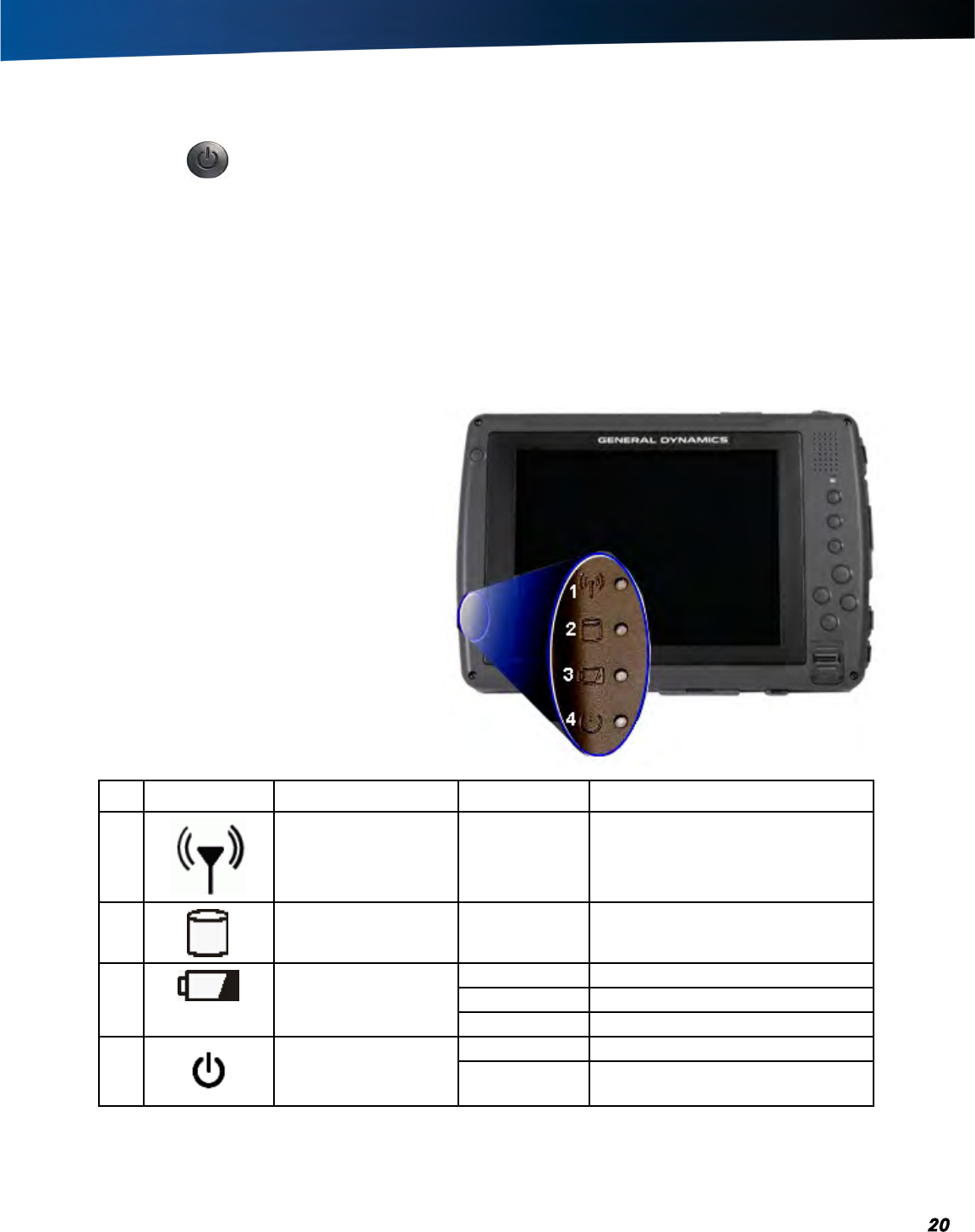
General Dynamics Itronix | 72-0145-001
GD3080 User Guide
Getting Familiar
Power Button
The POWER BUTTON is located at the top left corner above the display when the unit is in landscape orientation. Press this
button to turn the unit on or off or hibernate.
RF ON/OFF Button
This button is located on the back of the Tablet PC. It turns off Bluetooth® and disables WLAN and GPS radios.
Master Reset Key
The MASTER RESET KEY is located in a recessed hole on the back of the Tablet Ph. To perform a hard reset, insert the end of a
paper clip into this hole. You will then need to press the POWER BUTTON to restart the computer.
Caution Any unsaved files or data will be lost during a hard reset.
LED Status Indicators
The GD3080 has four LED (Light Emitting Diode) sta-
tus indicators located left of the display when the unit
is in landscape orientation. The LEDs light up when
a particular function of the computer is active. LED
numbers are from top to bottom when the Tablet PC is
in landscape orientation.
# Icon LED Light Description
1Wireless Radio Status
LED
Solid Blue Integrated radio(s) are powered on
2HDD Status LED Blinking Green Accessing the hard disk drive
3Battery Status LED Green Fully charged
Orange Charging
Red Battery capacity is less than 10%
4Power Status LED Solid Blue Unit is turned on
Blinking Blue Unit is suspended
note LEDs can be disabled by using the BIOS Setup Utility to activate Stealth Mode.
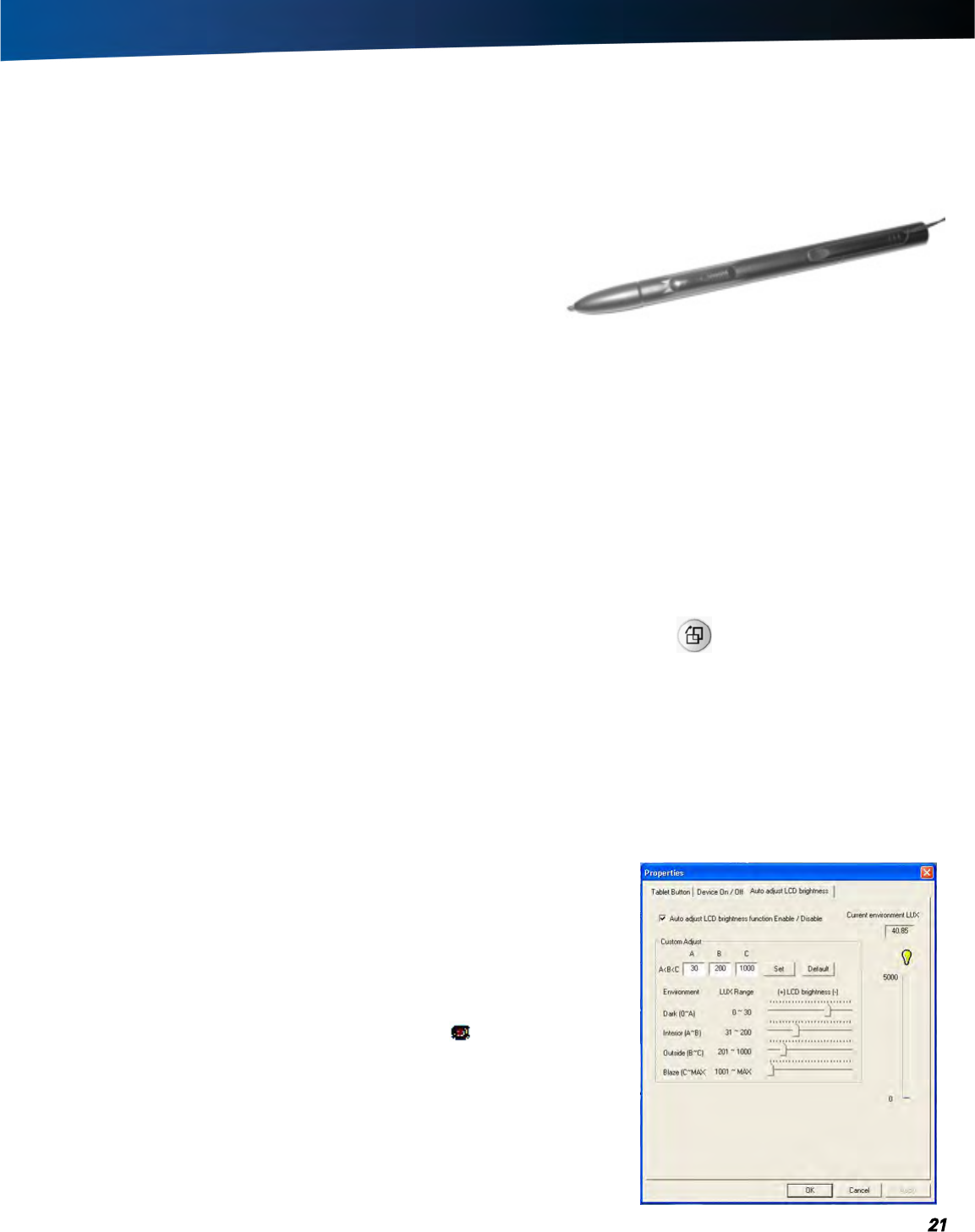
General Dynamics Itronix | 72-0145-001
GD3080 User Guide
Getting Familiar
Display and Pen Basics
Your GD3080 has an 8.4” TFT XGA outdoor viewable DynaVue™transmissive display with digitizer control panel and touch
screen. It is an active matrix color display with integrated graphics capabilities that provides excellent readability both indoors
and outdoors.
Using the Pen / Stylus
Use the pen/stylus provided with your GD3080 Tablet PC like you would use
a mouse on a desktop PC.
The following common mouse functions can all be performed with your
pen:
single-CliCk: Tap once with the pen
double-CliCk: Tap twice with the pen.
right-CliCk: In Digitizer Mode, tap while holding down the button on the pen. In Touch Screen Mode, tap and hold.
mouse-rollover: In Digitizer Mode, hover your pen above the display. For example, when you roll your mouse over an icon
you see a popup description of the icon. Hover your pen over the icon to see this description.
In addition to these mouse functions, you can use the pen to draw or write in some Tablet PC applications.
Caution Use only the pen included with the unit. Never use sharp, hard, or abrasive implements on the touch panel such as
ball point pens, pencils, or keys. They could damage the screen.
Changing the Display Orientation
You can change between landscape and portrait orientation by pressing the Rotate Hot Key . Each time you press the key,
the screen rotates 90° counter-clockwise. You can also change the orientation via the input panel by tapping CTRL+ALT and then
selecting one of the arrow keys.
note Not all configurations support 360° rotation and some applications may not display properly in portrait orientation.
Calibrating the Display
Your GD3080 has two touch modes, Digitizer and Touchscreen. To calibrate the display for the mode you are using:
1. Ensure you are in the mode you want to calibrate.
2. From the Start Menu, select All Programs, Mobile Computer Tools, Tablet Calibration.
3. Follow the on screen instructions.
Ambient Light Sensor
Your Tablet PC display has an ambient light-sensor near the display. It auto-
matically dims the display backlight in low light conditions. When enabled, this
feature conserves battery power.
To enable or disable the ambient light sensor, perform the following:
1. Select the Buttons / Device / Brightness Properties icon in the taskbar.
2. Select the Auto adjust LCD brightness tab.
3. From the Auto adjust LCD brightness tab you can activate or deactivate the auto
brightness adjust. You can also choose the backlight brightness level for four differ-
ent categories of ambient light level: dark, indoor, outside, and blaze.
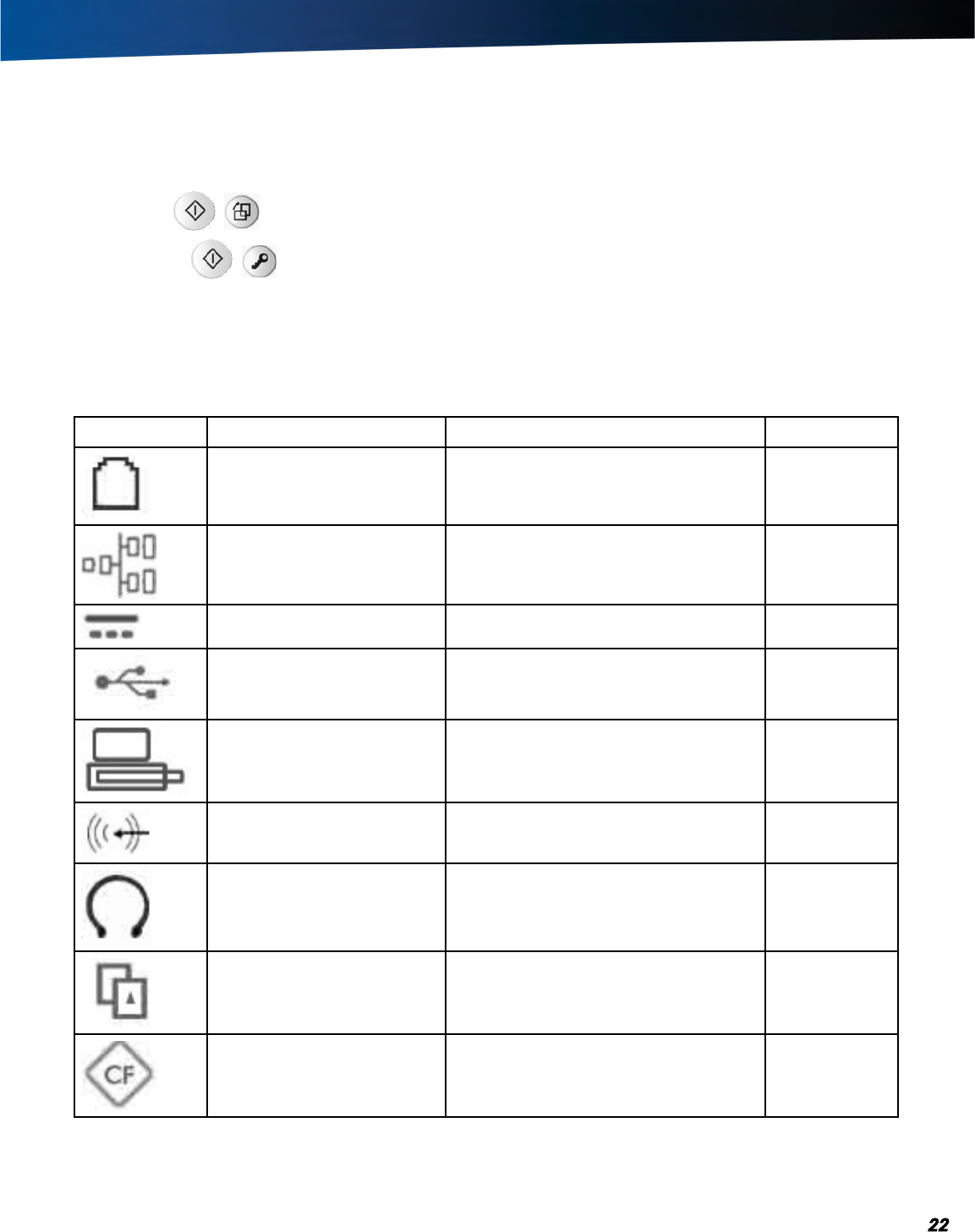
General Dynamics Itronix | 72-0145-001
GD3080 User Guide
Getting Familiar
Adjusting Screen Brightness
If you have trouble reading your display, you can adjust the screen brightness using hot keys. An on-screen brightness bar pops
up to show the brightness levels when you press one of the following:
Press FN+ROTATE to increase brightness
Press FN+SECURITY to decrease brightness
note If the Auto Adjust Brightness function is enabled, the backlight adjustment may change depending on ambient light
conditions.
See Maintenance and Storage for information on how to clean the display.
Ports and Connectors
Icon Ports and Connectors Connection Location
RJ-11 Phone line/modem (internet and fax) Right Side
RJ-45 Ethernet Top Edge
DC-in AC adapter (power) Bottom Edge
2 USB Universal Serial Bus 2.0 USB peripherals such as a mouse or printer Right Side
POGO 32 Pins Connector Desk mount Bottom Edge
Audio In Microphone Right Side
Audio Out Speakers or headphones Right Side
PC Card Slot Type II PC Cards Top Edge
Compact Flash Slot Compact Flash Cards Right Side

General Dynamics Itronix | 72-0145-001
GD3080 User Guide
Getting Familiar
Disk Drives
Your GD3080 comes with several components for reading and writing (recording) information.
The Hard Disk Drive (HDD)
The hard disk drive provides high-capacity storage and fast access. The operating system and most programs are stored here.
Your GD3080 identifies the hard disk drive as drive C:. Your hard disk drive may include an optional hard drive heater to allow
operation in certain environments. There is also a solid state hard drive option.
Card Slots
You can also use the PC Card Slot and Compact Flash Card Slot for additional data storage.
Optional External Drives
The GD3080 has three Universal Serial Bus (USB) external drive options that may be connected to the Tablet USB ports. You do
not have to power down the Tablet PC to connect any of these drives because they are “hot pluggable.”
USB Floppy Disk Drive (FDD): The floppy disk drive provides a convenient way of storing and transferring small files. It uses standard
3.5-inch, 1.44 MB disks.
usb Cd-rom drive: The CD-ROM drive can be used to read data from CDs, including audio or video CDs.
usb dvd / Cd-rW: The DVD / CD-RW drive is a read/write drive. It can be used to write data to a recordable CD. It can also read
data from DVDs and CDs, including audio or video disks.
note The GD3080 identifies the drive with the letter following the highest partition letter. For example, if your highest drive
partition is drive E:, the DVD/CD-RW or CD-ROM will be assigned to drive F:. However, the floppy drive will always get assigned
to drive A: or B:.
Precautions for Handling DVDs and CDs
Keep these precautions in mind when handling DVDs and CDs.
Always hold the disk by the edges; avoid touching the surface of the disk
Use a clean, dry, cloth to remove dust, smudges, or fingerprints. Wipe from the center outward
Do not write on the surface of the disk
Extremes in temperature may damage disks. Store disks in a cool dry place
Do not use benzene, thinners, or cleaners with detergent to clean DVDs or CDs. Only use cleaning kits designed for DVDs or CDs
Do not bend or drop the disks
Do not place objects on top of disks
Do not expose to direct sunlight for long periods
Computer Security
Your computer includes several different security features to help prevent theft and protect data. These include a security slot,
multiple levels of password protection, an optional fingerprint scanner, and stealth mode.
Security Slot
A security slot located on the left side of the computer lets you connect a Kensington compatible computer security lock. You can
connect the computer to an immovable object to prevent theft. Insert the lock into the notch and turn the key to secure the lock.
Some keyless models are also available. See the documentation that comes with your lock for more information.
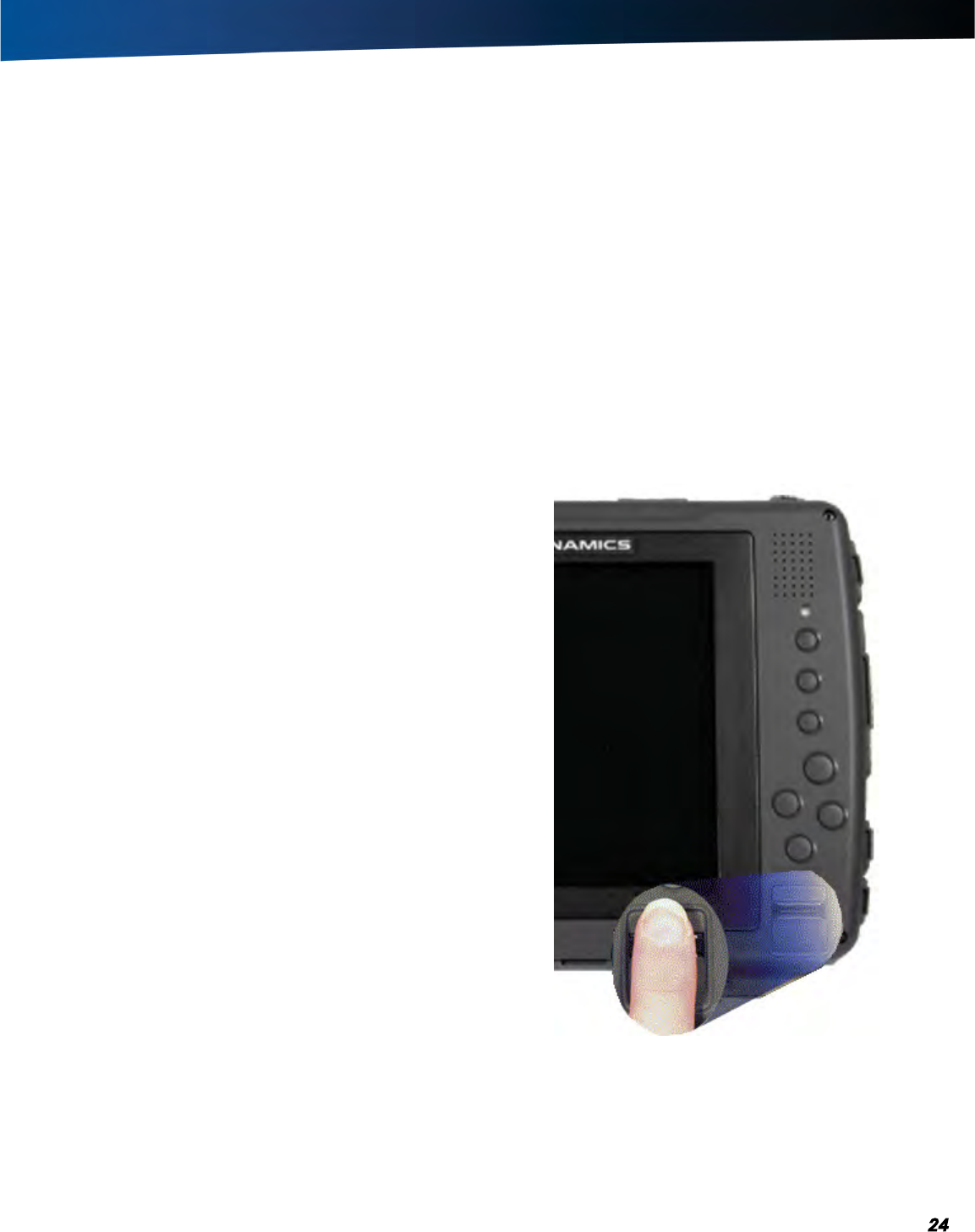
General Dynamics Itronix | 72-0145-001
GD3080 User Guide
Getting Familiar
Passwords
Passwords protect your computer from unauthorized access.
When set, no one can access the computer without entering
the correct password.
There are three types of passwords you can set:
suPervisor PassWord secures your computer against unau-
thorized entry to critical parameters in the BIOS Utility
user PassWord secures your computer against unauthorized
use, and allows limited access to the BIOS Utility
hard disk PassWord protects your data by preventing
unauthorized access to your hard disk, even if the hard disk is
physically removed from the computer and installed in another
computer
note Do not forget your setup and hard disk password! If
you forget your password, please get in touch with your dealer
or an authorized service center.
Fingerprint Scanner (Optional)
The optional swipe style fingerprint scanner can be used for
all standard security uses. The optional fingerprint scanner
provides a greater level of security and convenience for your
GD3080 and your private data. Use the fingerprint scanner
instead of passwords for the following:
Logging in to your Tablet PC
Logging into secure websites or when opening password pro-
tected applications
Providing encryption security for individual files
Fingerprint Scanner Software
Before using the fingerprint scanner, you must first install
compatible software. There are various software packages
available.
Caution Before installing any third party software, ensure
it is approved for use with your Tablet PC.
note When accessing some secure websites, you may need
to specify you are using the scanner instead of a password.
Refer to the fingerprint scanner software documentation for
setup instructions.
Stealth Mode
Your computer has a Stealth Mode feature for users who may
need to use it where light or sound could be dangerous or
disruptive, such as military personnel. Enabling Stealth Mode
allows you to disable sound and light features such as system
beeps, the fan, and the display backlight. Refer to the BIOS
Setup Utility section to configure the Stealth Mode feature.
Trusted Platform Module (TPM)
The TPM can be enabled or disabled in the System BIOS
utility under the Advanced, Trusted Computing section. TPM
provides a platform root of trust which uniquely identifies a
particular platform and provides various crypto capabilities
including hardware-protected storage. See the TPM vendor’s
help files for more information.
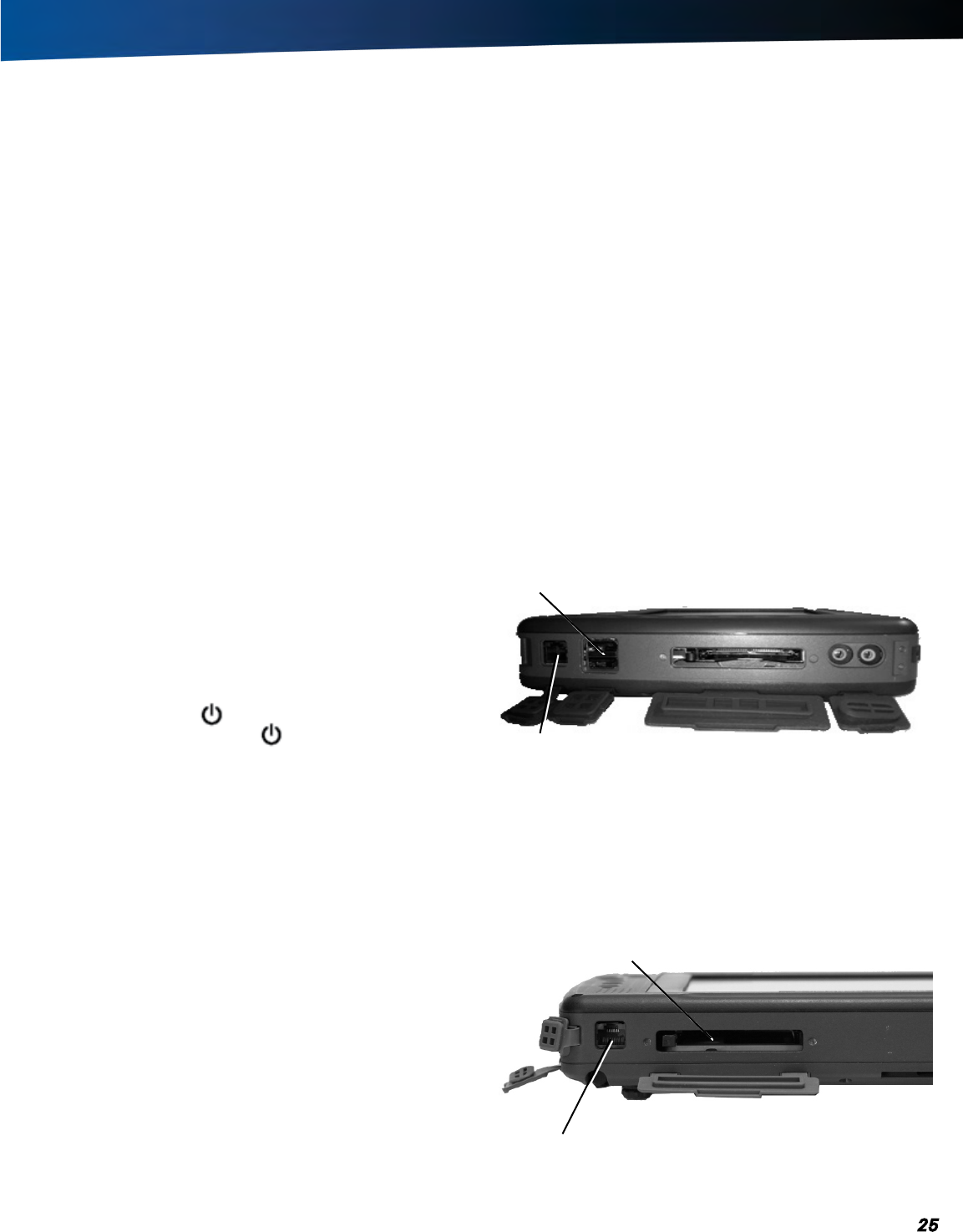
General Dynamics Itronix | 72-0145-001
GD3080 User Guide
Your GD3080 is equipped with a full array of ports and connectors,
including standard input/output (I/O) ports for quickly and easily
adding peripherals such as a USB printer. Refer to documentation
included with individual devices for details on connecting these
devices to your computer. Along with the standard ports found on
most computers, your computer also includes modem and LAN ports
for advanced communications technology.
Caution Keep port doors closed when not in use. Internal
components of the GD3080 will be damaged if exposed to con-
taminants. When dust covers, the PC card door, or the bottom
access panel are open on the computer, shield the unit from all
contaminants such as liquids, rain, snow, and dust.
Attaching Power
You can operate the computer while the battery is charging on
external power or on battery power.
Attaching the AC Adapter
1. Connect the supplied AC adapter power cord to the AC adapter.
2. Connect the AC adapter to the DC power port on your com-
puter.
3. Connect the AC adapter power cord to an AC outlet.
Alternately, you can attach the optional vehicle adapter.
Turning the GD3080 On and Off
To turn on the computer
Press the Power Button once, and then give the system
time to respond. The Power LED should illuminate and the
unit should boot into Windows®.
To turn off the computer
WindoWs® xP: From the Start menu, select Turn Off Com-
puter, then select Turn Off.
WindoWs® 7: From the Start menu, select Turn Off Com-
puter, then select Turn Off.
note If you need to leave the system for a short time, or if
you want to conserve battery power, you can put the computer
into hibernation mode by pressing the power button. See
Managing Power for additional information.
Caution Shutting down the computer improperly could
result in lost or corrupted data.
Ethernet
The Ethernet LAN Local Area Network (RJ-45 Jack) on the top
edge of the computer enables you to make LAN connections
without installing PC cards. Connection speed is 10/100/1000
Mbps.
Internet and Fax
The fax/modem RJ-11 jack can transmit data using the 56 Kbps
V.90 or V.92 protocol, and send and receive faxes at 14.4 Kbps.
In some countries, local regulations may not permit the use of
the fax/modem designed for this system. In this case, you may
use a PCMCIA modem.
Caution Plug your modem into an analog telephone jack
only. Most homes use analog lines. Do not use digital lines,
such as PBX and ISDN systems found in many offices. Digi-
tal lines may damage your modem. If you are unsure as to
the type of port you have to plug into, contact your building
superintendent. Simple detection and protection devices are
also available at most computer stores and should be used to
protect the GD3080.
note Port access to connect the modem is disabled for the
Australian market.
Attaching USB Devices
The two Universal Serial Bus (USB) 2.0 ports enable you to
attach USB devices such as keyboards, a mouse, scanners, and
printers.
Using PC Cards
The GD3080 has a Type II PC Card Slot located on the top side
of the computer. It supports 32 bit CardBus 2.1 interface as
well as Zoom Video™ when in landscape orientation. You can
use this slot to interface between your GD3080 and a variety
of communications devices, such as network adapters, SCSI
adapters, fax/modems, and PC card radios. It can also provide
additional data storage capacity.
Making Connections
USB
PC Card Slot
Ethernet
RJ11 / Internet Fax
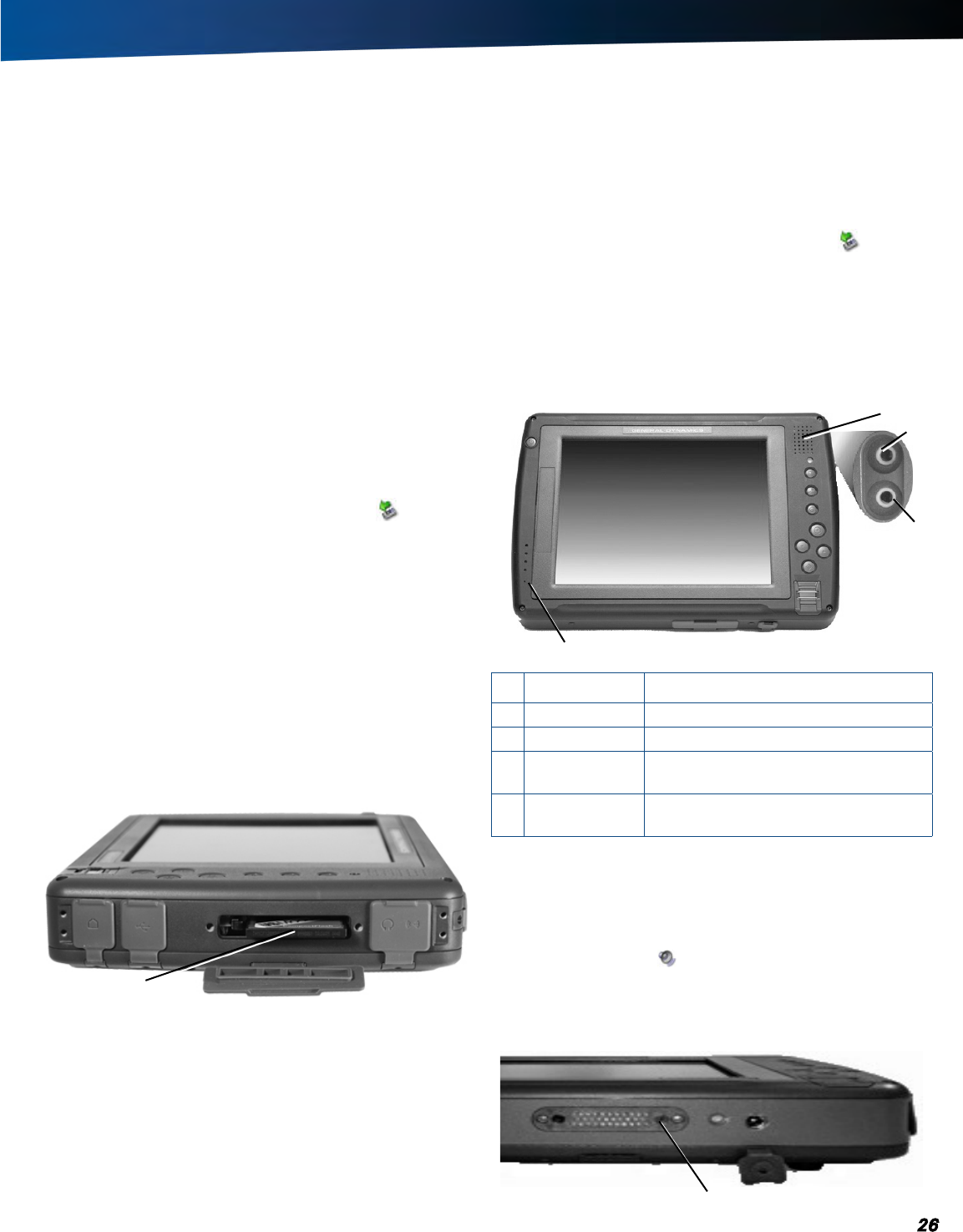
General Dynamics Itronix | 72-0145-001
GD3080 User Guide
Making Connections
Installing a PC Card
1. The top side of a PC Card is usually identified with a label.
Insert the card into the slot with the top up and the edge with
pinhole contacts going in first. You will feel some resistance as
the card slides into the back of the slot.
2. PC Cards require drivers, or a program that allows the operat-
ing system to use a specific device. Many drivers are included
with Windows®, but if not, you will be prompted to install the
driver included with your card.
note Please read the instructions included with individual
PC Cards. Some cards may be inserted with power on, while
others require that the computer be turned off.
Ejecting a PC Card
For Windows® XP and Windows® 7:
1. First, exit the application using the card.
2. Left-click on the Safely Remove Hardware icon on the
taskbar and stop the card operation.
3. Press the slot eject button once to pop it out; then press it again
to eject the PC Card.
Using Compact Flash Cards
Your GD3080 can use Type 1 Compact Flash Cards for secure
data storage. If you store any user-installed application pro-
grams and associated data on Compact Flash, these programs
and data will not be lost after a hard reset. Files stored on Com-
pact Flash Cards can be created, deleted, moved and amended
in exactly the same manner as files stored in memory. The
Compact Flash slot is also used to house the optional GPS
radio and antenna.
Installing a Compact Flash Card
1. Open the Compact Flash port cover on the right side of the
computer.
2. Position the Compact Flash Card with the label facing up and
carefully insert it into the socket. Your GD3080 should automati-
cally detect most Compact Flash Cards.
Ejecting a Compact Flash Card
For Windows® XP and Windows® 7:
1. First, exit the application using the card.
2. Left-click on the Safely Remove Hardware icon on the
tray taskbar and left click on the Compact Flash Card operation.
3. Press the slot eject button once to pop it out; then press it again
to eject the Compact Flash Card.
Audio
Your GD3080 has integrated audio as well as audio jacks so
you can connect external audio components.
Compact Flash Card
1
2
3
4
#Feature Description
1Microphone Integrated microphone for audio input
2Speaker Integrated speaker for audio output
3Headphone
jack
Connect external speakers or a stereo
headset
4Microphone
jack
Connect an external microphone for
audio recording
Changing the Volume
Use the volume function keys: FN + ESC = Volume Up; FN +
OK = Volume Down, or
Open the Windows® volume control program by double-tap-
ping the Speaker icon in the taskbar.
Attaching to the Desk Mount
Use the POGO connector to connect the Desk Mount or cus-
tom external devices.
POGO Connector
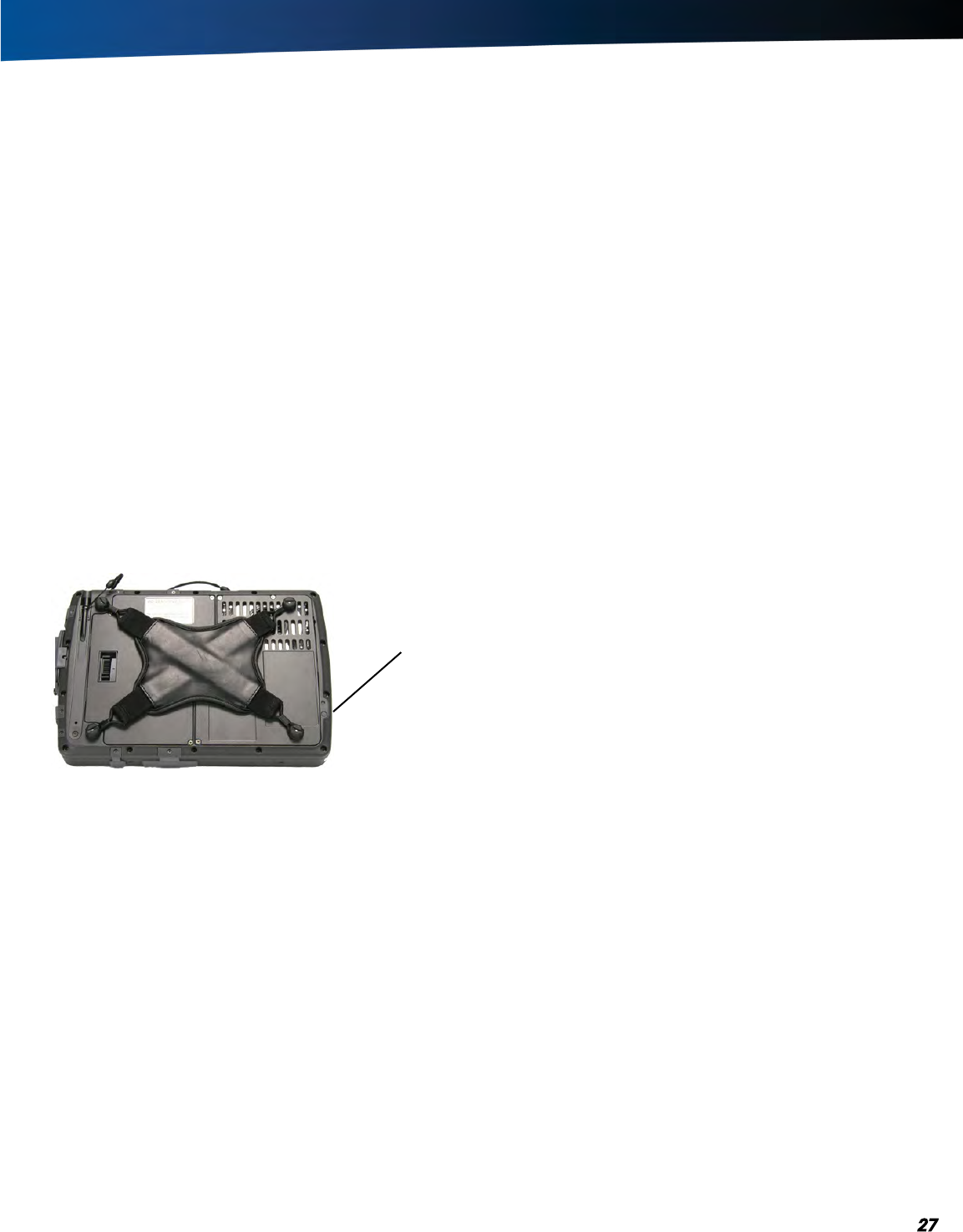
General Dynamics Itronix | 72-0145-001
GD3080 User Guide
The GD3080 has superior wireless capabilities. Depending on
your configuration, it supports up to four optional wireless radio
technologies: PC card wireless technologies; Bluetooth, Wireless
LAN (WLAN), and GPS.
Each GD3080 comes standard with three antennas for wireless
communication; two WLAN and one Bluetooth. GPS and PC
Card radio antenna are optional accessories.
Use only the supplied or an approved antenna(s). Unauthor-
ized antennas, modifications, or attachments could impair data
quality, damage the cord, or result in violation of FCC regula-
tions.
Your GD3080 has an RF ON/OFF button on the back. This can
be used to turn off Bluetooth and disable WLAN, WWAN, and
GPS radios. The radios can also be enabled or disabled in the
BIOS on the Advanced tab, Extended Configuration.
Turning Off Radios with the Radio On/Off Button
1. Turn your Tablet PC over so you are looking at the back of the
unit.
2. Press the radio On/Off button.
tional LAN. Desktop client systems can be located in places
where running cable is impractical or impossible. Desktop PCs
can be redeployed anywhere within a facility as frequently as
needed, making wireless ideal for temporary workgroups and
fast-growing organizations.
Electromagnetic Interference (EMI)
Electromagnetic Interference (EMI) is generated by switching
circuitry closets or Uninterruptable Power Source (UPS) systems
found near computer rooms and can block the radio signal.
Look for significant sources of electromagnetic radiation. The
problem may emanate from a source between location and the
radio base station.
When to Use Landline Communication
If the tips above do not improve radio signal strength, switch
to landline communication. Switching to landline communica-
tion is faster than searching for and trying to improve the radio
signal.
WLAN Radio (optional)
The GD3080 may include an integrated Wireless Local Area
Network (WLAN) capability. See the radio help file on your
computer desktop for more information.
Read About WLAN
WLAN provides all the features and benefits of traditional LAN
technologies, such as Ethernet, without the limitations of wires
or cables. It enables mobility and flexibility without compro-
mising connectivity for today’s mobile user.
GPS (optional)
Your GD3080 may include a Global Positioning System (GPS).
The GPS is a worldwide radio-navigation system formed from
a constellation of satellites and their ground stations. These
satellites are used by the GPS as reference points to calculate
positions accurate within five meters.
Wireless Communication
Radio on/off button
Bluetooth Radio (optional)
The GD3080 includes an integrated Class 1 Bluetooth® option.
Its maximum range is about 100 meters.
Read About Bluetooth
Bluetooth® systems create a personal-area network (PAN), that
may fill a room or may encompass no more distance than that
between the cell phone on a belt-clip and the headset on your
head.
When Bluetooth® capable devices come within range of one
another, an electronic conversation automatically takes place
to determine whether they have data to share or whether one
needs to control the other. The devices form a network.
Once this network is established, the devices randomly hop
frequencies in unison so they stay in touch with one another
and avoid other networks that may be operating in the same
room.
Applying wireless LAN technology to desktop systems pro-
vides an organization with flexibility impossible with a tradi-
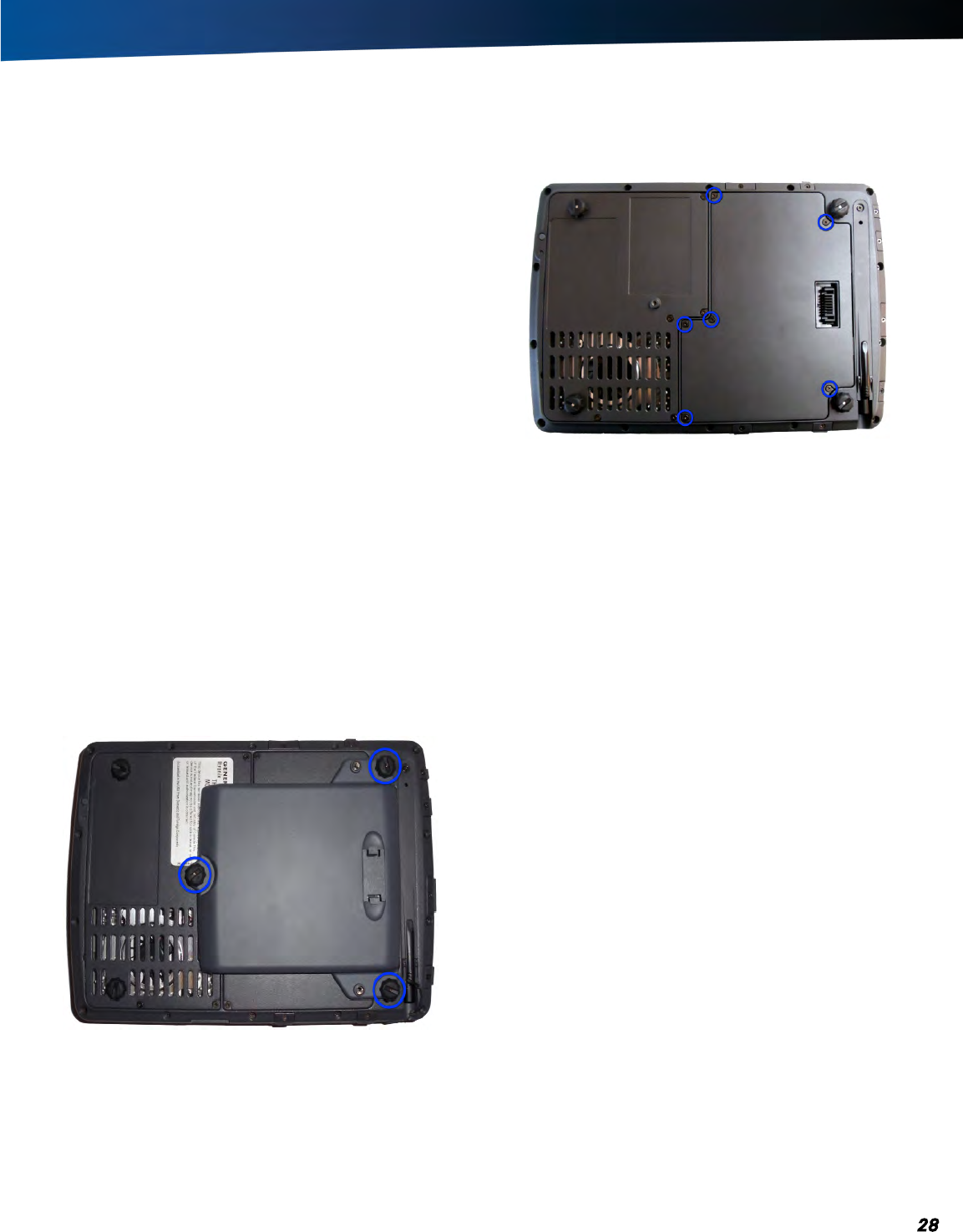
General Dynamics Itronix | 72-0145-001
GD3080 User Guide
The GD3080 uses Dynamic Power Management ( DPM ) so you
can reduce the amount of energy used, especially during periods
of inactivity. It is powered by a smart Lithium-ION battery pack.
A CMOS coin battery maintains the Real Time Clock and CMOS
memory. There is also an optional second external battery pack that
effectively doubles your battery powered runtime.
Battery Installation and Replacement
Over time, the battery’s capacity gradually decreases. We
recommend that you replace your battery when you notice that
it begins to store significantly less charge. Change the main
battery pack as follows (you may want to print this topic for
reference).
Caution The GD3080 battery and unit are only weather
sealed when the battery is properly installed and the bat-
tery door is closed. Shelter the computer when you install or
replace the battery. To prevent damage when the unit is in
use, keep the battery door closed with all screws in place and
secured tightly.
Installing the Battery
Caution The GD3080 should always be shut down prior to
battery removal, because data may be lost when the battery is
removed.
1. Turn off the computer.
2. Unplug the power supply if connected.
3. Turn the computer upside down.
4. Remove the three screws on the secondary battery, if installed
and remove the battery.
5. Using a Phillips screwdriver, remove the six screws from the
battery cover and remove the battery cover.
Caution Internal components of the GD3080 will be dam-
aged if exposed to contaminants. When dust covers, the PC
card door, or the bottom access panel are open on the com-
puter, shield the unit from all contaminants such as liquids,
rain, snow, and dust.
6. Using the tab on the battery, lift the battery pack up and out of
the battery bay.
7. Orient the replacement battery correctly and insert it into the
battery compartment, making sure it is fully seated.
8. Replace the battery cover over the battery bay and install the
six screws.
9. Install the secondary battery if equipped.
10. Completely charge the battery before using the Tablet PC on
battery power.
NOTE When the battery is installed and the computer is con-
nected to AC power it starts charging automatically. At moder-
ate temperatures, approximately 70° Fahrenheit (21°C), the
battery will be fully charged in 3-5 hours. In warmer or cooler
temperatures, the battery can take much longer to fully charge.
Battery calibration is disabled if the temperature is > 122°F
(50°C) or < 41°F (5°C).
Battery Power
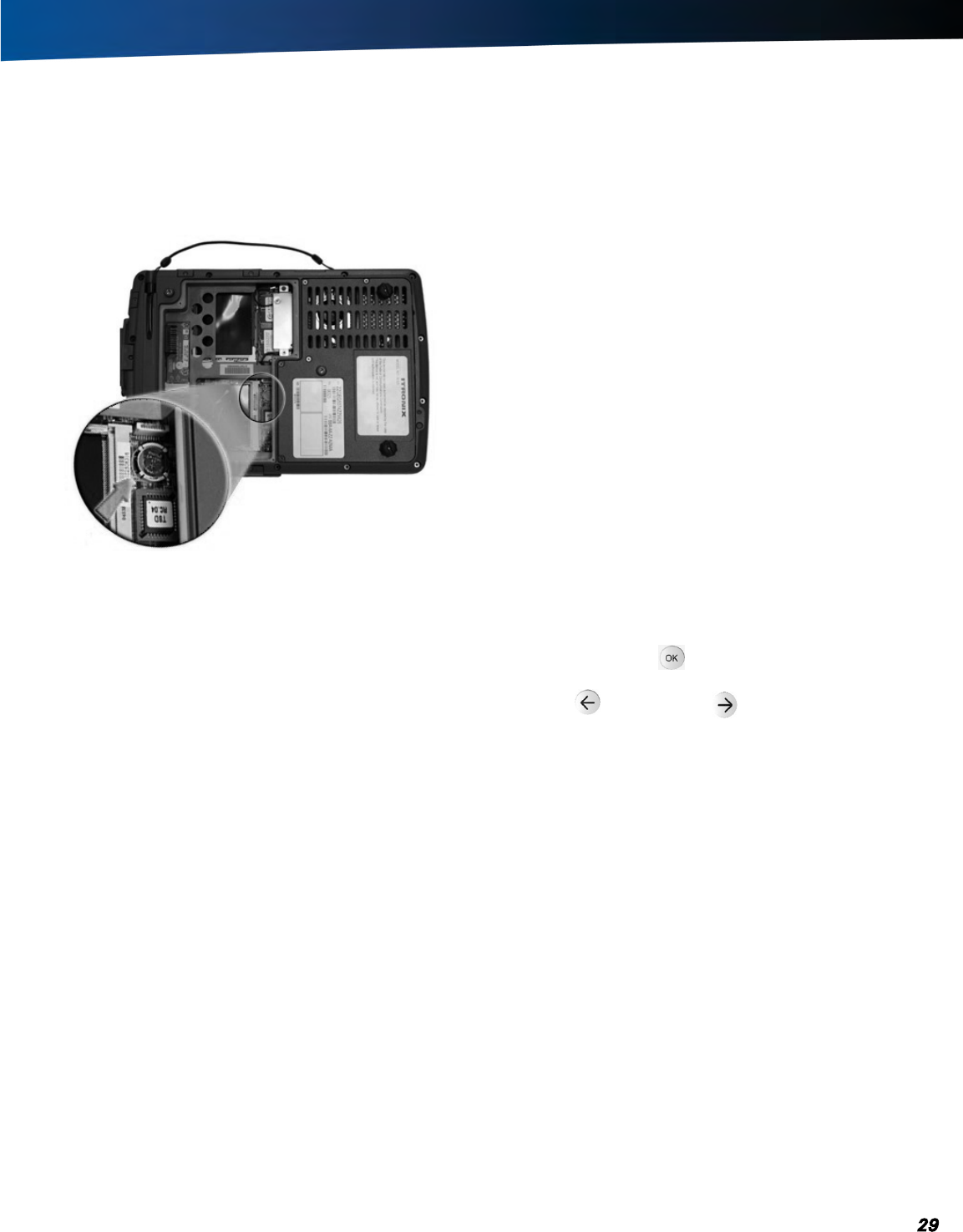
General Dynamics Itronix | 72-0145-001
GD3080 User Guide
Battery Power
Replacing the Real Time Clock Battery
The Real Time Clock has a replaceable coin battery located
under the battery pack. Only replace with the same coin cell
type as the original.
1. Remove the battery pack.
2. Lift the coin battery out of the holder.
3. Install a new coin battery with the positive terminal up.
4. Re-install the battery pack.
A Field Kit is available - visit the General Dynamics Itronix web-
site for a full list of available kits.
Battery Calibration
The battery calibration process fully charges, discharges, and
recharges the battery. This allows the Windows® battery gas
gauge to accurately monitor battery status.
It is recommended you calibrate your battery:
The first time you use it
After it has been stored for awhile
If the gas gauge has become inaccurate.
For optimum performance, we recommend calibrating the bat-
tery and optional secondary battery every three months
You can calibrate your main battery or optional second exter-
nal battery from the BIOS Setup Utility. You can also calibrate
the main battery from within Windows®.
Windows® Level Battery Calibration
For WindoWs® xP: To run the Battery Calibration program
from Windows®, select Start, Programs, and Mobile Com-
puter Tools .
After starting calibration, the Battery Calibration application
requires no further input from the user. The calibration consists
of four steps:
1. Partial Discharge.
2. Charge: The battery is fully charged to 100 %.
3. Discharge and calibrate: First, the battery is discharged all
the way down to zero. Then the battery is ‘calibrated’ but not
charged. You may stop the process after this point and let the
battery charge outside of the battery calibration application.
4. Charge: If the battery calibration continues running, the battery
will fully charged to 100%.
note The unit will not go into suspend mode while Battery
Calibration is running.
Caution Do not disconnect AC power while Battery Cali-
bration is running. If AC remains disconnected for more than
two minutes, the application will terminate.
Caution Do not remove the battery while Battery Calibra-
tion is running. Doing so will cause the application to terminate
immediately.
BIOS Level Battery Calibration
1. Plug in the AC adapter.
2. Restart the computer and when the startup screen appears,
press the OK/ENTER hot key. This starts the Setup Utility.
3. Select the Setup function “Battery Calibration”. Press the
LINE UP or LINE DOWN keys to select the option
4. Press the OK/ENTER key to continue.
5. Next, choose which battery you want to calibrate, the primary
battery or optional secondary battery.
6. You will be prompted to make sure the AC adapter and Battery
are present. Do this and then Select Yes to begin “battery auto-
learning.”
Battery calibration takes from 10 to 16 hours, depending on
how much power the battery already contains. You can speed
up calibration by starting with a fully charged battery.
note External power is required for battery calibration.

General Dynamics Itronix | 72-0145-001
GD3080 User Guide
Battery Power
Battery Charging
When you use the AC adapter to connect your GD3080 to
a power outlet, the internal battery automatically begins to
recharge. While the battery is charging, the Battery Status LED
turns orange after 6-12 seconds and stays solid orange
until the battery is fully charged. When the battery is fully
charged, the LED will turn green.
If your computer is turned off, a fully discharged battery takes
about 3 hours to recharge. If your computer is turned on and is
not in suspend mode , it takes about 3-5 hours to recharge the
battery. Refer to the following table:
Charging disCharging
System On 3-5 hours 3 hours
System Off (Suspend to RAM
and Suspend to Disk)
3 hours _
note A fully charged Lithium-Ion battery can run the Tablet
PC for approximately 3 hours of normal use. (According to Bat-
tery Mark benchmark tests.) Use of external devices, such as
the wireless radio, cause increased battery consumption.
If a second external battery is attached to your GD3080, this
battery will begin charging once the main battery is fully
charged.
Using the Battery
About the Battery
The battery is a Lithium-Ion “smart” battery. It contains a
temperature sensor and a memory device that stores informa-
tion about the battery, such as how much charge is left and
how many times it has been recharged. The parameters for
the “management” of the battery are also kept in the battery’s
memory. The life expectancy will depend strongly on the care
of the battery, the individual usage pattern and the GD3080’s
specific configuration.
Caution Shutdown the computer and remove from external
power before removing the battery to prevent potential loss of
data.
The battery pack is most efficient at room temperature. How-
ever, its efficiency fails as the temperature varies from that
range. The following chart shows approximate capacity values
with respect to temperatures.
Temperature Capacity
-10°C 50%
0°C 80%
20°C 100%
45°C 100%
55°C 80%
To prevent damage, the charge circuitry is turned off for tem-
peratures that are too high (above approximately 115°F or 46°C)
or too low (below approximately 32°F or 0°C). Your GD3080 is
equipped with a fan to remove heat from the processor.
Caution The thermal grate gets warm during use of the
GD3080. Do not block the flow of air to the thermal grate.
note A “cold-soaked” battery has an even lower capacity
and may not power a unit.
Monitoring Battery Power
There are two ways to monitor how much power the battery
has left:
1. Hover your pen over the battery icon in the taskbar to check
your battery power status. The status will show as a pop-up.
2. Alternately, select Start, Control Panel. If you are in Category
View, select Performance and Maintenance, and then select
Power Options. If you are in Classic View, select Power Op-
tions and then tap the Power Meter tab to see how much
battery power remains.
note If you do not see the battery icon, enable it in Start,
Control Panel, Power Options. Choose the Advanced tab and
select “Always show icon on the taskbar.”
Low Battery Alarms
Caution When battery power is low, the alarm beeps or
displays a warning on your screen. Take immediate action,
such as saving files or connecting to the AC adapter, or data
may be lost.
When the computer alerts you that the battery is low, immedi-
ately do one of the following:
1. Connect the AC power adapter
2. Save your work and then select Shut Down from the Start
menu
3. Turn off the computer and replace the discharged battery with a
charged battery (See Battery Charging).
note Do not restart the computer until you have connected
to an AC adapter or replaced the discharged battery with a
charged battery.
Refer to Battery Tips for more information about how you can
conserve battery power. Refer to Managing Power for infor-
mation about how you can setup your computer to effectively
manage power for your unique use patterns.

General Dynamics Itronix | 72-0145-001
GD3080 User Guide
Battery Power
Managing Power
Your computer has power management capability so you can
reduce the amount of energy used, especially during periods
of inactivity. Effective use of power management options can
greatly conserve and extend your battery life. The power man-
agement unit monitors system activity, such as the hard drive,
keyboard, mouse, or any devices attached to a port. If it does
not detect activity for a period of time, the computer stops
some or all of these devices in order to conserve energy.
Your computer employs a power management scheme that
supports ACPI (Advanced Configuration and Power Interface),
allowing for maximum power conservation and maximum
performance at the same time. Windows® handles all power-
saving chores for your computer.
For more information search for Power Options in Microsoft®
Help and Support.
Low-Power States
Your computer can enter three different low-power states to
conserve power: Standby/Sleep, Hibernate and Power Off.
These states can be entered manually or after a period of
inactivity.
Standby/Sleep
Most devices in the system are powered off, but the contents
of system memory are retained. Standby/Sleep is sometimes
referred to as Suspend to RAM. When the computer returns
from standby mode, the desktop appears with the same files
and programs open as when the computer was suspended.
Resume time is very quick.
Hibernate
Hibernate, or Suspend to Disk, is similar to Standby, except
that the current state of the computer is copied to the hard disk
in a special file. After this occurs, all devices in the computer
are turned off. When the computer returns from hibernation,
the desktop appears with the same files and programs open as
when the computer was suspended. Hibernation saves more
power than standby, but takes slightly longer to resume.
Power Off
All applications are closed and the system is shutdown.
Entering Low-Power States
From the Start Menu, select Shut Down to display a dialog
that allows you to manually enter low-power states.
Battery Tips
Tip 1. Avoid Excessive Heat and Cold
Your battery will last longer during the day if it is used, charged
and stored between 50°F and 86°F (10°C and 30°C).
Charge the battery nightly where the temperature will remain
around 68°F (20°C). Your battery may not last as long through the
day if you charge it at higher or lower temperatures.
Allow unrestricted airflow while the computer is connected to
external power. Make sure that the fan inlet and outlet are unob-
structed.
Avoid exposing batteries to hot or cold temperatures for long
periods.
How your battery behaves in warm conditions
To prevent possible damage to the battery, the system may not
allow a charge if the battery temperature is above 122°F (50°C),
such as in a closed, unattended vehicle during the summer. In
this case, the Battery Power Indicator may indicate that
the computer has stopped charging your battery; however, your
battery may not be fully charged.
If possible, turn off or suspend your computer while the battery
is charging in a warm environment to avoid over-heating.
In warmer temperatures, your battery may take much longer to
fully charge.
How your battery behaves in cold conditions
When using a battery in cold conditions, the battery capacity
may drain significantly faster.
To prevent possible damage to the battery, the system will not
allow a charge if the battery temperature is below 41°F (5°C),
such as in a closed, unattended vehicle during the winter. In this
case, the Battery Power Indicator may indicate that the
computer has stopped charging your battery; however, this does
not necessarily mean that your battery is fully charged.
In cooler temperatures, your battery can take much longer to
fully charge.
Tip 2. Prevent Wasted Power
Manually turn off or suspend your computer whenever you are
not using it.
Reduce the screen brightness. Decrease brightness by pushing
FN + ROTATE +.
Increase brightness by pushing FN + SECURITY + .
Use the AC adapter or vehicle adapter whenever possible.
Select either the Portable/Laptop or Max Battery power
scheme. Both of these power schemes help to conserve battery
power. Max Battery provides the most battery conservation by
always keeping the processing speed lower. However, this may
affect your application performance. Portable/Laptop automati-
cally adjusts the processing speed as required by your applica-
tions.

General Dynamics Itronix | 72-0145-001
GD3080 User Guide
Battery Power
When running on battery power, make sure your system sus-
pends automatically after a few minutes of inactivity. PC Cards,
radios, custom applications, or modified system settings may
affect this.
Remove PC Cards and unplug peripherals when you are not us-
ing them. They may draw power from the system even when not
in use.
Avoid operating the fax/modem, or audio and video applications
when using battery power. Operating a fax/modem, video, or
audio equipment increases the computer’s power requirements.
Don’t use screen savers as they draw excessive current, espe-
cially “3D” screen savers.
Avoid or minimize using applications that keep the CPU busy a
large percentage of the time. The following will help you deter-
mine if your system is running such applications:
Identifying power wasting programs
To determine if applications or processes are keeping the CPU
busy
1. Start the Task Manager utility. To open the Windows® Task
Manager, right-click an empty space on the taskbar, and then
select Task Manager.
2. Select the Performance tab to view running applications and
the Process tab to view running processes.
3. Watch the CPU usage. It is okay if the processor usage is oc-
casionally 100 percent, but if it is 100 percent most of the time,
this may indicate a problem.
What to do if applications are keeping the CPU busy
If possible, close applications that keep the CPU busy when you
are not using them.
Turn off or suspend your computer whenever you are not using
it. This will help to conserve power.
Install the Mobile System Monitor utility. This utility throttles
the CPU when running on battery power. You can set the throttle
level to 25%, 50%, 75% or 100%.
Throttling may affect application performance. Some applica-
tions keep the CPU busy waiting for user input or radio mes-
sages. Throttling the CPU will unlikely affect the performance
of these applications. Other applications, especially graphics-
intensive mapping, video and DVD playback applications, may
be visibly slower if you throttle the CPU. You will want to adjust
the throttling to an acceptable level.
to install mobile system monitor
1. Select Start, Run...
2. Enter the following command: “C:\Drivers\Throttle\Setup.exe”
After installing this utility, you can set the throttle level by right-
clicking the Mobile System Monitor icon in the System Tray
area of the Taskbar.
Inform your organization’s help desk. They may have an
updated version of the application.
Tip 3. Calibrate Your Battery
Over time, the accuracy of the Windows® battery gas gauge
may be affected by repeated charging and discharging of the
battery. Calibrating the battery every three or four months
helps to keep the gas gauge accurate. For information on cali-
brating the battery, refer to Battery Calibration.
Tip 4. Get a Good Charge
Your computer will charge more quickly if it is turned off or
suspended.
In warmer or cooler temperatures, your battery can take much
longer to fully charge.
If your battery is charged in a cold (less than 41°F/5°C) or very
warm (greater than 122°F/50°C) environment, it is possible that
the Battery Charge LED will indicate that the charge has stopped;
however, this does not necessarily mean that your battery is fully
charged.
Tip 5. Prevent Data Loss
Follow these guidelines to prevent data loss when removing
your battery or storing your computer:
You will lose data if you remove the battery while the computer
is operating or suspended. To prevent this, shutdown your
computer or put it into hibernate (suspend-to-disk) mode before
removing your battery.
If you plan to store your computer for more than a few days,
shutdown your computer. Remove the battery before storing the
computer.
Tip 6. Clean Terminals
Dirty terminals can be a cause of charging problems. Clean
battery terminals with a cotton swab dipped in isopropyl alco-
hol. Make sure that the alcohol has evaporated before reinstall-
ing the battery.
Tip 7. Storing Batteries
Store the battery within the recommended temperature range:
10°C to 30°C (50°F to 86°F).
Unused or stored batteries can lose power over time. When you
install a battery that has not been used for awhile, connect exter-
nal power to the computer and fully charge your battery.
Battery calibration may increase the capacity of a battery stored
for a period of time. For information on calibrating the battery,
refer to Battery Calibration.
It is recommended that the battery is recharged every six months
while in storage.
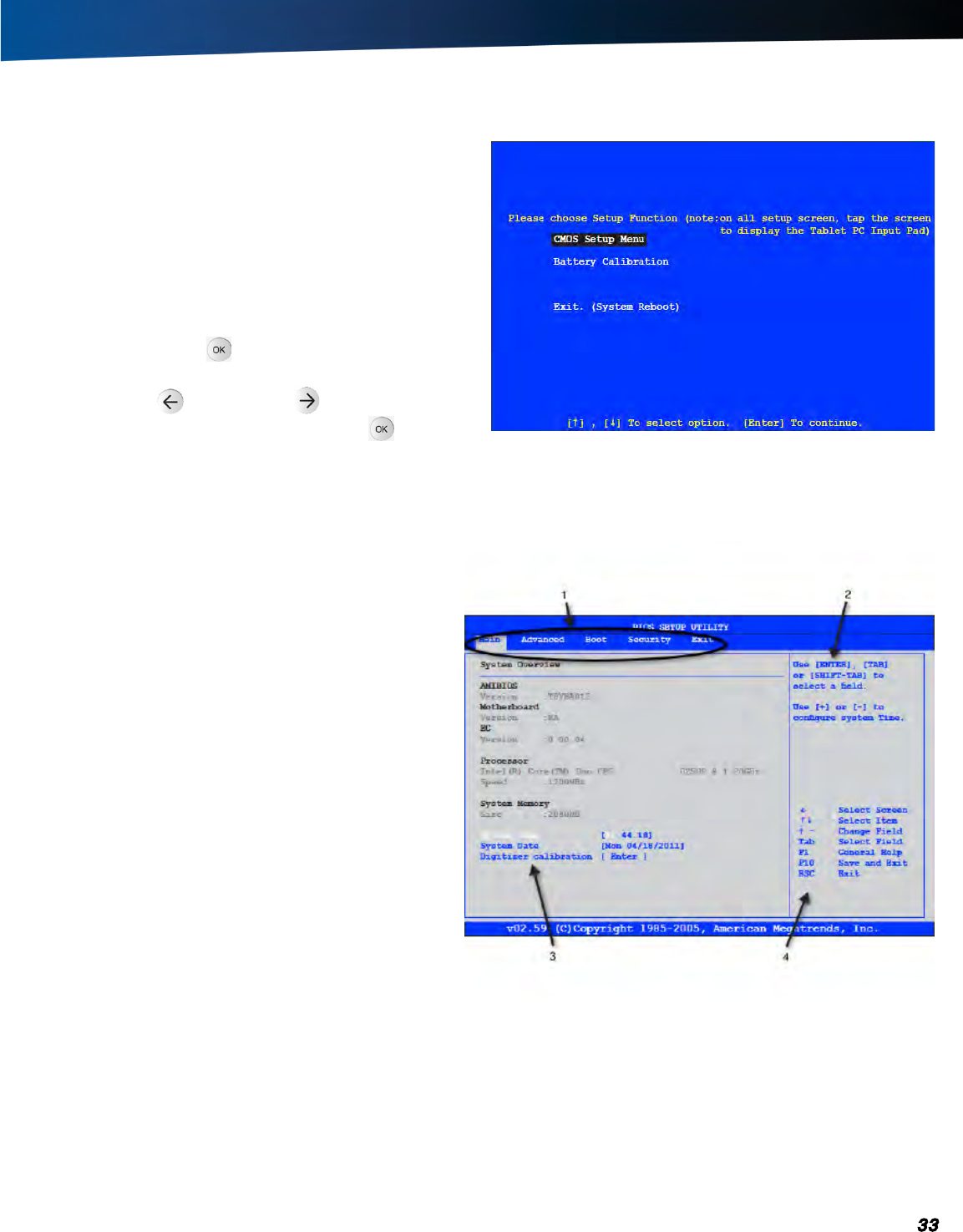
General Dynamics Itronix | 72-0145-001
GD3080 User Guide
The BIOS Setup Utility allows you to configure your computer’s basic
settings. When you turn your computer on, the system reads this
information to initialize the hardware so that it will operate correctly.
You can use the BIOS Setup Utility to change your computer’s start-
up configuration. For example, you can change your system’s security
routine.
Starting the BIOS Setup Utility
You can only start the Setup Utility shortly after the computer
has been turned on. When you see the message “Press Enter
button to enter SETUP” display at the bottom of the screen,
press the OK/ENTER key .
You will then see the following screen:
Use your LINE UP or LINE DOWN hot keys to highlight
“CMOS Setup Menu” and press the OK/ ENTER key. The
system will start the Setup Utility and display the main menu
of the utility.
Caution Incorrect settings can cause your system to malfunction. To correct mistakes, return to Setup and restore the Setup
Defaults by going to the Exit Menu and selecting “Load Optimal Defaults”.
Navigation and Help
The Menu Bar
The Setup Utility has five menu options in the Menu Bar (1)
at the top of the window. To navigate between the screens
you must tap on the screen with the pen/stylus to see the
Tablet PC Input Pad and use the arrow keys or attach a USB
keyboard.
The Tablet PC Input Pad is used to navigate through BIOS
screens:
main Use for basic system configuration
advanCed Use to set the advanced features
boot Use to select the sequence of boot devices that are
searched to load an operating system.
seCurity Use to set user and supervisor passwords
exit Use to exit the current Setup session
The Field and General Help Windows
the Field helP WindoW (2) is on the right side of each
menu. It displays the help text for the currently selected
field. This text updates as you move the cursor from field to
field.
the Field list (3) is on the lower left side of the BIOS Setup Utility screen. It displays the actual field titles and entry fields for the
BIOS settings.
the navigation menu (4) is on the lower left side of the BIOS Setup Utility screen. It displays the navigation keys used with an
external keyboard.
note The Field Help Window refers to keys that are only available via an external USB keyboard. If you do not have an external
keyboard attached to your GD3080, use the Setup Utility’s Tablet PC Input Pad described below:
BIOS Setup Utility
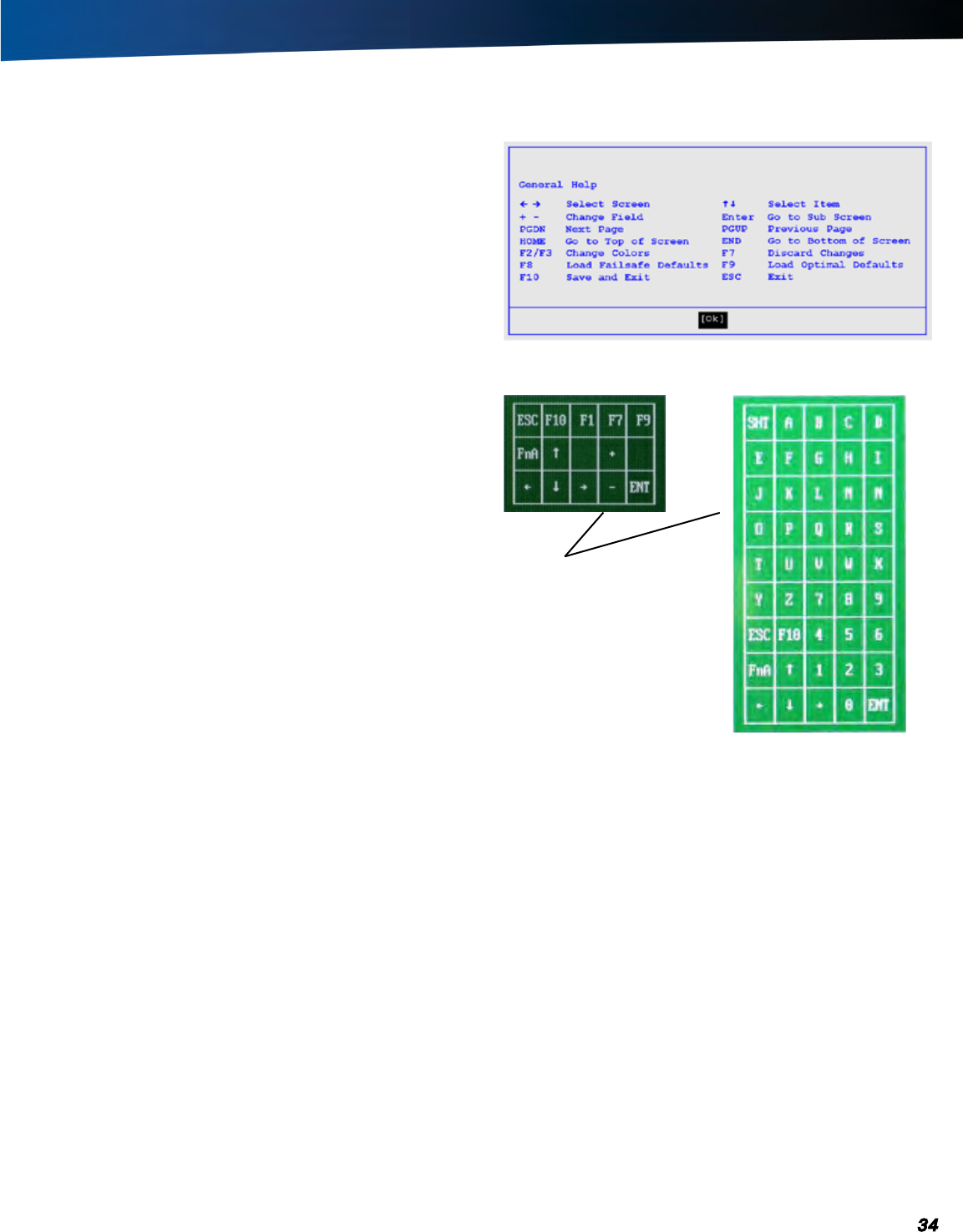
General Dynamics Itronix | 72-0145-001
GD3080 User Guide
BIOS Setup Utility
the general helP WindoW describes the Tablet PC Input Pad
keys and their functions. You can access it by selecting F1 on
the Tablet PC Input Pad. However, the following keys are not
available during Setup unless you have an external USB key-
board attached to the Tablet PC:
HOME
F2/F3
F8
END
Tablet PC Input Pad
The Setup Utility has a unique Tablet PC Input Pad that appears
when you hover over or tap your pen anywhere on the screen.
Use the Tablet PC Input Pad to navigate between setup
screens, between fields on each screen and to make any field
changes. To avoid making unintentional field changes, we
recommend you do not open the panel from the bottom right
side of your screen. Instead, tap anywhere on the left side of
the display.
To navigate between the five menu screens, tap the left or right
arrows on the input pad. To toggle through the fields, tap the
up and down arrows. Alternately, you can use the LINE UP and
LINE DOWN hot keys to toggle through the fields. Press the
OK/ENTER key to view a list of options for each field.
If you need to input characters, tap FNA on the Tablet PC Input
Pad to expand it to a larger Tablet PC Input Pad that includes
characters. Press FNA again to return to the small input pad.
note The Tablet PC Input Pad disappears after a few sec-
onds of inactivity and when you change screens.
The Tablet PC Input Pad
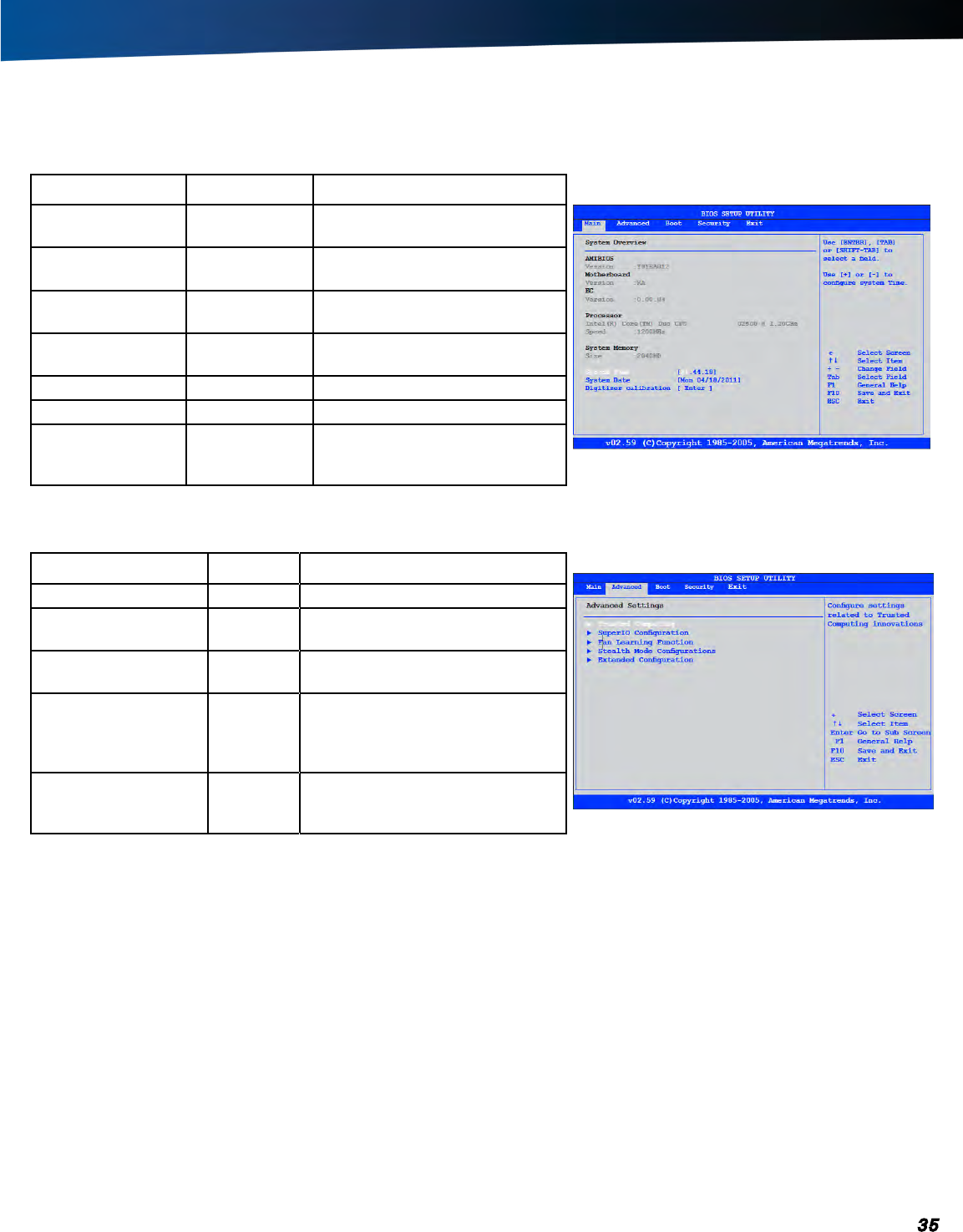
General Dynamics Itronix | 72-0145-001
GD3080 User Guide
BIOS Setup Utility
The Main Menu
Field Setting Function
AMIBIOS For information
only
Version
Motherboard For information
only
Version
Processor For information
only
Type and Speed
System Memory For information
only
Size
System Time HH:MM:SS Configure system time
System Date MM/DD/YYYY Configure system date
Digitizer Calibration Opens the Digi-
tizer Calibration
Utility
Begins the digitizer calibration.
Once you have calibrated the dis-
play, the computer will restart.
The Advanced Menu
Field Setting Function
Trusted Computing Sub-Menu Configure settings related to TPM
SuperIO Configuration Sub-Menu Configure I/O port interrupt and IRQ
settings
Fan Learning Function Sub-Menu Fan Learning Function will take 2
minutes to finish procedure
Stealth Mode
Configurations
Sub-Menu Depending on Stealth Mode setting,
LED, FAN Beeps, LCD Brightness,
Audio and Wireless devices will
keep silent when you need
Extended
Configuration
Sub-Menu Other special function settings
including low battery beep, radio
wakeup, etc.
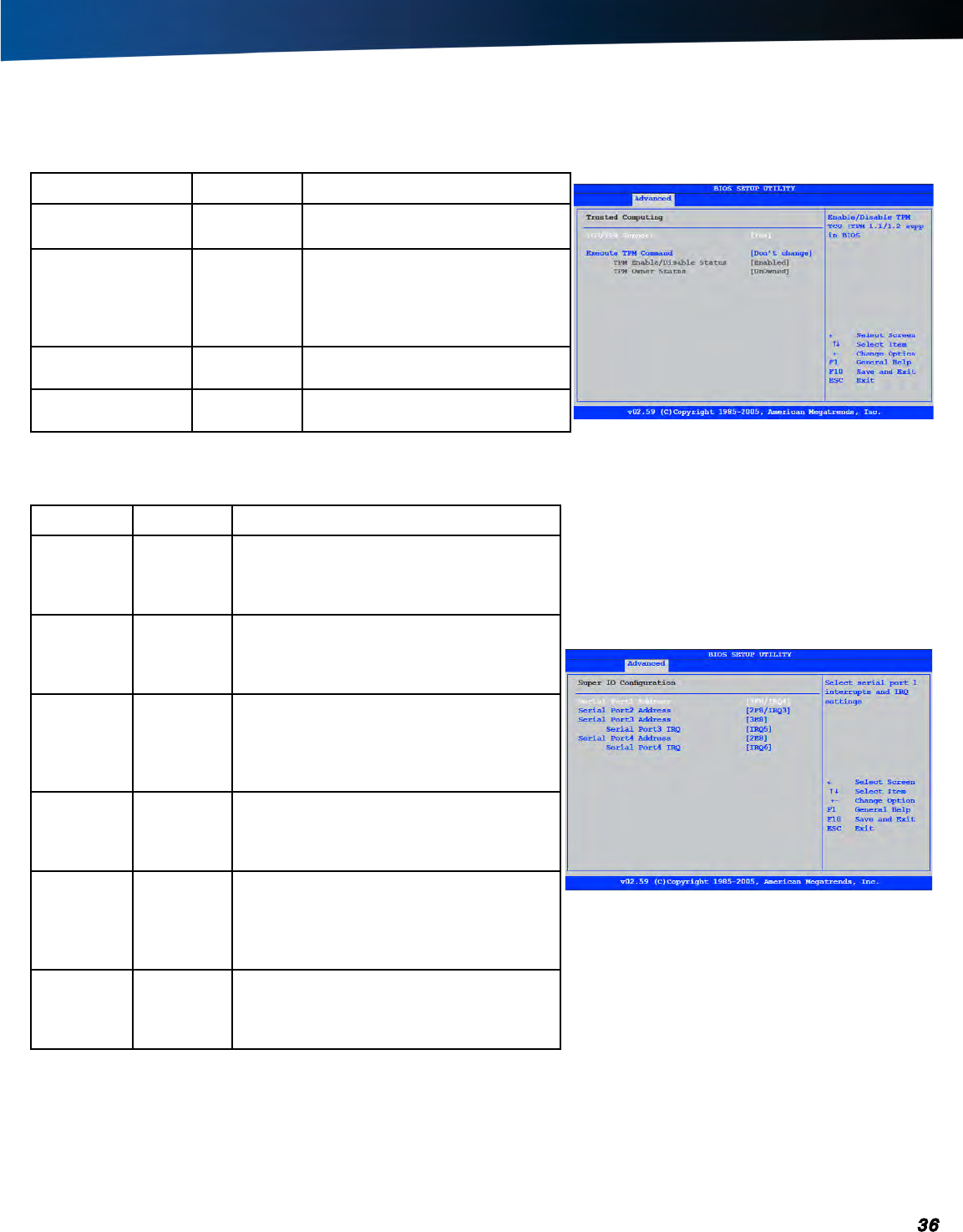
General Dynamics Itronix | 72-0145-001
GD3080 User Guide
BIOS Setup Utility
Trusted Computing
Field Setting Function
TCG/TPM Support yes
No
Enable/Disable TPM TCG (TPM
1.1/1.2) support in BIOS
Execute TPM
Command
don’t
Change
Disabled
Enabled
Enable (Activate) / Disable (Deacti-
vate) / Don’t change (leave settings
in last configuration)
Enable (Activate) / Disable (Deacti-
vate) Command to TPM
TPM Enable/Disable
Status
Disabled This displays the current status of
the TPM
TPM Owner Status Unowned This displays the current Ownership
status of the TPM
SuperIO Configuration
Field Setting Function
Serial Port1
Address
Disabled
3F8/irq4
3E8/IRQ4
2E8/IRQ3
Select serial port 1 interrupts and IRQ set-
tings
Serial Port2
Address
Disabled
2F8/irq3
3E8/IRQ4
2E8/IRQ3
Select serial port 2 interrupts and IRQ set-
tings
Serial Port3
Address
Disabled
3F8
2F8
3e8
2E8
Sets address for serial port 3
Serial Port3
IRQ
IRQ4
IRQ5
IRQ10
IRQ11
Sets IRQ for serial port 3
Serial Port4
Address
Disabled
3F8
2F8
3E8
2e8
Sets address for serial port 4
Serial Port4
IRQ
IRQ3
irq6
IRQ10
IRQ11
Sets IRQ for serial port 4
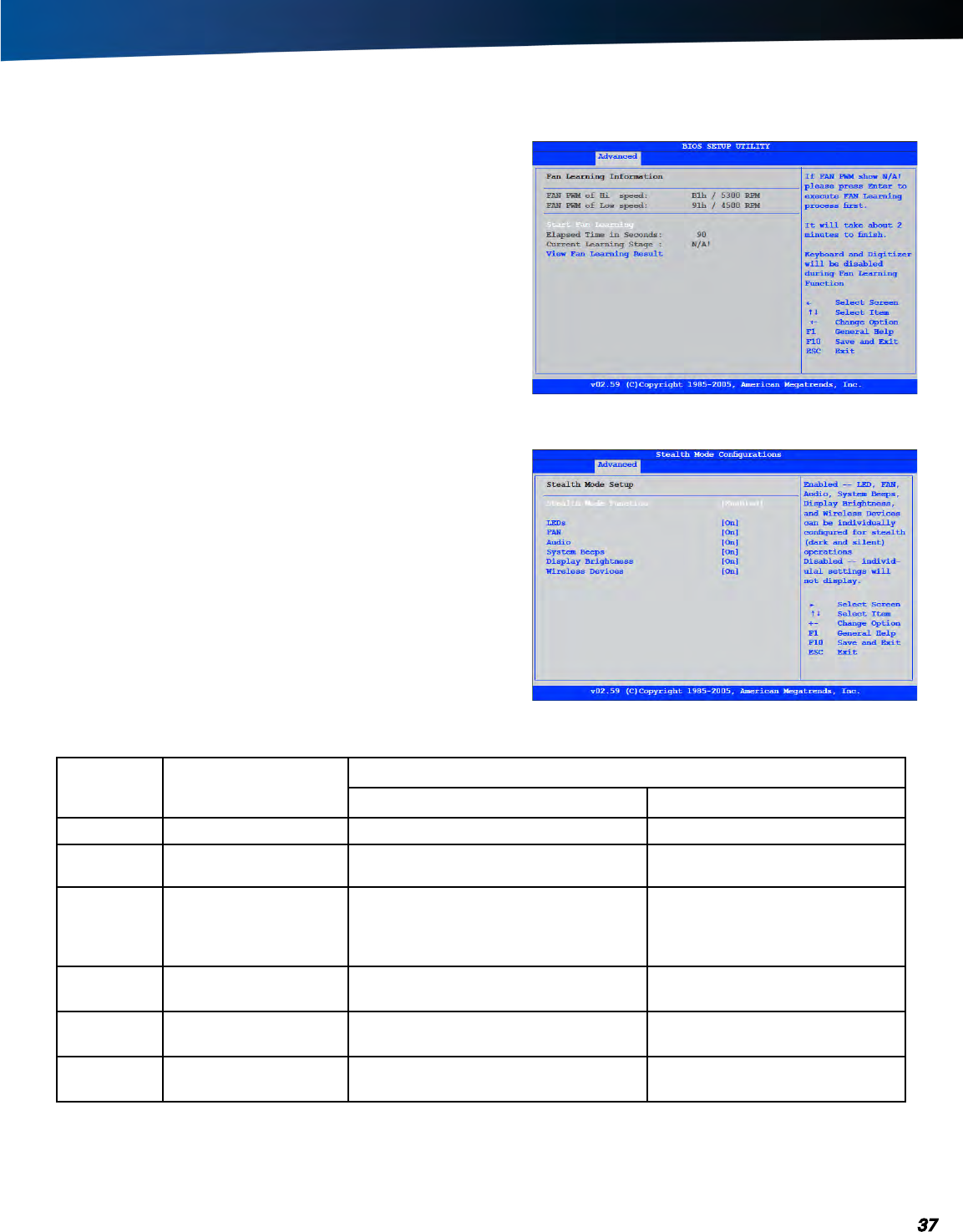
General Dynamics Itronix | 72-0145-001
GD3080 User Guide
BIOS Setup Utility
Fan Learning Function
The purpose of the Fan Learning Function is to calibrate the
fan’s performance. The fan’s throughput will be decreased
over time and the Fan Learning Function adjusts the fan’s
efficiency allowing the fan to operate properly.
Stealth Mode Setup
The GD3080 has stealth mode capability so it can be used in an
environment where sound and light could be dangerous to the
user.
If stealth mode is set to Disabled, the LEDs, fan, system beeps,
audio, display brightness, and wireless devices operate nor-
mally. If stealth mode is Enabled, you can individually set each
option to On or Off.
Option Stealth Mode
Function Disabled Stealth Mode Function Enabled
On Off
ledsLEDs function as normal All LEDs function normally LEDs remain off (not lit)
Fan Fan functions as normal Fan functions normally FAN does not run (beware of over-
heating the unit)
audio Audio functions as
normal. (The default
volume level is set to
mid range.)
Audio volume levels are maintained
when unit powers up
Audio volume is set to zero when
unit powers up
system
beePs
Beeps are heard during
POST.
System beeps (battery low, no boot
device)
System beeps are disabled
disPlay
brightness
The default brightness
level is mid range.
Brightness levels are maintained when
unit powers up
Brightness levels set to zero when
unit powers up
Wireless
deviCes
Wireless devices func-
tion as normal.
All wireless devices are turned on when
unit powers up
All wireless devices are turned off
when unit powers up
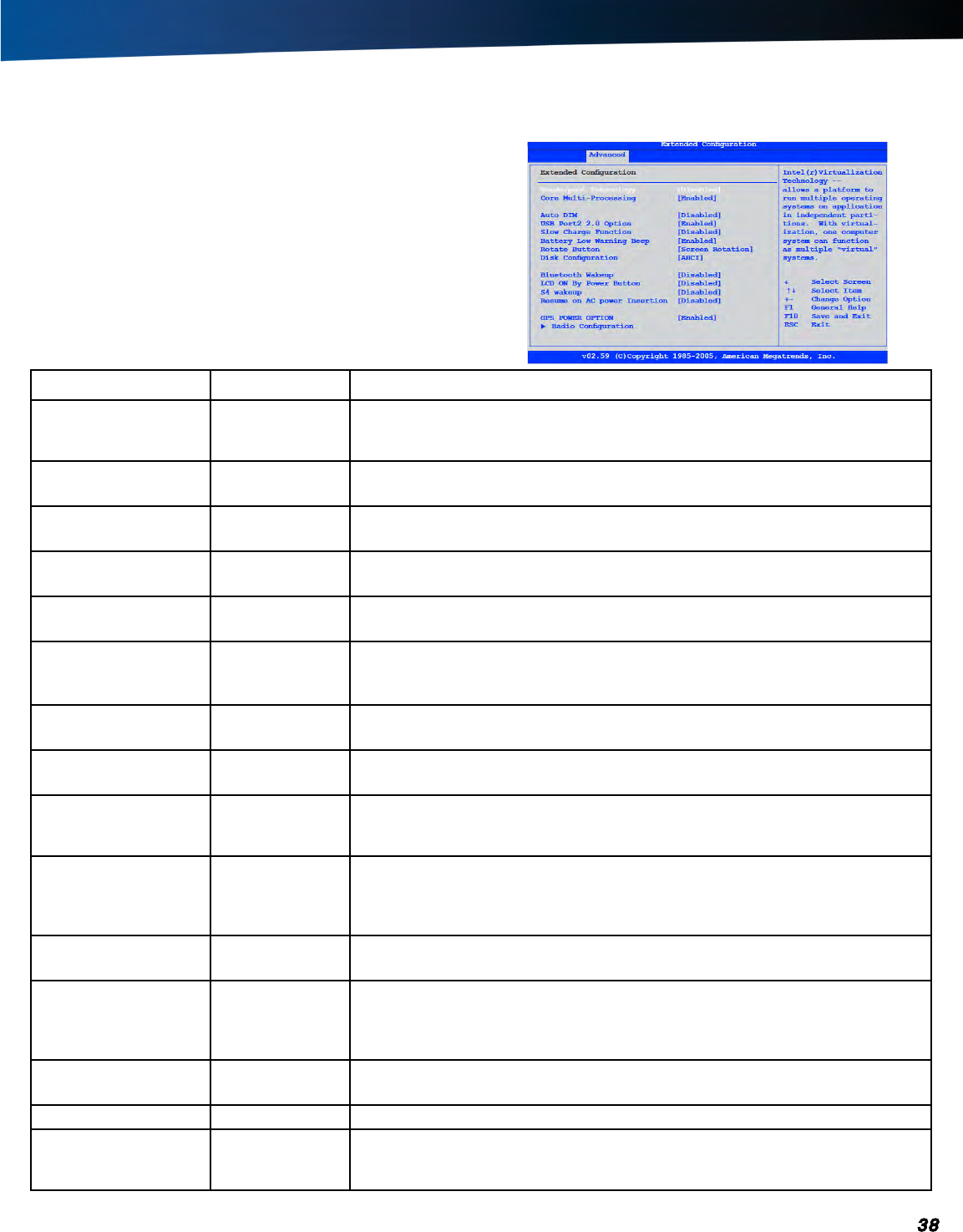
General Dynamics Itronix | 72-0145-001
GD3080 User Guide
BIOS Setup Utility
Extended Configuration
Field Setting Function
Vanderpool Technology enabled
Disabled
Intel (r) Virtualization Technology -- allows a platform to run multiple operating
systems an application in independent partitions.
With virtualization, one computer system can function as multiple “virtual” systems.
Core Multi-Processing enabled
Disabled
Enabled -- Use multi-processing core
Disabled -- Use only one processor core
Auto DIM disabled
Enabled
Enabled -- Display will dim slightly when on battery power.
Disabled -- Display brightness will not dim when on battery power.
USB Port2 2.0 Option enabled
Disabled
Enabled = bottom/backside USB port is USB 2.0
Disabled = bottom/backside USB port is USB 1.1
Slow Charge Function disabled
Enabled
Enabled -- Slow charge function is enabled
Disabled -- Battery charges at normal rate
Battery Low Warning
Beep
enabled
Disabled
Enabled -- System will sound 3 beeps every 10 seconds if battery charge drops
below 7%
Disabled -- System will not sound if battery is low
Rotate Button sCreen rotation
Backlight Toggle
Screen Rotation -- Pressing Rotate button will rotate screen.
Backlight Toggle -- Pressing Rotate button will toggle the backlight on and off.
Disk Configuration ide
AHCI
IDE Combined -- Standard IDE Configuration Mode
AHCI Mode -- Advanced Configuration Mode for SATA drive
Bluetooth Wakeup disabled
Enabled
Enabled -- System will awake up from standby if a Bluetooth signal is detected
Disabled -- System will not awake up from standby if a Bluetooth signal is
detected
LCD ON By Power
Button
disabled
Enabled
Enabled -- If display is set in OS to turn off, it will turn back on with power button
during runtime.
Disabled -- Display will not turn on with power button during runtime; pressing
button will cause the unit to hibernate.
S4 Wakeup disabled
Enabled
Enabled -- System will awake up from standby if S4 signal is detected
Disabled -- System will not awake up from standby if a S4 signal is detected
Resume on AC power
Insertion
disabled
Enabled
Enabled -- System will wake from standby or hibernation state when AC power is
inserted.
Disabled -- System will not wakeup when AC power is inserted. Power button will
cause unit to hibernate if pressed.
GPS Power Option disabled
Enabled
Turn on/off GPS
Radio Configuration Sub-Menu Radio function settings, including Bluetooth and Wireless LAN
OSPM Performance
Counter
0
1
Select the following timers for OS power management to be used:
1 = OS uses ACPI Power Management Timer
0 = Allow OS to use either ACPI Management Timer or Internal Processor Clock
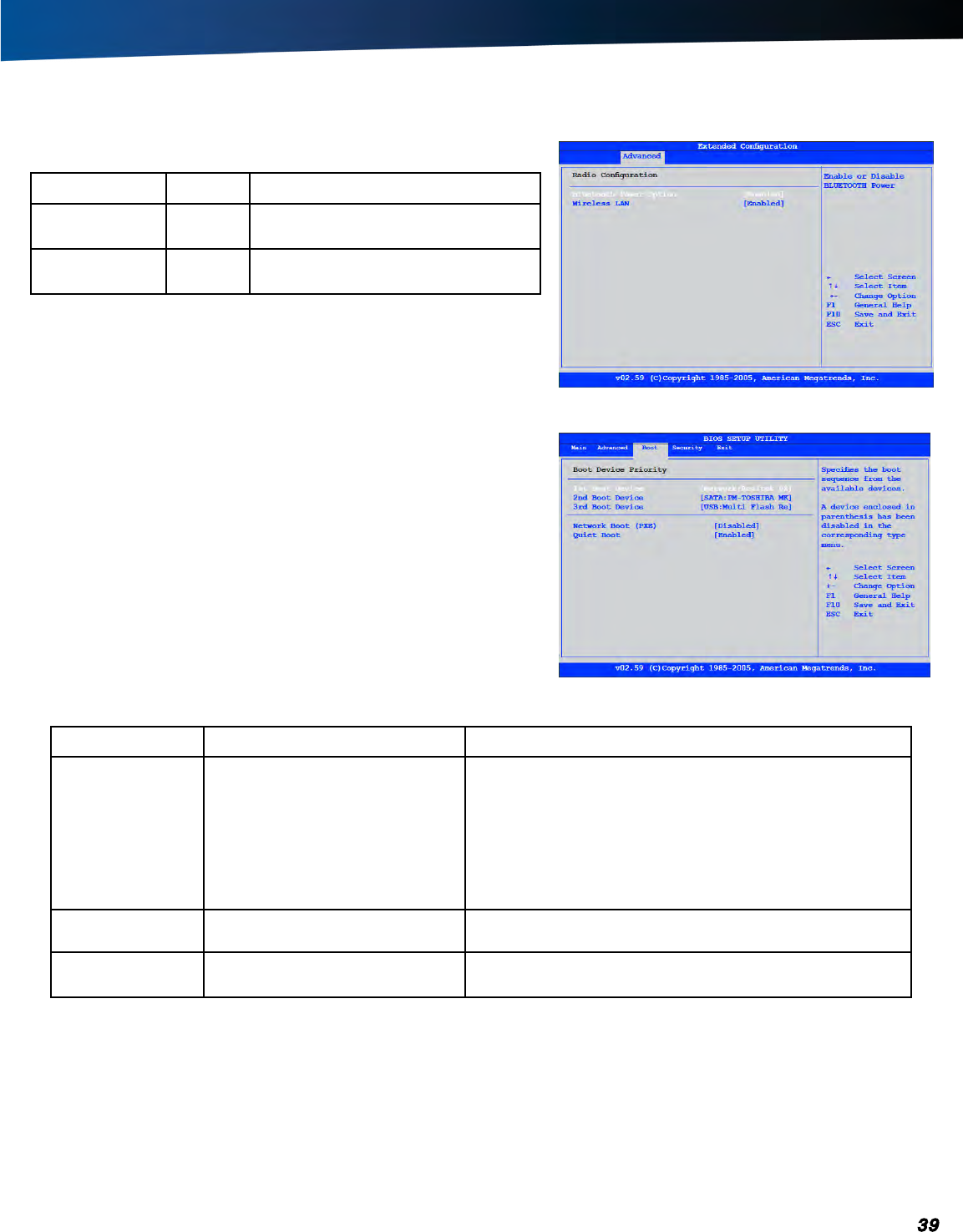
General Dynamics Itronix | 72-0145-001
GD3080 User Guide
BIOS Setup Utility
Radio Configuration
Field Setting Function
Bluetooth Power
Option
enabled
Disabled
Enable or disable Bluetooth power
Wireless LAN enabled
Disabled
Enable or disable Wireless LAN
The Boot Menu
Field Setting Function
1st Boot Device
(multiple devices
may be displayed)
Removable Dev.
CD/DVD
hdd: sata:Pm-toshiba mk
Network:Realtek Boot Agent
USB Device
Disabled
Specifies the boot sequence from the available devices. A
device enclosed in parenthesis has been enabled in the cor-
responding type menu.
Removable Devices = FDD
CDROM = CDROM
Realtek Boot Agent = Ethernet boot
note There are a variety of boot devices available, only cur-
rently installed options are displayed
Network Boot (PXE) Enabled
disabled
If Enabled boot from the network becomes available.
Quiet Boot enabled
Disabled
If Disabled: Displays normal POST messages. If Enabled:
Displays OEM Logo instead of POST messages.
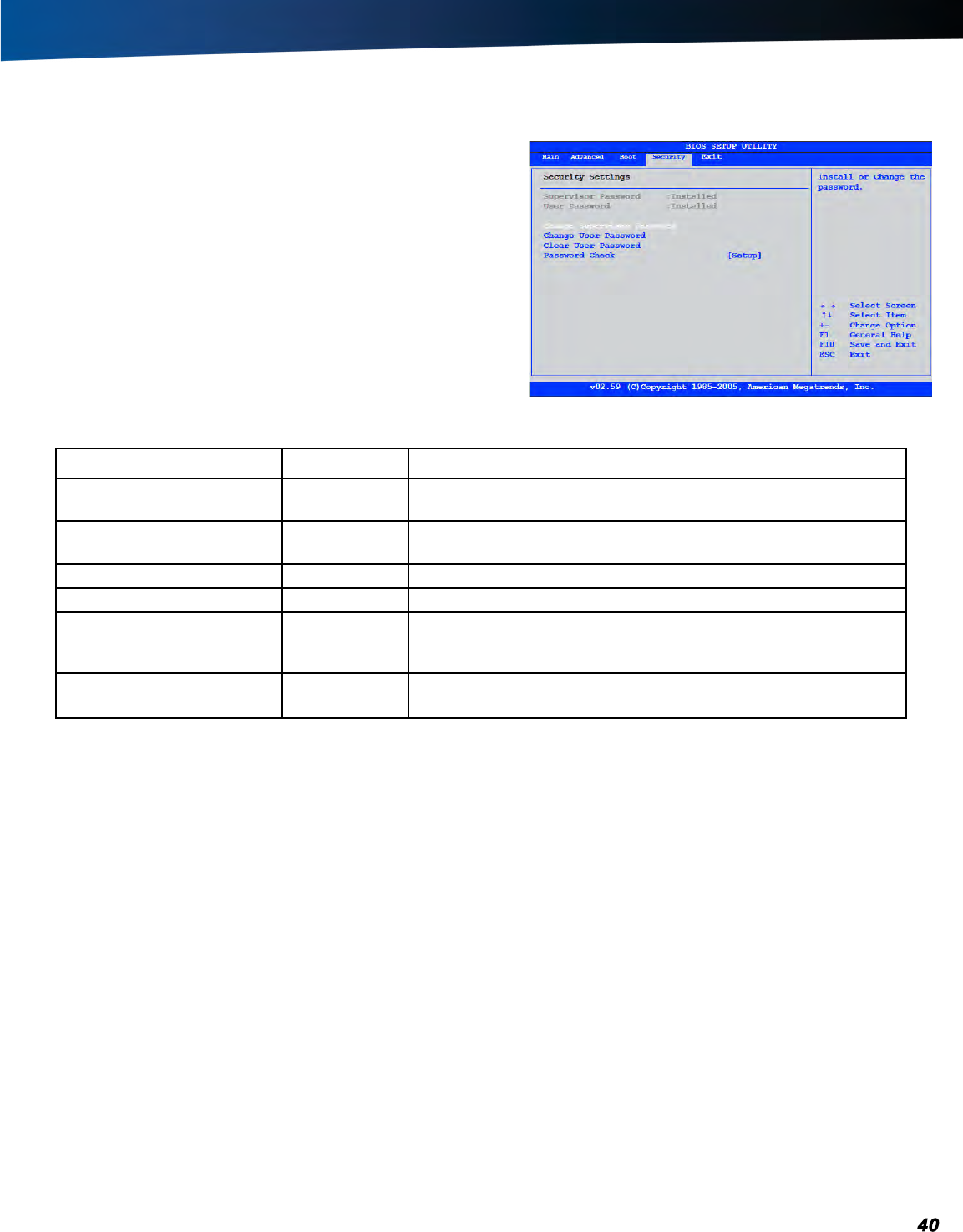
General Dynamics Itronix | 72-0145-001
GD3080 User Guide
BIOS Setup Utility
The Security Menu
Field Setting Function
Supervisor Password Installed
not installed
Information Only
User Password Installed
not installed
Information Only
Change Supervisor Password N/A Install or Change the password
Change User Password N/A Install or Change the password
Clear User Password N/A Clears/Removes the User Password
(NOTE: This option only displays if a User Password has been
installed)
Password Check setuP
Always
Determines when a password is required by the system.
note This option only displays if password(s) are installed
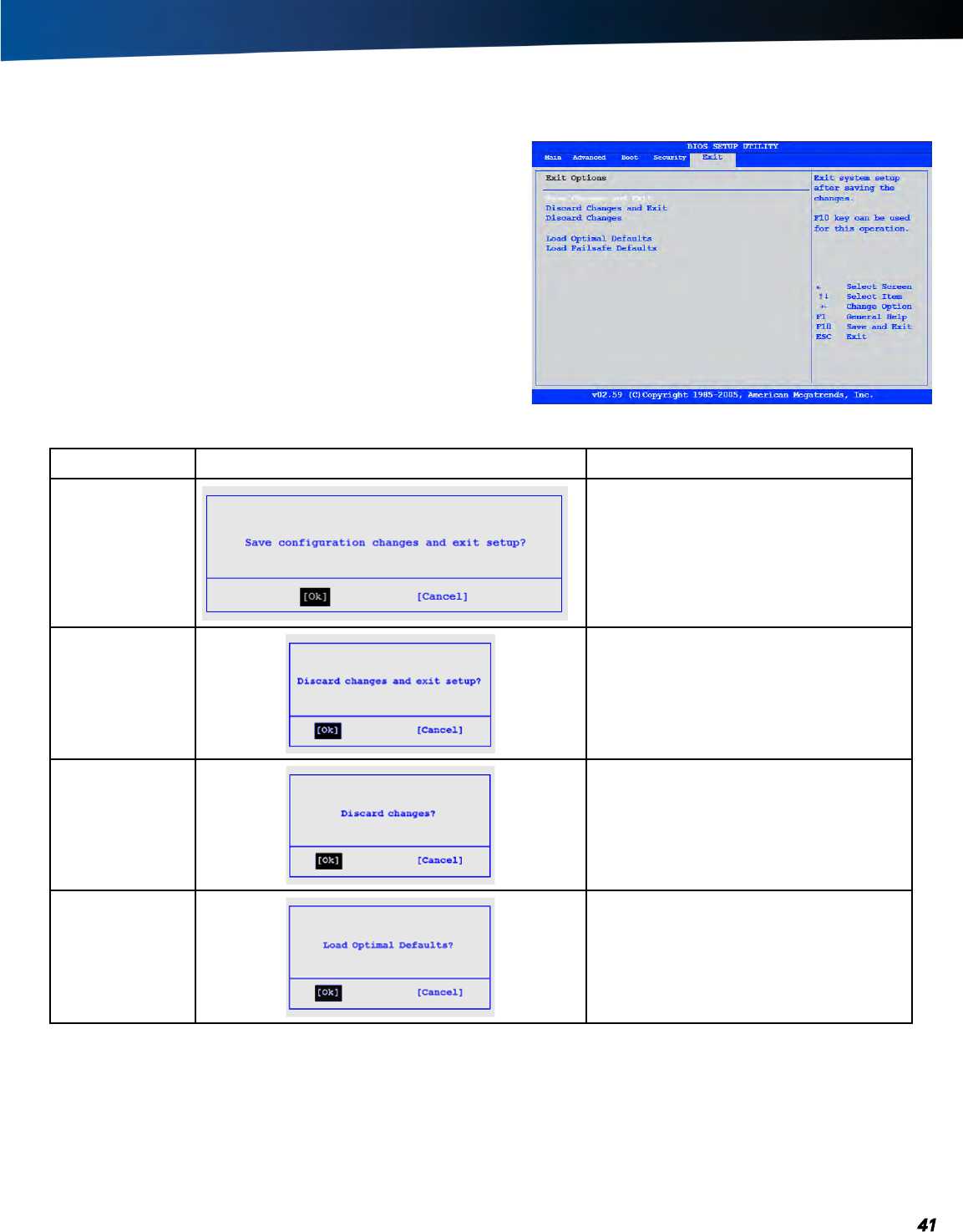
General Dynamics Itronix | 72-0145-001
GD3080 User Guide
BIOS Setup Utility
The Exit Menu
Field Screen Function
Save Changes and
Exit
Exit system setup after saving the changes.
F10 key can be used for this operation
Discard Changes
and Exit
Exit system setup without saving any
changes. Esc key can be used for this opera-
tion.
Discard Changes Discards changes done so far to any of the
setup questions. F7 key can be used for this
operation.
Load Optimal
Defaults
Load Optimal Default values for all the setup
questions. F9 key can be used for this opera-
tion.

General Dynamics Itronix | 72-0145-001
GD3080 User Guide
The GD3080 is rugged and weather resistant. Handle it with the
normal care required by any sophisticated electronic equipment,
and the computer will provide reliable service even under harsh field
conditions.
Follow the guidelines in this section to care for your unit.
Battery Maintenance and Storage
Maintaining Batteries
Follow these guidelines to maintain performance of Lithium-
Ion (Li-on) batteries.
Avoid exposing batteries to extremely hot or cold temperatures
for long periods. To prevent possible damage to the battery, the
GD3080 does not allow the battery to charge if the internal tem-
perature of the battery gets too low (< 5°C or < 41°F) or too high
(> 50°C or > 122°F).
Charge the battery nightly where the temperature will remain
around 20°C (68°F).
Re-calibrate your battery every three months or when your bat-
tery performance degrades.
Storing Batteries
Store the battery within the recommended temperature range:
10°C to 30°C (50°F to 86°F).
Unused or stored batteries can lose power over time. When you
install a battery that has not been used for awhile, connect exter-
nal power to the computer and charge the battery.
After storage, battery calibration may increase its capacity.
Tablet PC Maintenance and Storage
Maintaining Your Tablet PC
Follow these guidelines to help maintain the condition and
performance of your computer.
Turn off the computer when you are not using it.
Charge the batteries daily or whenever their capacity is low.
Operate the computer within the recommended temperature
ranges of -23°C to +60°C (-9.4°F to +140°F).
Care and Cleaning
PhysiCal insPeCtion Periodically inspect the computer and
accessories for wear, damage, loose or missing parts. Identify-
ing and correcting potential problems early can help reduce
the need to return the unit for service.
outside Case Like all tools, the outside of the computer will
get dirty with use. The case is made of painted magnesium
and polycarbonate blend (plastic) doors and covers. These
areas can be cleaned with a solution of one part mild cleanser
and one part water. Do not use ammonia, abrasive cleaners, or
bleach as this may damage the unit. To clean the outside case,
follow the procedure below.
1. Disconnect external power and turn off the computer.
2. Using a soft, dry cloth (do not use paper products because they
can scratch the surface, add a small amount of cleaning solu-
tion to the cloth and clean the computer case.
3. Wipe off any excess liquid with a soft cloth.
disPlay Periodically inspect the display to make sure the
brightness function is operating properly and that all pixels are
operational. To clean the display assembly, use the same clean-
ing solution and procedure described earlier for the outside
case. In some cases, you can use a small amount of isopropyl
alcohol to remove streaks or smears. Use a soft, clean cloth to
clean the display. Do not use paper products because they can
scratch the screen. A Display Cleaning Kit is available.
external PoWer ConneCtor The external power connector
may sometimes be exposed to moisture and/or contamination
causing an unreliable connection to the external power source.
Clean the connector using a cotton swab dipped in isopropyl
alcohol.
rJ-11/ rJ-45 / usb ConneCtors Make sure these con-
nectors are operating properly. During normal use, the con-
nector pins can get dirty or become broken, bent, or pushed
out of place. Clean the connector with a cotton swab dipped in
isopropyl alcohol.
i/o Ports Make sure the audio and Multi-IO ports are oper-
ating properly. Periodically inspect the ports for damage or
contamination, and make sure their covers are attached and
closed when not in use. The I/O covers can be replaced without
returning the unit for service. Contact your local support per-
son for more information.
PC Card door and ConneCtor Whenever possible, make
sure this door is closed and latched properly. When the PC
Card door is closed, it provides a watertight seal for the PC
Card socket. Shield the area from all contaminants such as
liquids, rain, snow, and dust when the door is open.
Make sure the PC Card connector is operating properly by
reading from or writing to a PC Card.
Storing Your Computer
If you plan to store the computer, please follow the storage
guidelines listed below.
Files and data should be saved before storing the computer.
Contact your organization’s help desk about the procedure for
backing up files or data.
Exit all applications and use the appropriate procedure to exit
from your operating system.
Turn off the computer by going to the Start menu and selecting
Shutdown.
Remove the battery from the unit and store it in a dry place.
Maintenance and Storage

General Dynamics Itronix | 72-0145-001
GD3080 User Guide
Maintenance and Storage
Store the computer within the recommended temperature
ranges of -55°C to +75°C (-67°F to +167°F).
If you use PC cards, refer to the manufacturer’s instructions you
received with the card for storage and care information.
Data Backup
Regularly backup your data to ensure the greatest data
integrity, provide the fastest recovery options, and minimize
downtime.
After you have installed all applications and have your
computer configured as desired, create a backup of drive C:
using the Hard Disk Backup and Recovery Utility. Then use
the Windows® Backup Utility frequently to backup data. It is
recommended you set the backup utility to run automatically.
Saving Important System Information
By default your computer is set up to automatically save
certain critical information, such as the registry, on a regular
basis. This information is saved as a restore point. You can also
create restore points manually by using the System Restore
Utility. Select Start, All Programs, Accessories, System Tools,
System Restore. Then, follow the instructions in the Wizard.
Backing Up Files in Windows® XP:
Select Start, All Programs, Accessories, System Tools, Backup.
You can schedule backups to run automatically on a regular
basis. To set this up, talk to your help desk or IT department.
Backing Up Files in Windows® 7:
Select Start, Control Panel. Under System and Security select
Back up your computer. From here you can set up backup, cre-
ate a system image or create a system repair disc.
Backing Up Drive C:
You can make an exact copy of drive C: and save the backup
image on the Recovery Partition of your hard disk (usually drive
D:). In the future, you can restore drive C: to its previous state
if it becomes corrupted. To make a backup copy of drive C:,
use the Hard Disk Backup and Recovery Utility. Select Start,
All Programs, Mobile Computer Tools, Hard Disk Backup and
Recovery. You will be prompted for additional information.
note The Hard Disk Backup and Recovery Utility is only
available on computers configured with a recovery partition.
Data Recovery
There are several methods to restore your data. Start with the
least destructive and fastest recovery options, listed below in
the order in which you should restore data.
1. Restore system information.
2. Restore a backup using the Windows® Backup Utility.
3. Restore the entire contents of drive C:
Option 1: Restoring System Information
Windows® XP:
If you have problems with your system, restore system infor-
mation to an earlier state, or Restore Point. Select Start, All
Programs, Accessories, System Tools, System Restore. Then,
follow the instructions in the Wizard.
Windows® 7:
Select Start, Control Panel, System and Maintenance, Backup
and Restore Center. On the Tasks menu on the left-hand side
of the screen select Repair Windows® using System Restore.
Option 2 : Restoring a Backup
Windows® XP:
Select Start, All Programs, Accessories, System Tools, Backup.
Then follow the instructions in the wizard to restore files and
settings.
Windows® 7:
Select Start, Control Panel, System and Security. Under
Backup and Restore select Restore files from backup. From
here you can select a backup file to restore.
Option 3: Restoring Drive C:
If you used the Hard Disk Backup and Recovery Utility to create
a backup disk image you can use it to restore drive C:.
Caution Restoring a previously saved disk image
overwrites the entire contents of drive C:. Before running this
process, save your data to another location, such as a USB
flash drive.
note The Hard Disk Backup and Recovery Utility is only
available on computers configured with a recovery partition.
If it is not available, you will either need to contact your
company’s help desk about obtaining a recovery CD or return
your unit for service.
Windows® XP:
Select Start, All Programs, Mobile Computer Tools, Hard Disk
Backup and Recovery and follow the prompts.
Windows® 7:
Select Start, Control Panel, System and Security. Under
Backup and Restore select Restore files from backup then
select Recover system settings or your computer.
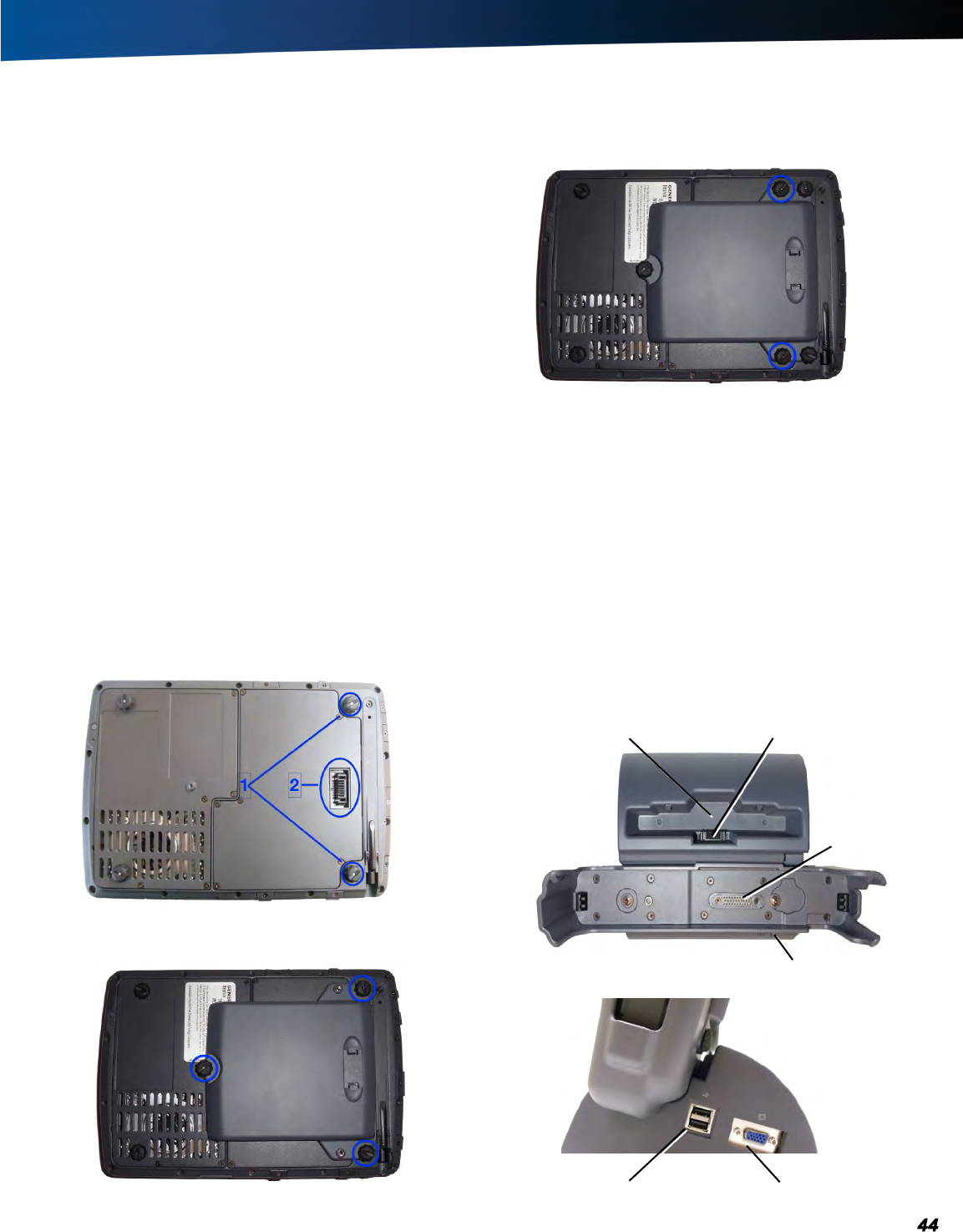
General Dynamics Itronix | 72-0145-001
GD3080 User Guide
The GD3080 has several equipment and accessory options to further
enhance your mobile computing experience.
A complete list of optional peripherals and accessories is listed
on the General Dynamics Itronix website.
Caution When purchasing any additional accessories,
purchase only those accessories that are approved for use with
your Tablet PC. Some accessories are proprietary items and
can be obtained through your system vendor. If you use items
that are not approved for use with this Tablet PC, you may
cause it to malfunction, or to emit or receive electromagnetic
radiation in excess of local regulations. For non-proprietary
accessories such as PC Cards or printers, ensure that the
accessory functions properly with your computer before mak-
ing the purchase. Your system vendor may be able to recom-
mend reliable brands and models.
Second Battery
For longer battery life, you can attach an optional second, exter-
nal battery to the connector on the back of the Tablet PC. The
external battery connector is sealed against the Tablet case.
Attaching a Second Battery
1. Remove the two left feet (1) on the back of the unit.
2. Line up the second battery connector (2) with the connector on
the external battery.
3. Press until battery is firmly seated.
4. Tighten the three screws to secure the battery in place.
5. Screw the feet into the battery for safekeeping.
6. Use the Setup Utility Calibration program to calibrate the
battery.
Desk Mount
The GD3080 ‘s desk mount enables you to experience desktop
functionality with your GD3080. The desk mount includes the
following ports:
Stand POGO connector (this is the unit interface)
DC in
2 USB 2.0 ports
15-pin CRT port for an external monitor
Extra battery charger
RJ45 connector
Optional Equipment
Extra Battery Charging Slot
Stand Holder Connector
(unit interface)
LED
15-pin CRT port for
External Monitor
USB 2.0 ports
POGO
Connector
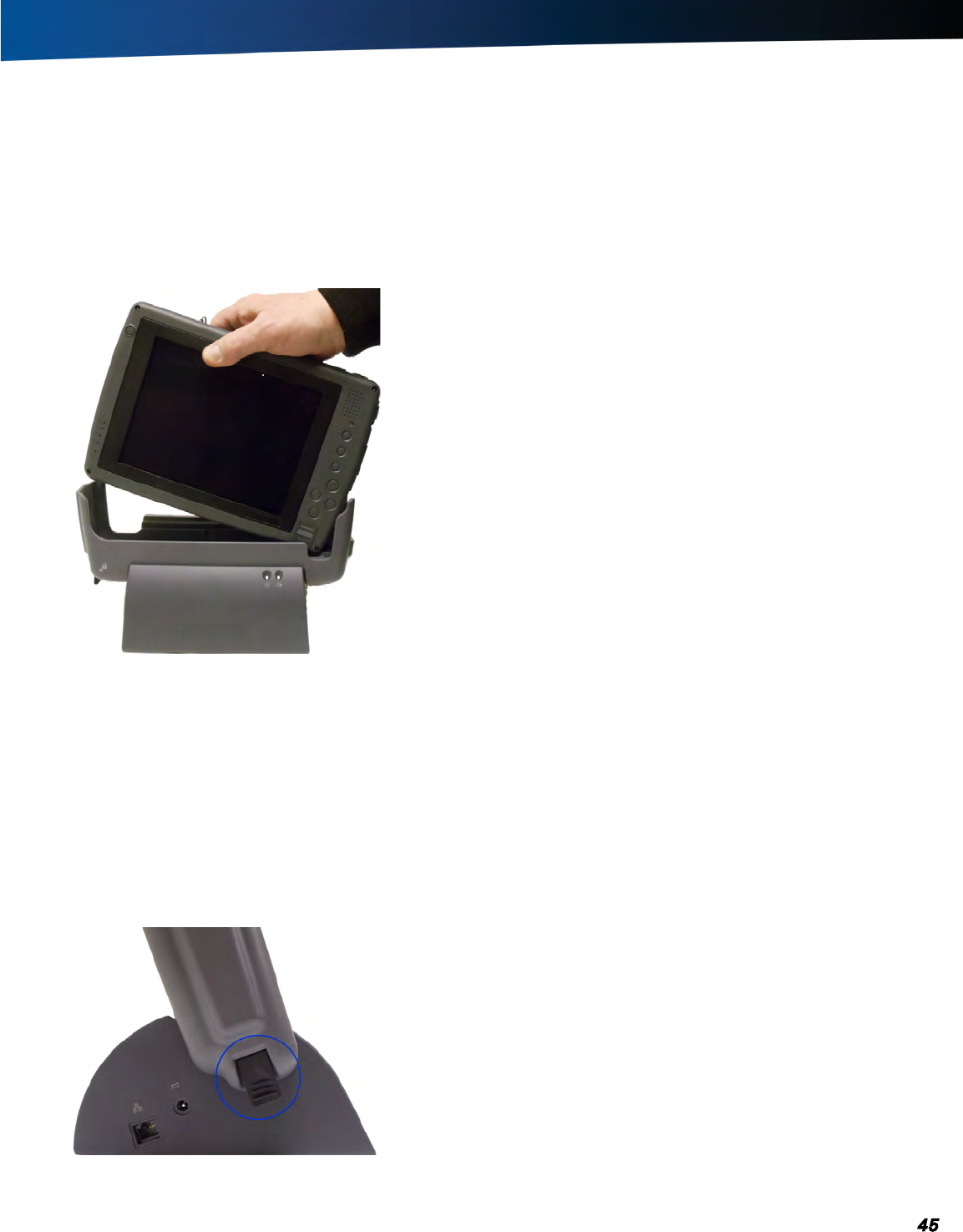
General Dynamics Itronix | 72-0145-001
GD3080 User Guide
Optional Equipment
To use the desk mount:
1. Ensure the port cover on the extension slot is open and the port
cover for the AC power is closed.
2. Line up the bottom of the unit with the guides and press down
while feeding the rubberized I/O port cover through the opening
provided. The unit will automatically lock into place.
3. Apply external power to the desk mount. The LED in the front
of the desk mount will light along with the Power Status LED
on the GD3080.
The desk mount includes a slot so you can simultaneously
charge the main battery and an additional battery.
note Power must be applied to the dock for the ports to
function.
To detach the desk mount:
1. Release the latch located on the lower left hand corner of the
desk mount to detach the GD3080.
2. Pull straight up to remove the GD3080 from the desk mount.
Memory Upgrade
Adding memory allows the computer to operate faster, handle
more tasks simultaneously, and work more efficiently with
large files. Users who increase memory demands by adding
additional programs may notice slower operating speeds. Add-
ing memory offsets this slowdown. The Tablet PC includes a
memory card slot for adding additional memory.
Calculate memory size by adding the size of the memory mod-
ule to the existing built-in memory. For example: 128 MB (mod-
ule) + 128 MB (built-in memory) = 256 MB Total. The maximum
memory configuration is 1.2 GB.
Inserting a Memory Card
If you add memory to your GD3080, it will automatically detect
the change in RAM (Random Access Memory) capacity when it
restarts. You can verify RAM capacity has changed in the BIOS
Setup Utility or in Windows®:
1. setuP: Press the OK/ENTER key during boot-up. Then select
CMOS Setup menu. This screen shows the amount of system
memory.
2. For WindoWs® xP: Right click (tap and hold) on My Com-
puter and select properties. The bottom of the System Prop-
erties, General tab lists the memory detected by Windows®.
3. For WindoWs® 7: Click on Start, select Computer and
select System properties. The bottom of the System proper-
ties, tab lists the installed memory detected by Windows®.
Caution Only use memory cards approved for use in your
Tablet PC. Failure to do so may void your warranty.
Surge Protection
A large number of computer and high technology equipment
damage is directly related to AC power and telephone line
problems. These problems can include surges, spikes, noise,
interference, and weather-related problems, which in turn
can cause glitches, hang-ups, crashes, performance slow
downs, and down time with computer equipment. The market
is flooded with hundreds of AC power line surge suppressors
advertising high performance surge protection; only a few of
them actually provide adequate protection.
Selecting the Right Surge Protection
Consider the level of quality you need when selecting a surge
suppressor. This depends on factors such as surge environ-
ment, the type of equipment to be protected, and the quality of
the electrical wiring and service.
Surge Environment
Surge environment refers to the damage potential from electri-
cal surges in a particular geographical area. A high quality
suppressor should be used if there is frequent lightning activity
in the area and the location service is fed by overhead utility
poles.

General Dynamics Itronix | 72-0145-001
GD3080 User Guide
Optional Equipment
Type of Equipment to be Protected
If the computer is equipped with a modem, the modem should
also be surge protected. Protecting the power line without pro-
tecting the modem line provides only partial protection.
Quality of Electrical Wiring and Service
Wiring should be up to current NEC standards and have veri-
fied good AC grounds. It is important that your computer
system be plugged into a grounded AC outlet when charging
and that all peripherals connected to your system reference the
same AC ground.
Equipment Selection
There are a number of companies that sell quality surge
suppressors. When you are looking for a surge suppressor,
consider these options.
Expect to pay at least $50 for a good quality surge suppressor.
The surge suppressor should be a UL 1449, 497, and 1283 listed
for surge suppression, modem surge protection, and RFI/EMI
noise filtering respectively.
The surge suppressor should have diagnostic LEDs that verify
good AC ground, proper wiring, and proper surge operation.
On/off switches that light are not recommended since they can
produce electrical noise.
The Joule ratings should be a minimum of 480 Joules for the AC
surge circuit.
The Joule ratings should be a minimum of 240 Joules for the
modem.
The modem surge circuit should present low capacitance to the
modem line or it will slow the transmission rate. Capacitance
should be specified at less than 50 picofarads.
Quality surge suppressor manufacturers generally offer a life-
time warranty.
Consider obtaining a protected equipment coverage policy which
insures the equipment in the event of surge damage.
The devices that will be attached to the computer also need to be
surge protected.

General Dynamics Itronix | 72-0145-001
GD 3080 User Guide
We are committed to providing you world class support services
that ensure the lowest total cost of ownership for your hardware
investment. The icareServices program will help you maximize end
user productivity and decrease overall system operating cost.
Client Care Center (CCC)
General Dynamics Itronix Client Care Center – The CCC is an
internal central point for telephone warranty support for all
General Dynamics Itronix products. Our Technical Service
Representatives know your product and provide input and sup-
port for problem resolution.
One call to the convenient Client Care Center number at (1-800-
638-9270, Opt 2) allows a single entry point of access to meet
all your needs.
You may also use the web portal at www.gd-itronix.com/CCC.
The CCC receives calls from 5am-5pm Pacific Daylight Time,
Monday through Friday (except on holidays). Sorry, 1-800
numbers ARE NOT accessible from Mexico.
Technical Service Representatives provide the following sup-
port services:
Product troubleshooting
RMA origination for service return
RMA status check on product service
Check status warranty/service kit orders
Coordinate requests for product upgrades
Wireless Radio registration
icareServeNet registration and training
General Dynamics Itronix offers service uplift programs for
clients who wish to expand their support coverage beyond the
basic warranty. Coverage and details of these programs are
available online at www.gd-itronix.com
Product Support - Downloads
It is easy to get the software updates you need to keep your
configuration current and get the most from your product. Click
here to get current downloads.
note Downloads are listed by model and product number
(GD3080).
Service and Support

General Dynamics Itronix | 72-0145-001
GD3080 User Guide
This section is designed to help you determine and fix problems you
might encounter while operating the GD3080.
Try the following steps in order:
1. First, look through the categories in this section for a solution.
2. If you do not find a solution for your problem here, try one of
the resources listed below under “For More Help.”
3. If you are having a problem with a computer application , use
the online help that comes with the application to find a solu-
tion.
4. If you still cannot resolve your problem, contact the help desk
at your organization.
For More Help
Windows® Help is already installed on your system. To access
this information, select Start, Help and Support.
Take the Windows® Tutorials. Select Start, Get Going with
Tablet PC.
Third-party Windows® manuals are available from your local
bookstore.
Applications
My application locks up, acts strangely, or produces
a General Protection Fault (GPF) error
Press CTRL+ALT+DEL to start the Logon Protector, then select
the Task Manager. Click the Applications tab on the Task
Manager and look for the application that is having problems.
If the application is hung, the Status column will say “Not Re-
sponding” after the task name. Click on the unresponsive task/
application, then click the End Task button.
If you have tried to resolve the problem and your application still
does not respond, you may need to restart your computer.
To restart your computer:
using WindoWs® xP: Select Start, Shut Down, Restart.
using WindoWs® 7: Select Start, Shut Down, Restart.
If the computer does not restart, the keyboard may be locked up.
Hold the Power Button for ten seconds or use the reset on the
bottom of the unit.
Caution! This will result in a loss of all unsaved data.
The data on the hard disk could be corrupted. Run CHKDSK.
Windows® may be out of memory or resources. You can try to
close some open programs to free up some memory or exit
Windows® and restart Windows® by selecting Start, Shut
Down, Restart.
Communications programs don’t seem to work or
they lock Windows®
When you first try to use your communications application, the
system responds with a message asking if you want to install
the modem. Answer “Yes” to this question and follow the
instructions on the screen to install it.
When I rotate the display to portrait orientation my
application does not work or does not display cor-
rectly
Some applications do not display or work properly in portrait
orientation due to the rugged nature of your Duo-Touch‘s dis-
play screen. Use these applications in landscape orientation.
Batteries
The battery does not charge
To prevent possible damage to the battery, the system will not
allow a charge if the battery temperature is extremely hot or cold
(such as in a closed, unattended vehicle). If possible, charge the
battery in a location with a moderate temperature of around 20°C
(68°F).
If possible, turn off the computer while the battery is charging.
If the battery is new or has been stored for a week or more, fol-
low this procedure:
1. Make sure the computer is turned off.
2. Unscrew and open the battery cover, then remove the battery.
3. Connect the AC adapter to the computer and an AC wall outlet,
and then turn on the computer by pressing the Power Button.
The Power Status LED will be solid blue when connected to
external power.
4. Let the computer complete the boot process. Then reinstall the
battery and replace the battery door.
5. Allow the system to remain idle for one hour with the AC adapt-
er connected to the computer. The Battery Status LED
is orange when the battery starts charging.
6. If the battery still fails to charge after an hour, remove the bat-
tery, wait several seconds, and then install it again.
7. If the battery does not begin charging within several min-
utes, return the unit for service.
The batteries take much longer than seven hours to
charge
Under moderate temperatures, about 21°C (70ºF), the comput-
er’s battery takes approximately 3 hours to completely charge
while suspended and 3-5 hours to charge while powered on.
Under extremely cold or hot temperatures, however, the bat-
tery can take up to 16 hours to fully charge.
The batteries don’t last very long
As your battery ages, the maximum capacity that it can hold
naturally decreases, and even the best maintained batteries
eventually need to be retired. Consider replacing the battery if
you are not getting the usage you need from it.
Troubleshooting

General Dynamics Itronix | 72-0145-001
GD3080 User Guide
Troubleshooting
The gas gauge isn’t full after charging the battery
This may indicate that the charging process terminated prema-
turely.
Calibrate the battery to align the gas gauge with the battery
capacity.
The gas gauge reads “full,” but the charging indica-
tor light is still lit
If you charge your battery daily, rely on the gas gauge read-
ing to determine battery capacity. The charging process may
continue even if the gas gauge reads full. External power can
be removed because the battery is virtually full.
My battery seems to have less and less capacity
If your battery is new, or if you are using it for the first time, you
will need to calibrate it prior to using it.
As your battery ages, the maximum capacity that it can hold
naturally decreases, and even the best maintained batteries
eventually need to be retired. Consider replacing the battery if
you are not getting the usage you need from it.
Hard Disk
The hard disk will not spin up so the computer can’t
boot up
This occurs if the unit is exposed to extremely low tempera-
tures. This is not a hardware failure associated with the hard
disk. Allow the computer to warm to room temperature. The
minimum cold or soft boot temperature is 5°C (41°F).
I can’t save files because the disk is full
Report this situation to your supervisor or your organization’s
help desk.
Disk Read Error
Any card in the PC card socket except for a properly formatted
memory card will cause this error since it is trying to read the
PC card.
Hard disk recovery
Your hard disk may have a recovery partition containing a
copy of the original drive C: factory disk image. If you have a
recovery partition, you can access it from Windows® or from a
bootable USB floppy or CD:
To recover your hard disk from Windows®
From within Windows®, select Start, All Programs, Mobile
Computer Tools, Hard Disk Recovery.
To recover your hard disk
1. Attach an external USB keyboard and an external USB floppy
or CD-ROM drive with the unit turned off.
2. Press F11 while the unit is booting up to get to the Boot Menu.
3. Select Disk Recovery from the menu.
Landline Modems
The modem doesn’t work
When you first try to use HyperTerminal or similar application,
the system responds with a message asking if you want to
install the modem. Answer “Yes” to this question and follow the
instructions on the screen to install it.
Make sure the communication settings are correct in your ap-
plication. Refer to the online Help for your application.
The modem doesn’t dial a number
Check these things:
If you are using an external modem, make sure the cables are
attached correctly.
Make sure your communications parameters are correct in your
application. Refer to the online Help for your application.
The modem dials and receives an answer but does
not establish a connection
You may have incorrect parameters selected for your application
to talk with the remote modem. Refer to the online Help for your
application.
You may need to adjust your modem’s baud rate or protocol
selection.
Communications programs such as HyperTerminal
don’t seem to work or they lock Windows®
If you are using the internal modem, be sure to specify the
proper communications port .
When you first try to use HyperTerminal or similar application,
the system responds with a message asking if you want to
install the modem. Answer “Yes” to this question and follow the
instructions on the screen to install it.
The modem dials and the answering modem gener-
ates tone, but our modem does not begin the train-
ing sequence to establish a connection
Although the problem may appear to originate from the com-
puter, the source of the problem is the answering modem. Try
setting up the answering modem to generate the correct V.22
tone, which can usually be done by sending an AT command to
the modem.

General Dynamics Itronix | 72-0145-001
GD3080 User Guide
Troubleshooting
Miscellaneous
The computer shuts off unexpectedly
The computer has entered suspend mode Suspend mode. Press
the power button to resume.
The battery capacity may be low. Connect external power to
charge the battery, or replace the battery with a fully charged
one.
The battery contacts may be dirty. Turn off the computer, remove
the battery, and clean the contacts.
The speaker volume is too high or too low
Increase the volume by pressing FN+ESCAPE; decrease the
volume by pressing FN+OK/ENTER KEY.
The computer won’t turn on
The battery may not be installed properly, or it may not be fully
charged. Make sure a fully charged battery is properly installed.
Connect external power to charge the battery if it is not charged.
If you are using the AC adapter, check the electrical outlet you are
using to make sure it is working properly.
If the GD3080 does not turn on, restart the computer by holding
down the Power Button for at least 10 seconds and then release
it.
If the Power Button does not work to reset the unit, press the
Master Reset Key on the back side of your GD3080.
The computer won’t turn off
Press and hold the Power Button for at least 10 seconds.
The computer enters suspend mode too quickly
When there is no activity for a period of time, the computer
turns off or enters suspend mode. To extend this time, use the
Power Management program and increase the non-activity
time to enter suspend.
The computer doesn’t automatically suspend
Check to make sure the COM ports are off. For example, exit any
application that uses COM ports.
Make sure external power is not connected. Depending on
power settings, some systems will not suspend automatically
when they are connected to external power.
Make sure the standby time is set properly in the Power Man-
agement program.
The system date and time are incorrect
Reset the correct date and time by choosing the Date/Time
icon from Control Panel and making the appropriate changes.
I receive an “out of memory” error message
Too many applications may be running at the same time. Close
applications you don’t need.
If you’re using desktop wallpaper, set wallpaper to None. To do
this, choose Display from Control Panel and make the appropri-
ate change.
Make sure you have enough space on your hard disk . Contact
your supervisor or your organization’s help desk for assistance.
Set up a permanent swap file. Contact your supervisor or your
organization’s help desk for assistance.
Holding down the Power button to reset the com-
puter doesn’t always work
Try resetting the computer again. If this doesn’t work, press the
SECURITY KEY.
Alternately, use your stylus tip to press the Master Reset Key
on the back of the unit.
If none of these solutions work, remove all power, including the
battery pack, and allow the unit to remain idle for ten minutes.
After ten minutes, connect external power and retry.
PC Cards
I can’t remove the PC card
Press the ejector button located inside the PC card door on the
side of the computer. The button will pop out. Press the ejector
button again to eject the PC card. Slide the card out.
If the ejector button malfunctions when you press it, release the
button and then press it again.
Disk Read Error
Any card in the PC Card socket except for a properly formatted
memory card will cause this error since it is trying to read the
PC Card.
The system does not recognize the PC Card CD-
ROM when it is inserted into the PC Card socket
There is a delay of 10 to 15 seconds before the CD-ROM drive is
recognized.
Drivers may not be installed. Contact your organization’s help
desk for assistance.
The computer locks up when I remove the PC card
Before you remove the card, select the PC card icon on the
taskbar (in the tray area near the clock in the lower right cor-
ner), and choose “Stop [card name] card.”

General Dynamics Itronix | 72-0145-001
GD3080 User Guide
Troubleshooting
Pen / Display
When I try to use the pen on my display, nothing
happens
If you cannot select objects accurately with the pen, you may
need to recalibrate the display. Select Start, All Programs,
Mobile Computer Tools, Tablet Calibration. Then follow the
on screen instructions.
If you are using a conventional pen/stylus, verify you are in touch
screen mode. To do this, press the LINE UP and LINE DOWN ar-
row keys simultaneously. You will hear one beep when entering
Touch Screen Mode and two beeps when entering Digitizer
Mode.
Check the tip of your pen/stylus. It should be replaced when
worn. Five replacement tips and a tip removal tool are provided
in your package.
The display warps or pillows in high humidity
The computer remains functional; however, moving the com-
puter to a more suitable environment will allow the display to
recover.
The touch screen doesn’t respond after a suspend
The touch screen needs a few seconds to work after a suspend.
Wait a moment and try again.
I cannot change the orientation
Your screen resolution may be set too low. To adjust screen
resolution, follow these instructions:
For WindoWs® xP: Increase screen resolution by selecting
Start, Control Panel, Display Properties. Then select the Set-
tings tab and adjust the resolution.
For WindoWs® 7: Select Start, Control Panel, Appearance
and Personalization. Adjust the resolution by selecting Adjust
Screen Resolution under the Display heading.
note Not all configurations support 360° rotation.
The display performance is slow
The temperature may be too cold. Move the computer to a
warmer operating environment.
I can’t read the display
Adjust the brightness level up by pressing FN+ROTATE and
adjust it down by pressing FN+SECURITY.
Your display may be turned off. Tap once on the display with your
pen.
If that doesn’t work the automatic power-saving mode may have
shut off (suspended) the computer. Press the power button to
resume.
The underlined, inverse, and hypertext characters
are difficult to read on the screen
Change the color scheme.
For WindoWs® xP: From the Start Menu select the Control
Panel. Choose Display and then tap the Appearance tab to
make changes to the color scheme.
For WindoWs® 7: From the Start Menu select the Control
Panel. Choose Appearance and Personalization and select
Change the theme under the Personalization heading to make
changes to the color scheme.
I can’t see the cursor while using the DOS editor
Press INSERT on the input panel to change from insert mode to
overwrite mode and to enable a block cursor. When it defaults
to insert mode, the DOS editor uses an underline cursor which
is less visible than the block cursor for overwrite mode.
The display appears to have random pixels darkened
after scrolling
Contact your supervisor or your organization’s help desk for
information about correcting this problem.
I changed my display resolution, but I see no differ-
ence on the screen
Try restarting your computer for the changes to take effect.
The display cuts off the right side of the application
or page in portrait mode
Some applications do not display properly in portrait mode.
For example, you may need to scroll to the right to see all of
the contents on the page. For best visibility, use the landscape
orientation to operate most applications.
FAQs
How do I calibrate the pen/display?
1. First ensure you are in the mode (digitizer or touch screen) and
orientation (landscape or portrait) you want to calibrate.
2. Select Start, All Programs, Mobile Computer Tools, Tablet
Calibration.
3. Follow the on screen instructions.
How do I change the main battery?
1. Turn off the Tablet PC and remove external power.
2. Turn the unit over and remove the cover screw with a Phillips
screwdriver.
3. Lift out the battery and replace it with a new battery.
4. Screw the cover on and press the power button .

General Dynamics Itronix | 72-0145-001
GD3080 User Guide
Troubleshooting
How do I adjust the speaker volume?
You can change speaker volume by tapping the volume icon
in the Windows® tasktray or by using the following hot key
combinations:
Press FN+ESCAPE to increase volume
Press FN+ENTER to decrease volume
How do I clean the display screen?
To clean the display assembly, use the same cleaning solution
and procedure described earlier for the outside case. In some
cases, you can use a small amount of isopropyl alcohol to
remove streaks or smears. Use a soft, clean cloth to clean the
display. Do not use paper products because they can scratch
the screen.
How do I change the display screen’s brightness?
Press FN+ROTATE to increase display brightness.
Press FN+SECURITY to decrease display brightness.
How do I change the display orientation?
You can change between landscape and portrait orientation
by pressing the ROTATE HOT KEY. You can also change the
orientation via the input panel by tapping CTRL+ALT and then
selecting one of the arrow keys.
note Some applications may not display properly in portrait
orientation.
How do I switch between Digitizer and Touch
Screen modes?
using hot keys: Press the LINE UP and LINE DOWN hot
keys simultaneously to switch the display between digitizer
and touch screen modes while in Windows®. You will hear one
beep for touch screen mode and two beeps for digitizer mode.
using WindoWs®:
1. Select the Buttons / Device / Brightness Properties icon in
the taskbar.
2. Select the Device On / Off tab.
3. Select the Digitizer / Touch Screen button to change be-
tween digitizer and touch screen modes.
How long will the battery last?
The main Lithium-Ion battery lasts approximately 3 hours with
normal use. You can increase your runtime on battery power
by using a second external battery.
How do I optimize the GD3080 for left handed use?
You can select a left-handed preference. Select Start, Control
Panel, Tablet and Pen Settings. Then select the Settings tab
and check Left-handed in the Handedness and Menu location
fields.
You can change the screen orientation 90°, 180°, or even 270°.
See the answer to “How do I change the display orientation?”
above.
You can change the hand strap on the back of the Tablet PC for
the use that best suits you.
Where can I find the user manual?
Start the computer and launch the desktop shortcut for GD3080
Help.